Today we are looking at 79 different species of turtles, in terms of their families, various names, size, and much more.
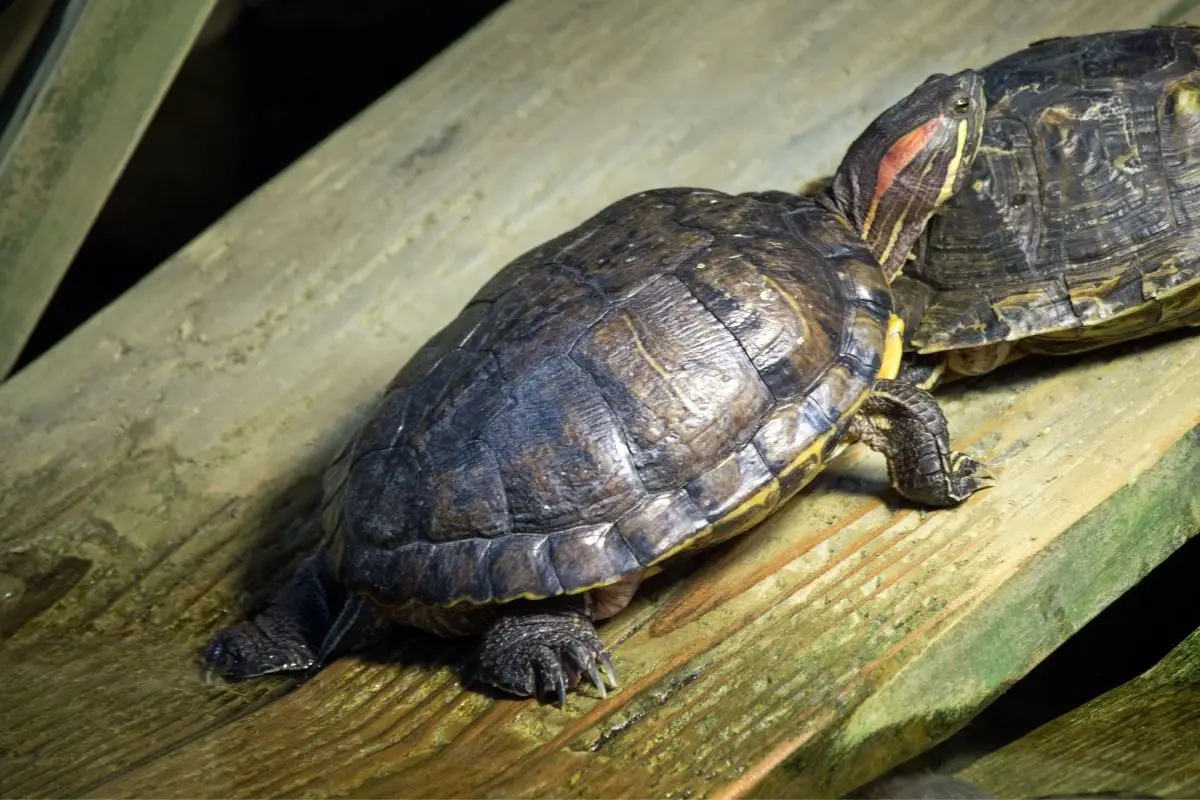
We have categorized them into different subsections to make it easier should you want to find one turtle in particular. Simply scroll to the type of turtle to find the one you’re looking for in a much quicker time.
Please enjoy our extensive list of 79 turtle species – from Box to Snapping, Cooters to chickens, and more!
Box Turtles
Box Turtle
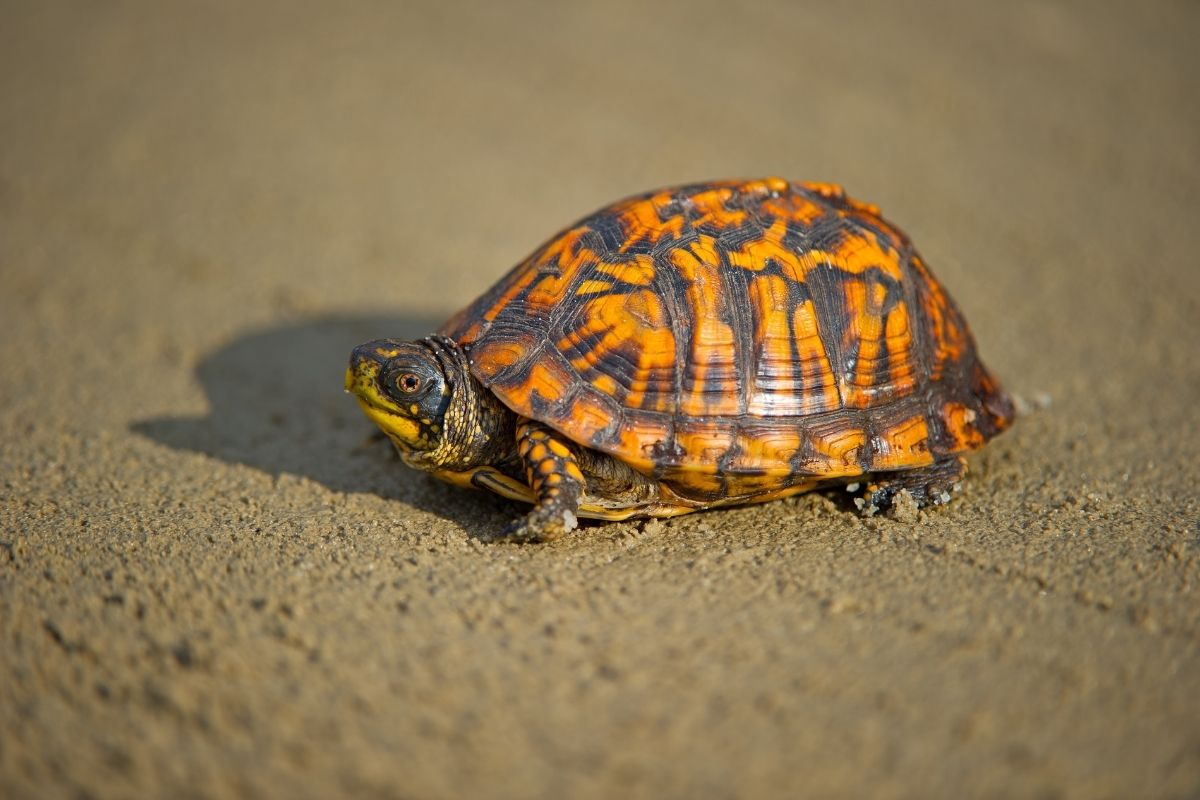
There are six main Box turtles in this category of Box Turtles, all of which are mainly semi-aquatic. Within these six categories there are then 12 subspecies of Box turtles.
All of these subspecies are slightly different, although many have a preference for temperate forests.
Box turtles prefer to be alone and are quickly agitated by new people and environments. The added stress from these pressures has meant that the Box turtles have mostly all become endangered.
Another fact about Box turtles is that they mostly all have dark brown or olive green shells, with amazing markings and patterns.
The colors for these markings are most commonly yellow or orange. These turtles are mostly all omnivores.
- Family Name: Emydidae
- Genus Name: Terrapene
- Binomial Name: Multiple Different
- Otherwise Known As: Multiple Different
- Aquatic? No, Terrestrial
- Maximum Size: Between 6 and 8 inches
- Average Lifespan: Between 50 and 100 years
Eastern Box Turtle
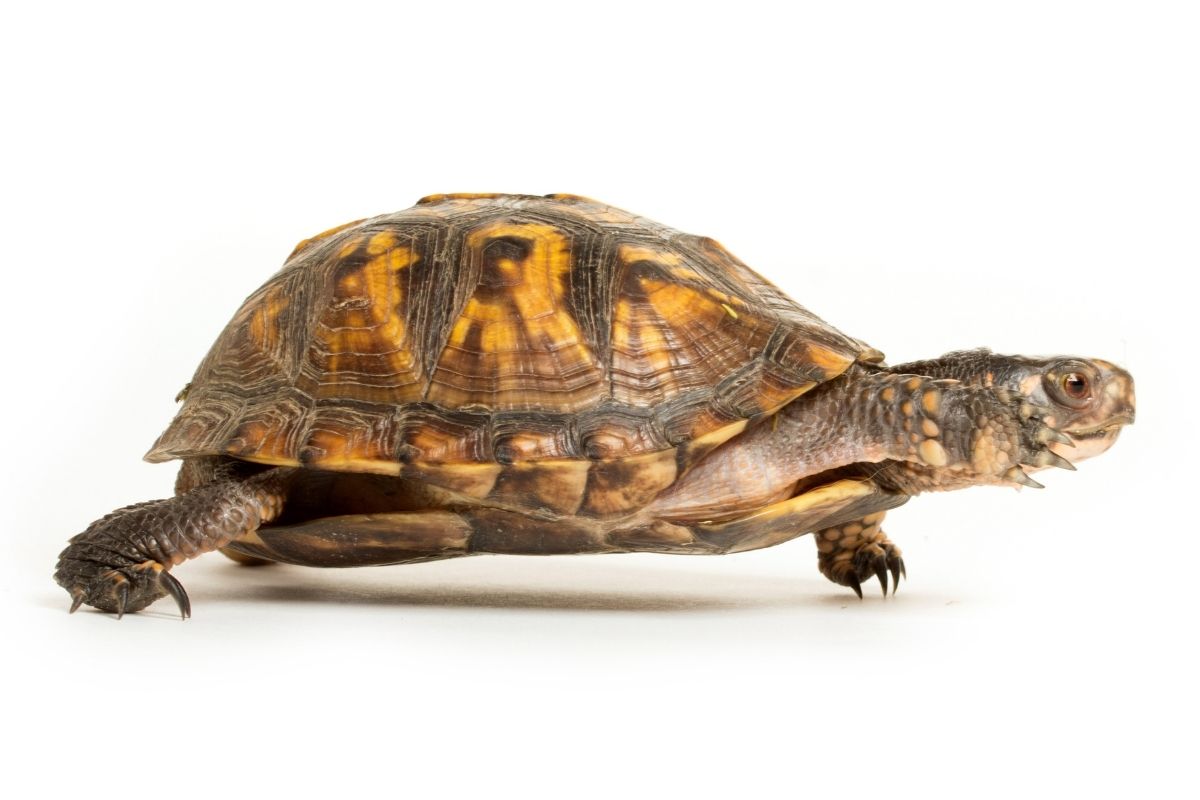
This species of turtle are very colorful and they are a subspecies of the Common Box turtle. They have very domed upper shells which are dark brown in color.
However, their colorfulness comes from their markings. These will be neon yellow and orange, so that you can point out an Eastern Box Turtle anywhere.
A fun fact about this turtle is that it can regenerate its shell should it be damaged. This allows them to spend more of their time on land without the risk of fatal shell injuries.
The Eastern Box Turtle is known to walk for up to 50 meters a day to find its food. It enjoys roaming along woodlands, grasslands, and marshes within the central and eastern USA. However, you will almost always find them close to a body of water.
This turtle is an omnivore and therefore will eat meat and plants whenever either becomes available to them.
- Family Name: Emydidae
- Genus Name: Terrapene
- Binomial Name: Terrapene Carolina Carolina
- Otherwise Known As: Land Turtle
- Aquatic? Semi-Aquatic
- Maximum Size: Between 4 and 7 inches
- Average Lifespan: 65 years
- Found In The Following States: Alabama, Connecticut, Delaware, Florida, Georgia, Illinois, Indiana, Kansas, Kentucky, Maine, Maryland, Massachusetts, Michigan, Mississippi, New Hampshire, New Jersey, New York, North Carolina, Ohio, Pennsylvania, Rhode Island, South Carolina, Tennessee, Virginia, West Virginia
Asian Box Turtle
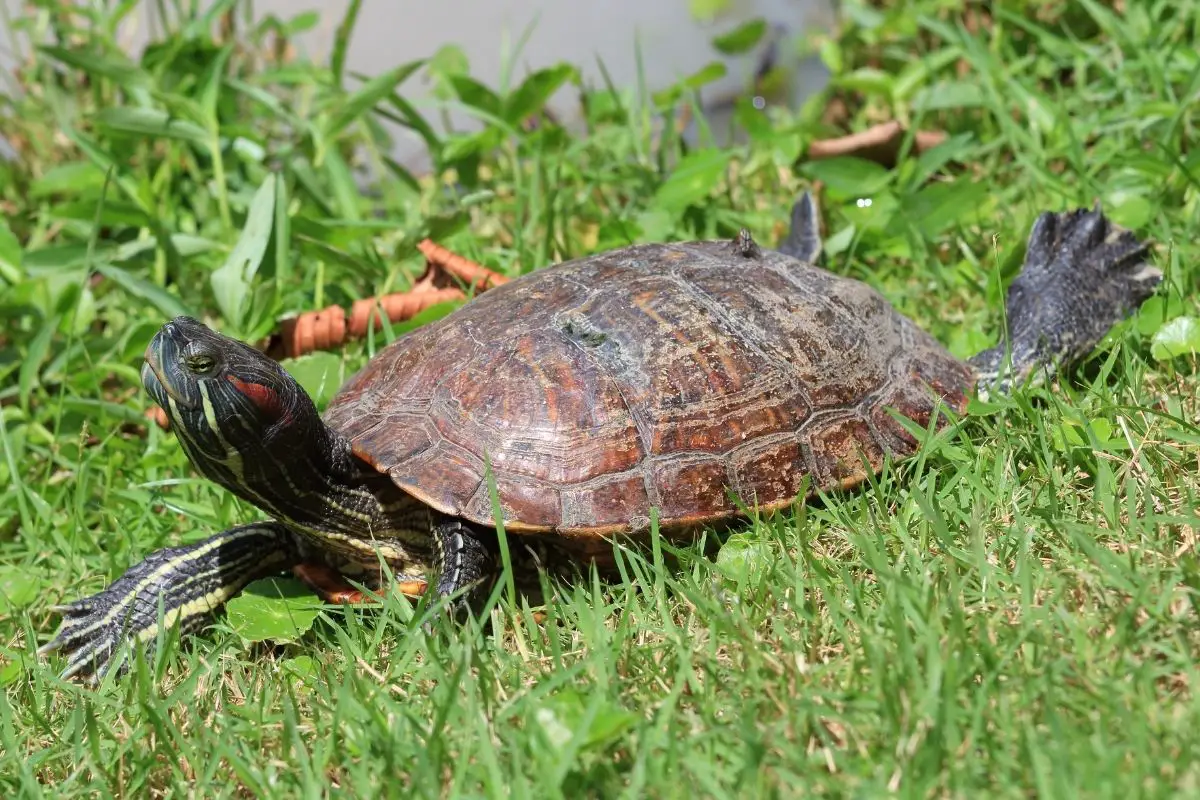
There are 12 types of Asian Box Turtles, which are subspecies of Box Turtles. These turtles are native to Indonesia, China, the Philippines, and some parts of India.
From the Cuora genus, Asian Box turtles are mainly colored dark brown or black. Their shells are domed with three keels which make it very easy to distinguish between other turtles.
These keels will often feature a brightly colored stripe running down them, such as yellow, white, or orange.
These turtles are mostly omnivores which means that they’ll be eating plant matter wherever possible, although they will eat meat sources too. They are also semi-aquatic, so they like to split their time between in the water and on land.
Sadly, the Asian Box Turtle is one of the most common subspecies to be trafficked around the world, both for pets and for food.
- Family Name: Geoemydidae
- Genus Name: Cuora
- Binomial Name: Multiple Different
- Otherwise Known As: Multiple Different
- Aquatic? Semi-Aquatic
- Maximum Size: 12 inches
- Average Lifespan: 100 years
Gulf Coast Box Turtle
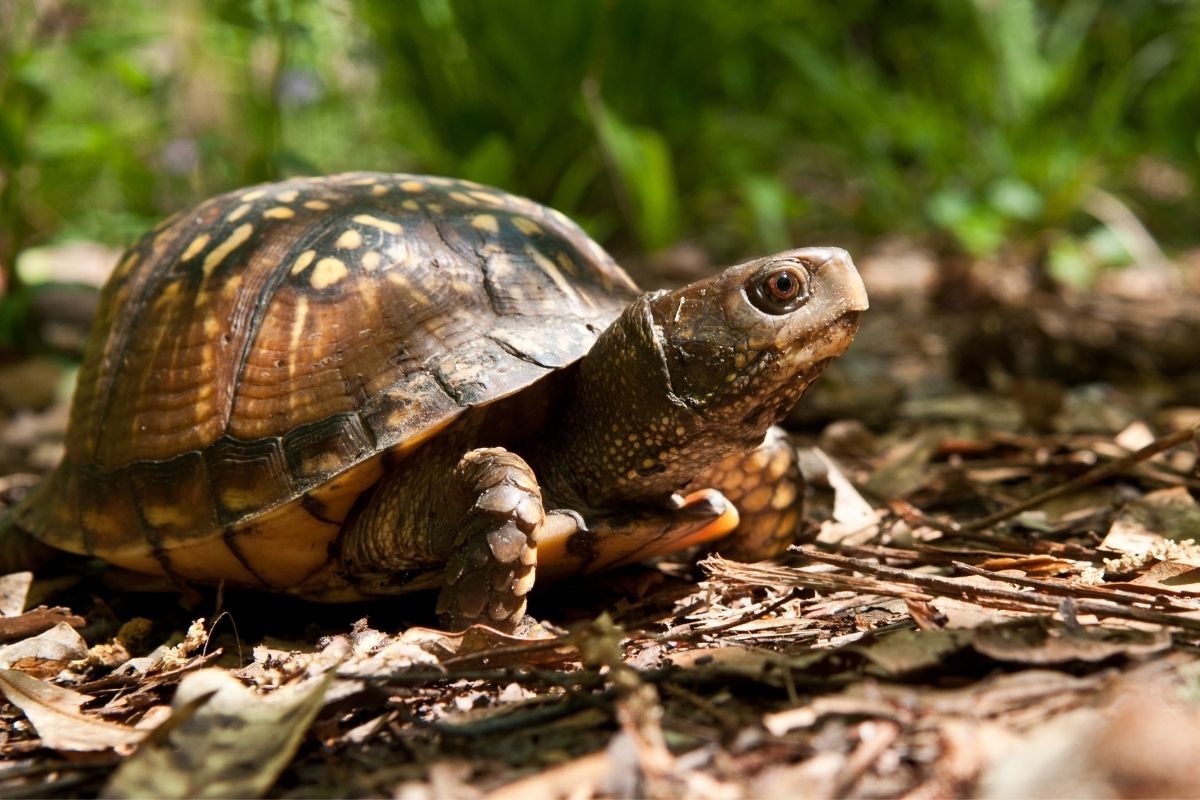
The Gulf Coast Box Turtle is often considered the largest of the Box turtles, as they can grow to be up to 8.5 inches long. Females might even be longer than this!
They are also very resilient, preferring brackish waters and swamps rather than freshwater sources.
Unsurprisingly, the Gulf Coast Box Turtle is found around the Gulf of Mexico. These turtles are semi-aquatic and therefore spend half of their time in water and half of their time on land.
They will also always look for warmer areas with lots of humidity to reside.
Their shells are dark brown to black with upturned edges. The shells will then be marked with yellow stripes or spots.
How strong and vibrant these markings are will depend on the individual turtle – some will be much harder to see than others.
Gulf Coast Box Turtles are omnivores and therefore eat both meat and plant matter. Their favorites are worms, mollusks, and insects.
- Family Name: Emydidae
- Genus Name: Terrapene
- Binomial Name: Terrapene Carolina Major
- Otherwise Known As: None Known
- Aquatic? Semi-Aquatic
- Maximum Size: Between 6 and 8.5 inches
- Lifespan: Between 30 and 40 years
- Found In The Following States: Florida and Georgia
Coahuilan Box Turtle
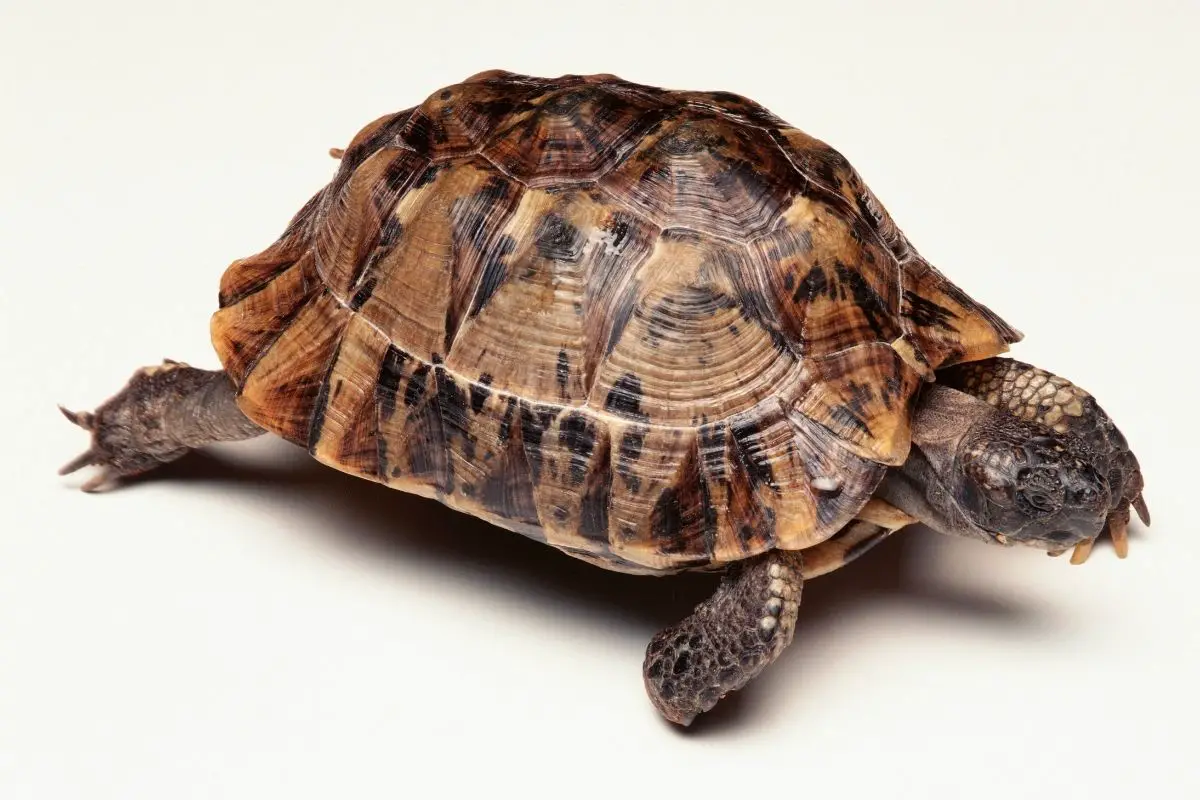
Out of all of the Box turtles, the Coahuilan Box Turtle is currently the most endangered and therefore at the highest risk of becoming extinct.
They can be found in the city of Cuatro Cienegas, as well as some surrounding areas, which are located in the Coahuila region of Mexico.
Due to these turtles being very confined to one area, once they are extinct from Mexico, there isn’t anywhere else in the world that they can be found.
Their shells will either be dark brown or black and they don’t have any markings to distinguish them from other turtles. They are almost exclusively aquatic, meaning that you will very rarely find them on land.
If you do see one on land, you might notice that their shells are covered in algae. This is due to how much time they spend in the water. They will remain in the desert springs of Cuatro Cienegas.
The Coahuilan Box Turtle is an opportunistic feeder, meaning that they will eat whatever is available without being fussy.
- Family Name: Emydidae
- Genus Name: Terrapene
- Binomial Name: Terrapene Coahuila
- Otherwise Known As: Aquatic Box Turtle
- Aquatic? Yes
- Maximum Size: Between 3 and 6 inches
- Average Lifespan: 65 years
Ornate Box Turtle
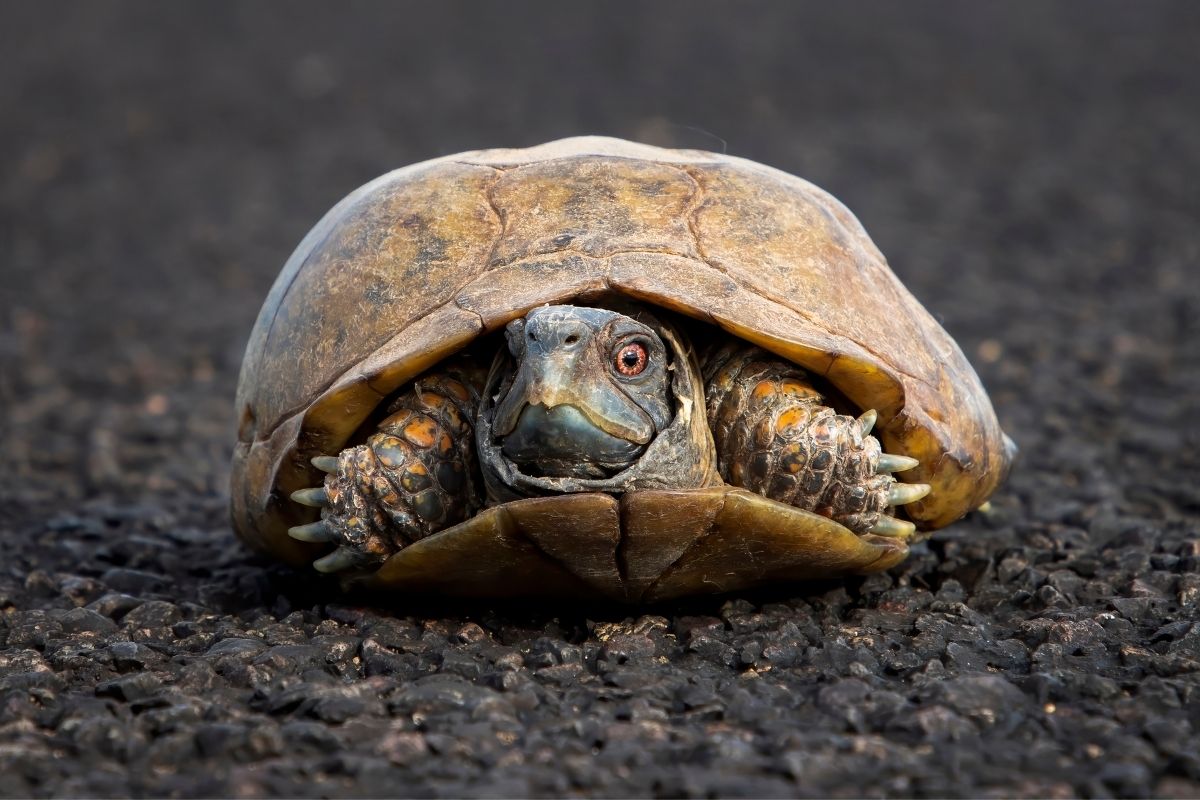
Another box turtle with an amazingly colorful shell, the Ornate Box Turtle is certainly a sight to behold. The pattern is made up of yellow and orange stripes which really stand out against their dark brown shells.
You can find the Ornate Box Turtle in many areas of the western and central USA, and it is even the state reptile for Kansas. Be weary if you do see one of these turtles, however, as they have been known to bite.
These turtles are very terrestrial and therefore can be seen on open land such as grasslands. They are particularly commonly seen in the Great Plains area.
The Ornate Box Turtle spends most of its days looking for food, which can be both meat and plant matter.
Ornate Box Turtles tend to keep to themselves and use up little space, but their population is still declining due to the pet trade and deforestation crisis.
- Family Name: Emydidae
- Genus Name: Terrapene
- Binomial Name: Terrapene Ornata Ornata
- Otherwise Known As: Western Box Turtle, Box Tortoise
- Aquatic? Semi-Aquatic
- Maximum Size: Between 4 and 5 inches
- Lifespan: Between 30 and 40 years
- Found In The Following States: Arizona, Arkansas, Colorado, Illinois, Indiana, Iowa, Kansas, Louisiana, Missouri, Nebraska, New Mexico, Oklahoma, South Dakota, Texas, Wisconsin, Wyoming
Chinese Box Turtle
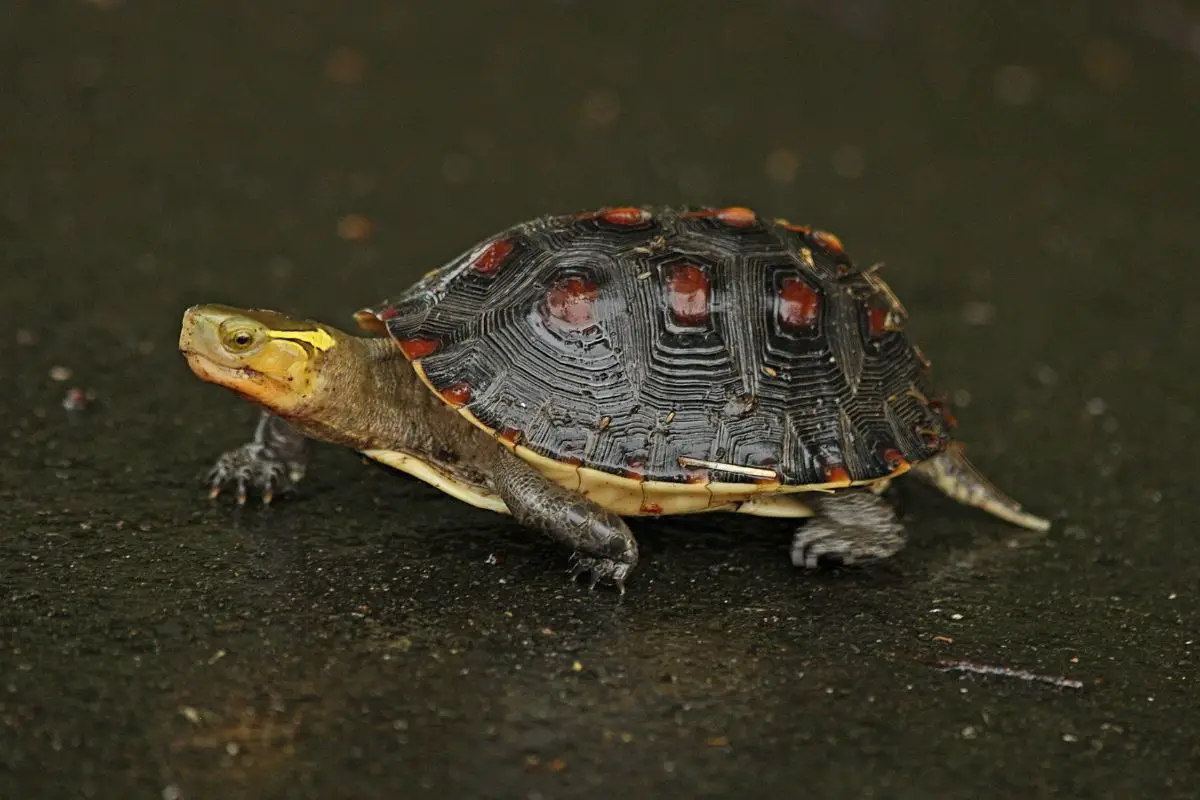
You will be able to find this turtle in central parts of China the easiest, although it can also be seen in some parts of Taiwan and Japan. These turtles are semi-aquatic so they can be found both on land and in water.
Chinese Box Turtles are easily distinguishable from other species thanks to their yellow lower shell and head. Their upper shells are very domed and dark-colored, making their yellow bellies much more distinguishable.
These turtles are omnivores so they’ll eat both plants and meat. Their favorite things to find are mollusks, worms, vegetables, and fruits.
They enjoy warm temperatures the best due to being native to subtropical climates, so much so that they typically bury themselves underground where the humidity is higher.
- Family Name: Geoemydidae
- Genus Name: Cuora
- Binomial Name: Cuora Flavomarginata
- Otherwise Known As: Yellow-margined Box Turtle, Golden-headed Turtle, Snake-eating Turtle
- Aquatic? Semi-Aquatic
- Maximum Size: Between 5.5 and 6.5 inches
- Average Lifespan: 100 years
Three-Toed Box Turtle
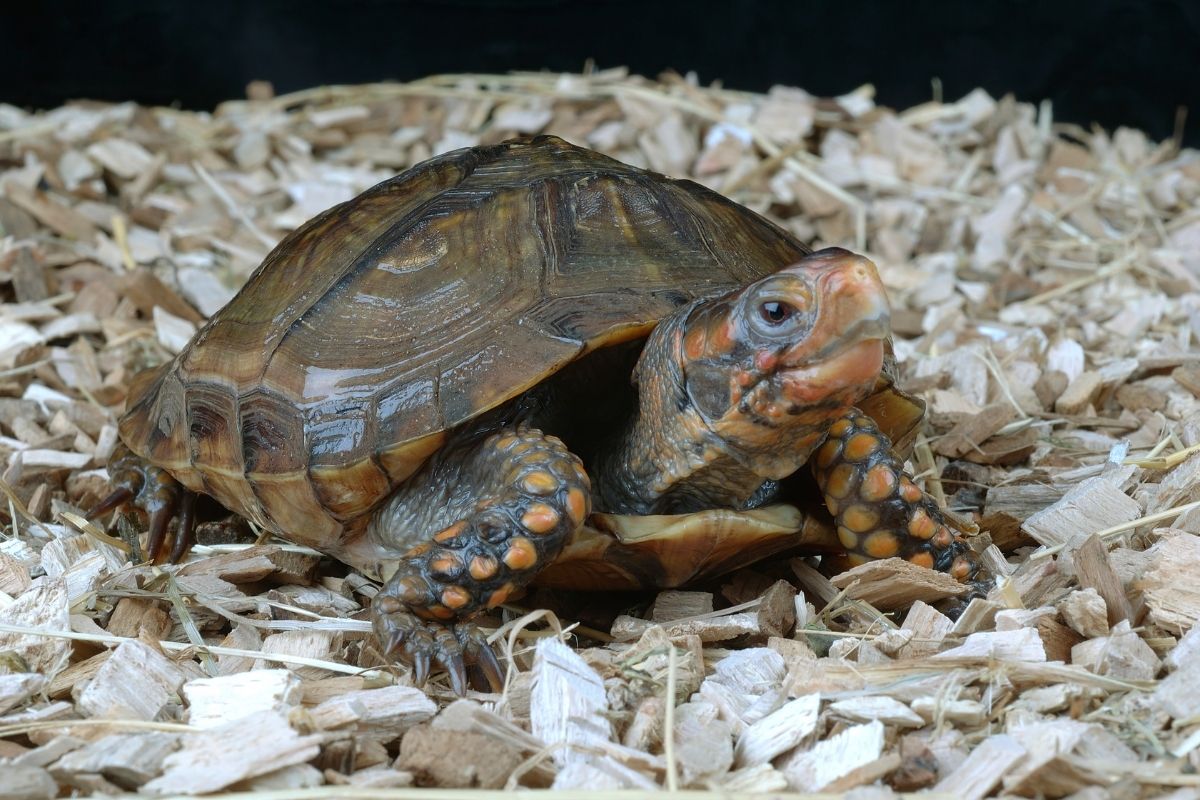
The Three-Toed Box Turtle is another member of the family Emydidae. This particular species has three toes instead of four like all other box turtles.
This turtle’s coloration is similar to that of the Chinese Box Turtle, and it is also smaller than the Chinese Box Turtle and lives in drier regions.
You can find this turtle in the central and southern regions of the USA. It also happens to be the state reptile for Missouri!
You will have more luck finding this turtle in grassy areas, but you can also find them in certain woodlands. They are very adaptable when it comes to their habitat.
This turtle eats mostly insects and spiders, but it will also eat small amounts of vegetation. They are omnivores and therefore not too fussy about their meals.
Their shells are either olive green or brown. Their underbellies are yellow and they have three toes rather than four on their hind legs.
- Family Name: Emydidae
- Genus Name: Terrapene
- Binomial Name: Terrapene Carolina Triunguis
- Otherwise Known As: Box Turtle
- Aquatic? Semi-Aquatic
- Maximum Size: Between 4 and 5 inches
- Average Lifespan: Between 30 and 40 years
- Found In The Following States: Arkansas, Florida, Georgia, Louisiana, Mississippi, Missouri, Oklahoma, Tennessee, Texas
Desert Box Turtle
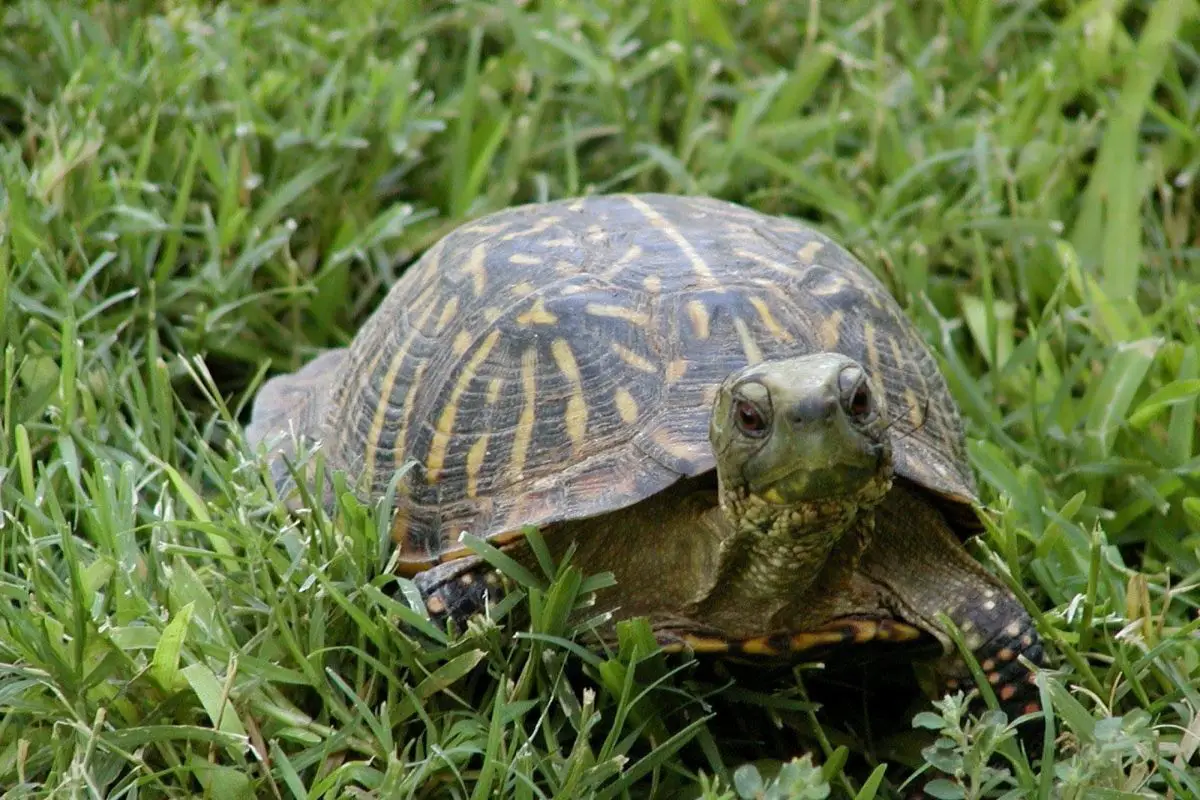
This is a subspecies of the Box turtle that has been able to adapt to living in more open habitats, such as the desert – hence the name. You will only be able to find the Desert Box Turtle in the south west of the USA, as well as some northern regions of Mexico.
The Desert Box Turtle spends half of its time on land and half in the water. Their domed shells can either be brown or brown with a red tint to it.
Their markings are thinner than those of an Ornate Box Turtle, but otherwise they are similar.
These turtles are omnivores and will therefore eat anything that comes along. Cacti, fruit, grasshoppers, and plants are some of their favorite snacks.
- Family Name: Emydidae
- Genus Name: Terrapene
- Binomial Name: Terrapene Ornata Luteola
- Otherwise Known As: Sonoran Box Turtle
- Aquatic? Semi-Aquatic
- Maximum Size: Between 4 and 5 inches
- Average Lifespan: Between 30 and 40 years
Malaysian Box Turtle
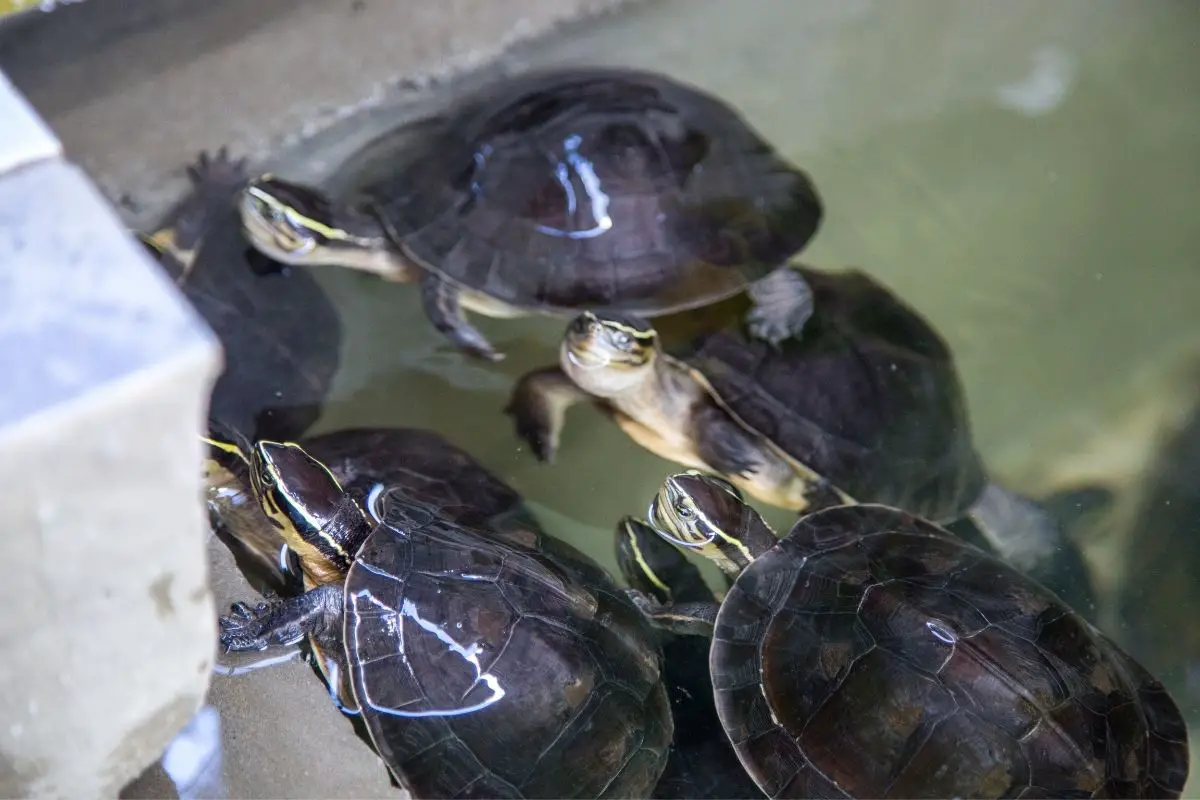
This turtle is a subspecies of the Southeast Asian Box Turtle, which also often goes by the name Amboina Box turtle.
You can find this turtle in many areas of Indochina, such as Malaysia (as the name suggests), Thailand, Singapore, and Vietnam.
You can characterize this turtle with a dark brown shell dotted with a few black spots all over it. This differs from other Southeast Asian Box turtles that do not have this same pattern.
Another difference between the Malaysian Box Turtle and other box turtles is that the former has a shorter tail.
The Malaysian Box Turtle’s favorite weather is that of a tropical climate, with warm water and lots of humidity in the air. With that being said, it is not uncommon for this turtle to live in extreme conditions.
This turtle is an omnivore with a preference for plant matter over meat sources. Unfortunately, the Malaysian Box Turtle is still on the endangered list due to turtle trafficking.
- Family Name: Geoemydidae
- Genus Name: Cuora
- Binomial Name: Cuora Amboinensis Kamaroma
- Otherwise Known As: Southeast Asian Box Turtle, Amboina Box Turtle
- Aquatic? Semi-Aquatic
- Maximum Size: 8 inches
- Average Lifespan: 35 years
Chicken Turtles
Chicken Turtle
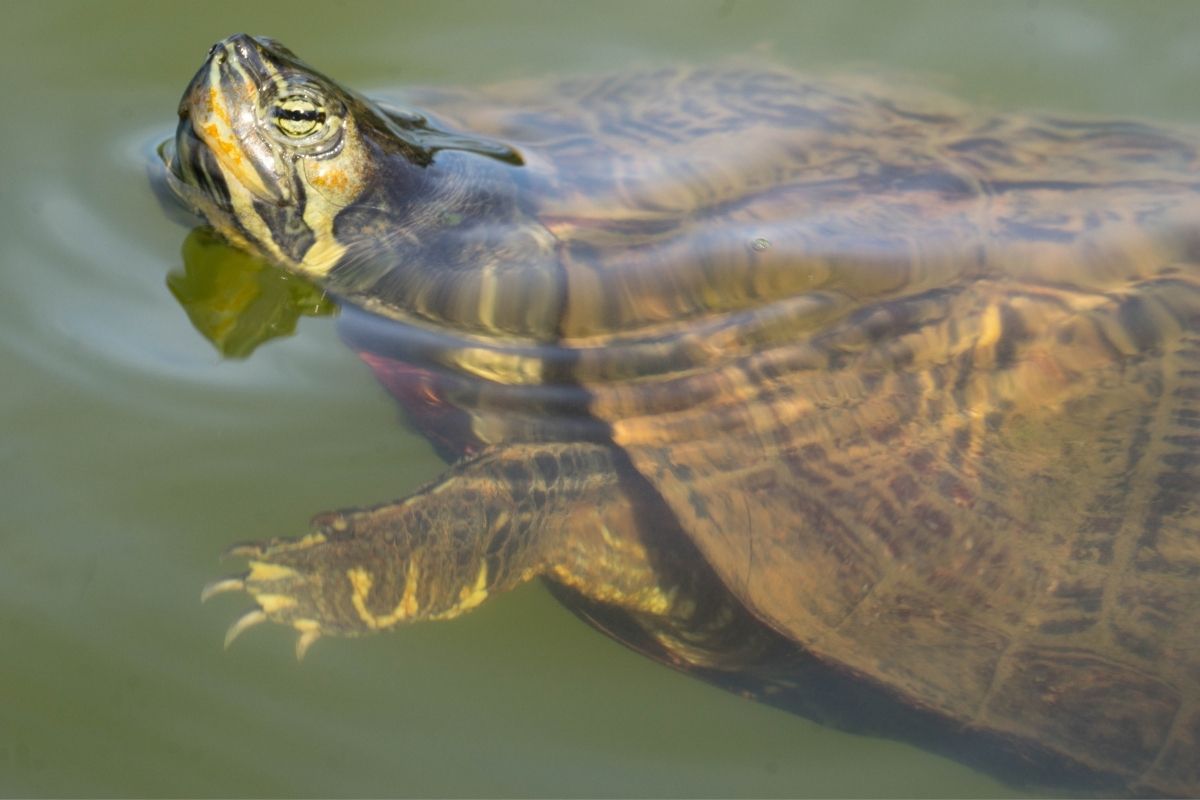
There are two Chicken Turtle species that can be found in the USA – the Eastern Chicken Turtle and the Western Chicken Turtle.
Both species are incredibly similar, which is why we have put them both under one category.
You might be confused as to why Chicken Turtles have received such a strange name – rather morbidly, it is due to how their flesh tastes.
Chicken Turtles used to be a popular food in the south US, so many people knew that they tasted like chicken.
Both the Eastern and Western Chicken Turtles have long necks with stripes around them. Both of their shells are oval, with brown or olive green coloring with yellow patterns. The patterns look like that of a net.
As you can see, both types of Chicken Turtle are very similar in look and personality.
These turtles are omnivores although they tend to prefer meat and insects over plant matter. They can often be found hunting in very compacted vegetation.
- Family Name: Emydidae
- Genus Name: Deirochelys
- Binomial Name: Eastern Chicken Turtle: Deirochelys Reticularia Reticularia, Western Chicken Turtle: Deirochelys Reticularia Miaria
- Otherwise Known As: American Snake-necked Turtle
- Aquatic? Semi-Aquatic
- Maximum Size: 10 inches
- Average Lifespan: Between 15 and 20 years
- Found In The Following States: Alabama, Arkansas, Florida, Georgia, Louisiana, Mississippi, Missouri, North Carolina, Oklahoma, South Carolina, Texas, Virginia
Pond Turtles, Cooters, And Sliders
Eastern River Cooter
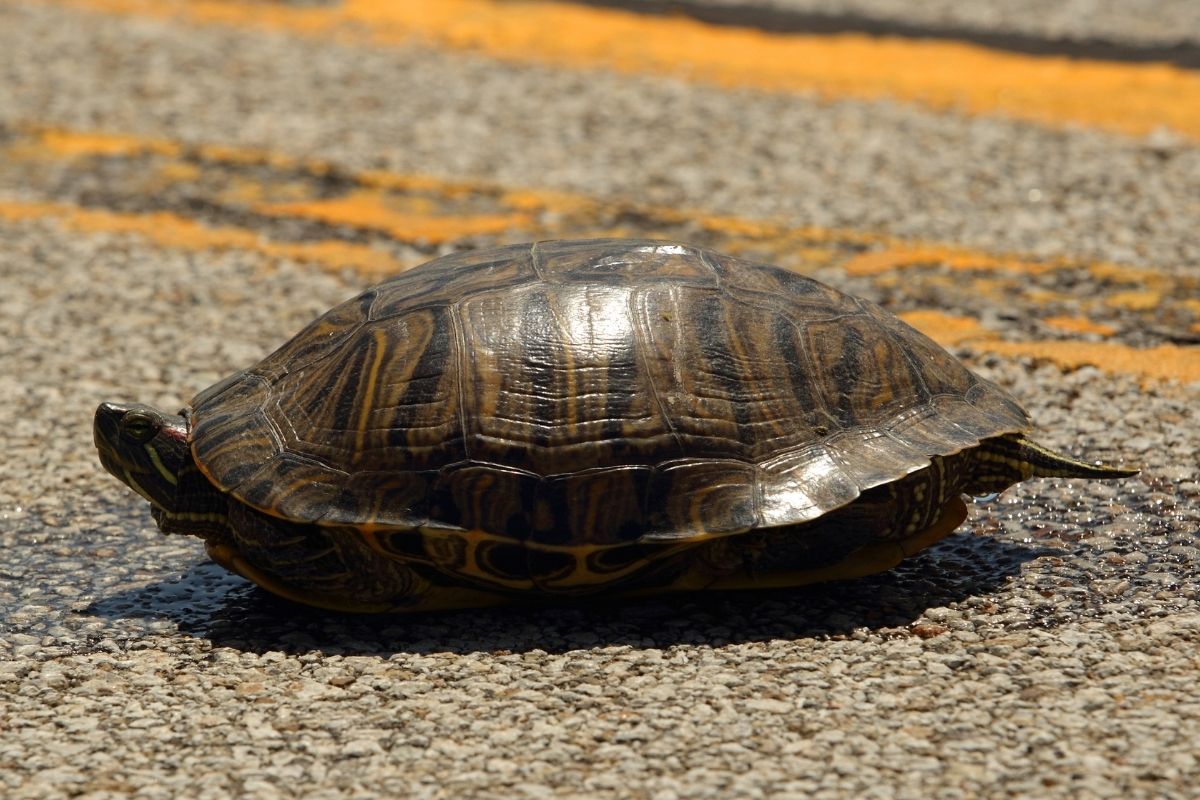
The Eastern Cooter is a freshwater turtle that enjoys spending time both in the water and on land. It is most commonly found in Eastern and Midwest areas of the USA, and many people find them sunbathing on rocks or fallen trees nearby water.
They prefer fast-moving water, such as streams and rivers, but they might still be found in stagnant waters if that’s all that’s available.
Eastern River Cooters have flatter shells than a ‘normal’ turtle shell, and they will be either olive green or brown. Both their skin and shells have yellow patterns on them, and their lower shell is also completely yellow.
Eastern River Cooters do not eat meat as they are herbivores. They eat mainly plant matter from the water floor, as well as plants around their chosen water source. They also enjoy fruits and vegetables.
- Family Name: Emydidae
- Genus Name: Pseudemys
- Binomial Name: Pseudemys Concinna Concinna
- Otherwise Known As: Not Known
- Aquatic? Aquatic
- Maximum Size: Between 8 and 12 inches
- Average Lifespan: Between 20 and 40 years
- Found In The Following States: Alabama, Arkansas, Florida, Georgia, Illinois, Indiana, Kansas, Kentucky, Louisiana, Missouri, North Carolina, South Carolina, Tennessee, Virginia, West Virginia
Reeves Turtle
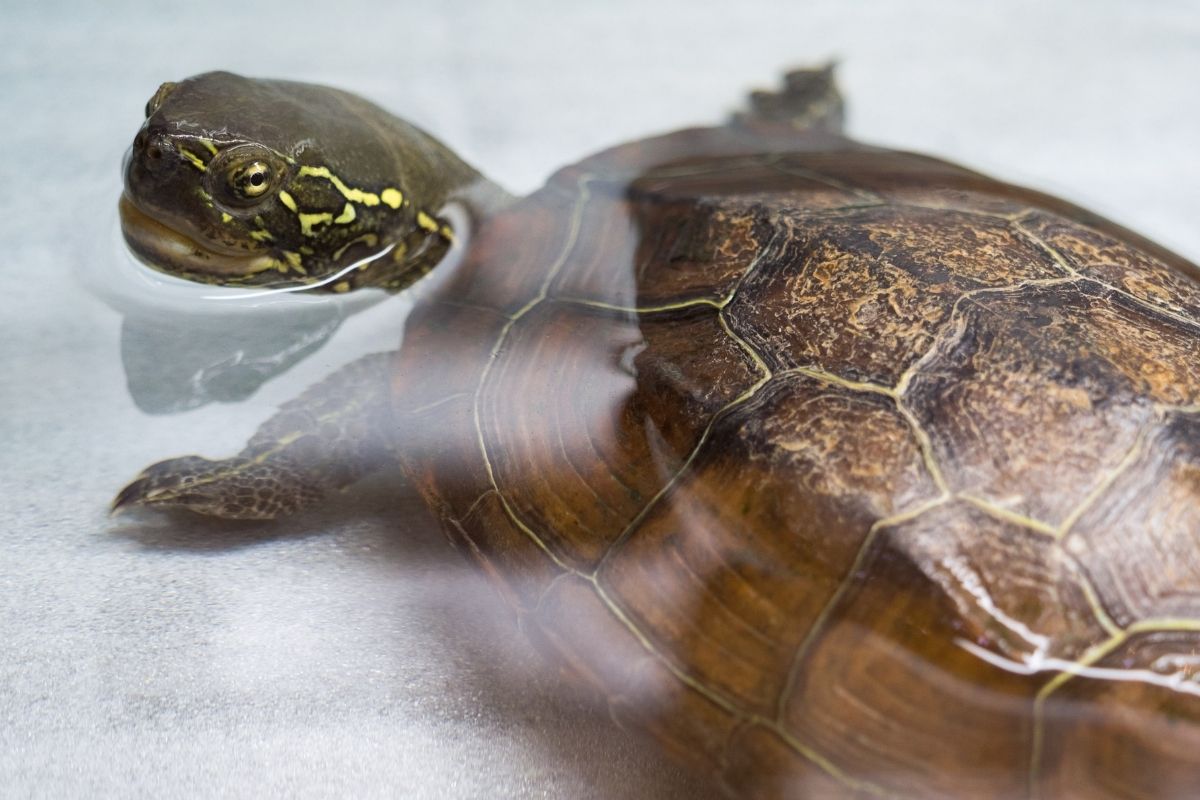
The Reeves Turtle is otherwise known as the Chinese Pond Turtle. This turtle is native to China, Japan and Korea, where it is considered an endangered species. It was renamed after English naturalist John Reeves.
Reeves Turtles are very small, only reaching about 6 to 9 inches in length. Their shells are mostly dark green or olive, with some yellow spots on them. They have yellow bellies as well.
These turtles are unfortunately endangered due to deforestation causing loss of habitat. Another grave issue is the pet trade and Chinese doctors using their flesh for traditional medicine techniques.
- Family Name: Geoemydidae
- Genus Name: Mauremys
- Binomial Name: Mauremys Reevesii
- Otherwise Known As: Chinese Three-keeled Pond Turtle, Chinese Pond Turtle
- Aquatic? Semi-Aquatic
- Maximum Size: Between 6 and 9 inches
- Average Lifespan: Between 10 and 20 years
Western Pond Turtle

The Western Pond Turtle is a semi-aquatic species that spends its days out of the water resting on logs or other submerged objects.
This turtle has a flat, oval-shaped shell which is usually dark gray or olive green in color. Their skin is brown with a few light spots, and their shells are also dotted with cream-colored flecks.
Western Pond Turtles are omnivorous, eating mostly fish, amphibians, crustaceans, mollusks, worms, insect larvae, snails, and algae.
They may even eat some small mammals like frogs and mice. They prefer brackish water and prefer to keep to themselves rather than socialize with humans or other animals.
- Family Name: Emydidae
- Genus Name: Actinemys
- Binomial Name: Actinemys marmorata
- Otherwise Known As: Pacific Pond Turtle
- Aquatic? Aquatic
- Maximum Size: Between 4 and 8 inches
- Average Lifespan: Between 40 and 50 years
- Found In The Following States: California, Nevada, Oregon, Washington
Cumberland Slider
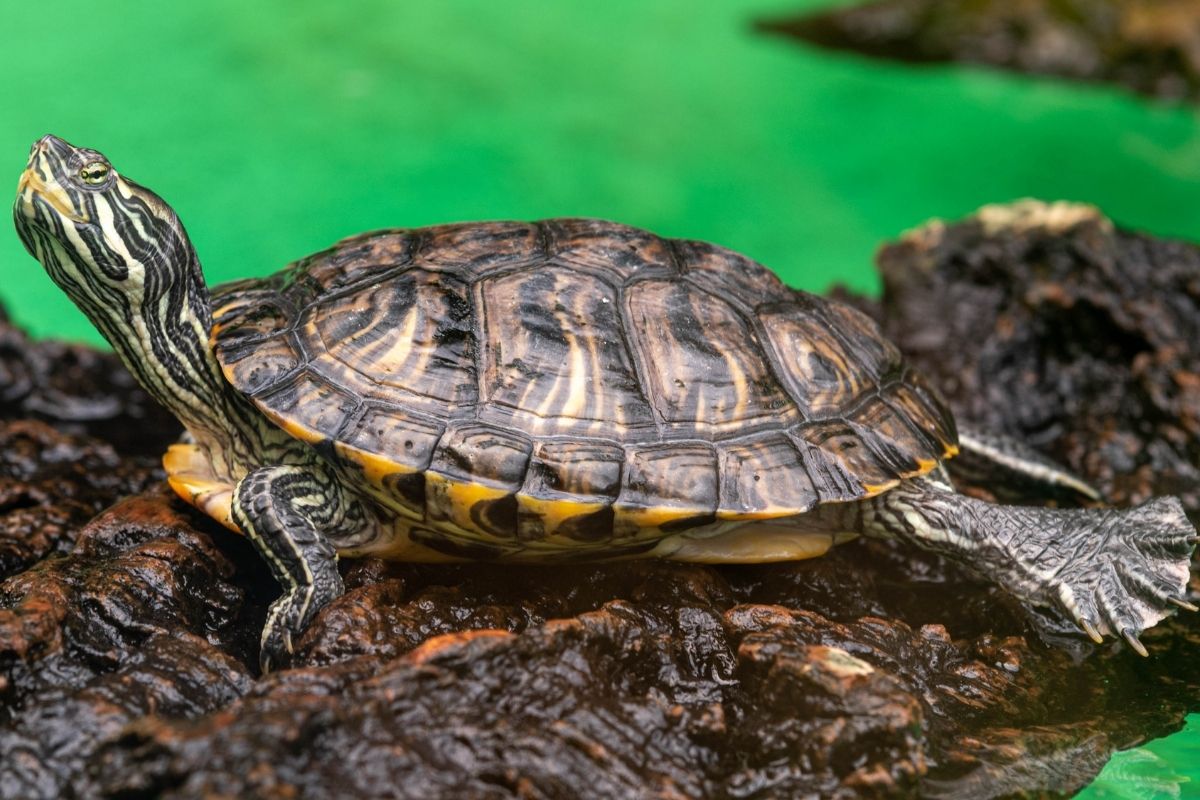
The Cumberland Slider is a near relative of both the Red-eared and the Yellow-bellied Sliders, and it is commonly found in the south-east of the USA.
These turtles mainly reside in the Cumberland River and its many drainages, hence the name.
They enjoy stagnant or slow-moving water with a soft bottom such as mud, sand, or lots of plant matter. You can sometimes spot them lounging in the sun in large groups of them.
Their diet consists primarily of aquatic insects, but they will also eat plants and animal material if necessary. They can be identified by their large size, their black eyes, and their long tail.
The Cumberland Slider’s shell is either brown or olive with distinct yellow markings on it. They have quite plain shells compared to other Sliders, so they can be difficult to correctly identify.
- Family Name: Emydidae
- Genus Name: Trachemys
- Binomial Name: Trachemys Scripta Troostii
- Otherwise Known As: Troost’s Turtle, Cumberland Turtle
- Aquatic? Semi-Aquatic
- Maximum Size: Between 7 and 11 inches
- Average Lifespan: 50 years
- Found In The Following States: Georgia, Tennessee, and Virginia
Florida River Cooter
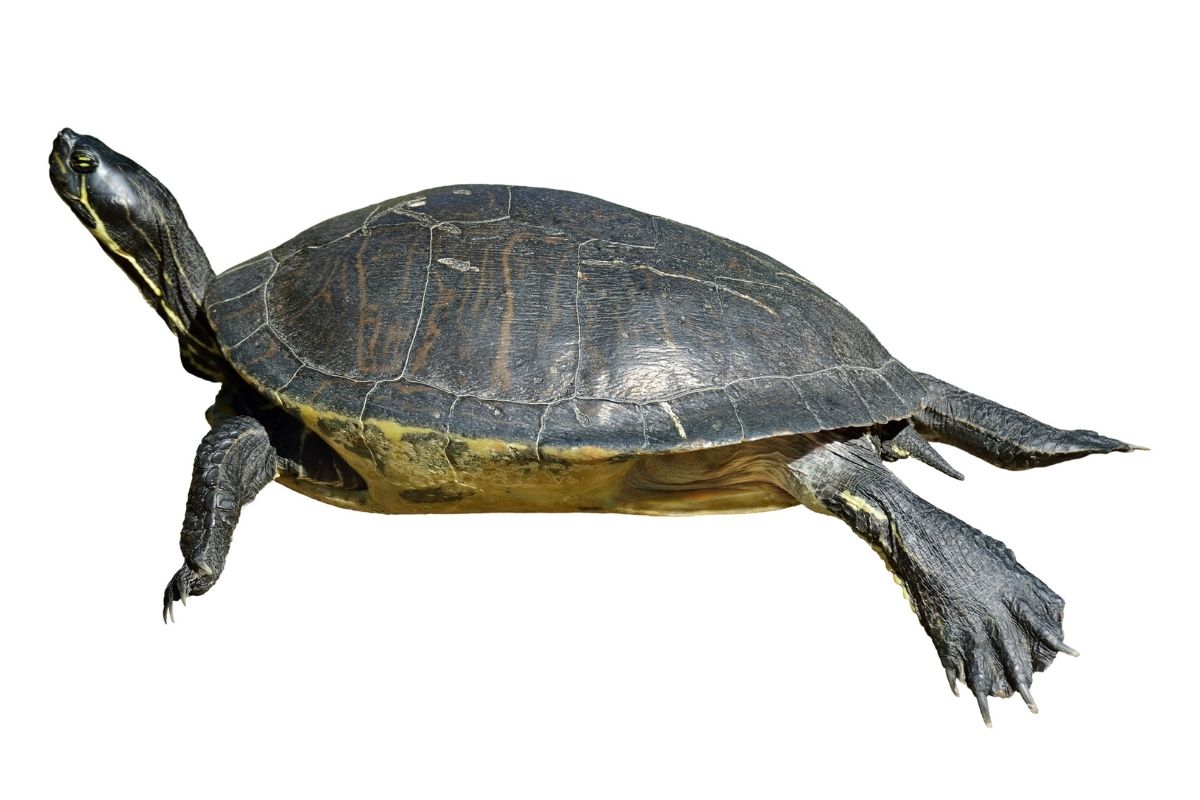
This turtle is a subspecies of the Common Cooter, and it is confined to Florida and some areas of Georgia. The main distinction of these turtles is their red bellies, but keep in mind that this color fades as the turtle gets older.
There are also yellow lines running along their skin underneath their brown shells. Overall, this is one of the more obvious turtles to find and correctly identify.
These turtles are seen in lots of different bodies of water in both Florida and Georgia. They are herbivores, so they’ll predominantly eat a plant-based diet. They enjoy algae and vegetation from under the water the most.
- Family Name: Emydidae
- Genus Name: Pseudemys
- Binomial Name: Pseudemys Nelsoni
- Otherwise Known As: Florida Red-bellied Turtle
- Aquatic? Aquatic
- Maximum Size: Between 8 and 15 inches
- Average Lifespan: 40 years
- Found In The Following States: Georgia and Florida
Nicaraguan Slider
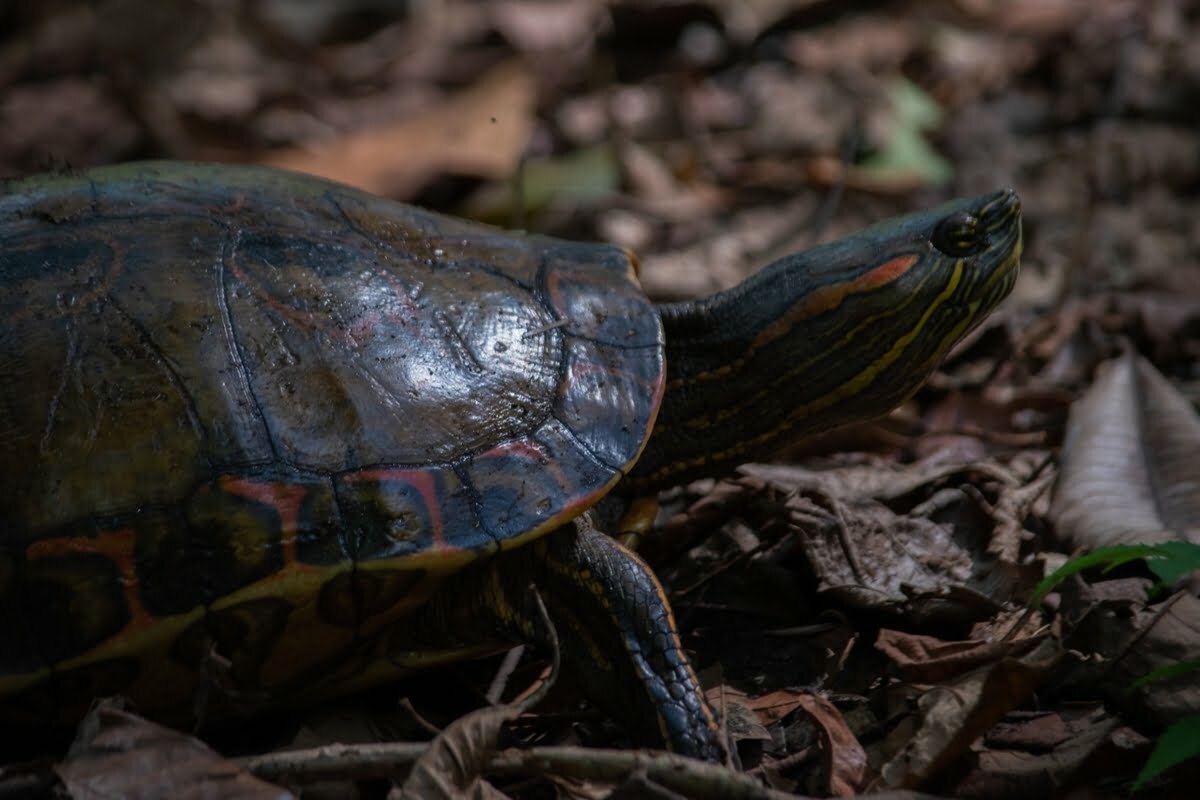
You can find this turtle in both Costa Rica and Nicaragua in South America. They mainly reside in streams and lakes as they enjoy the fast-movingx water.
The Nicaraguan slider has a very distinctive patterned shell which helps distinguish it from other sliders. It has lots of vibrant color all over its shell, from blue and green to yellow and red markings.
Unfortunately, the interesting shells of the Nicaraguan Slider make for good tourist items as they are often painted and sold to visitors.
These sliders enjoy living alone in the wild, so it is a shame that the pet trade has to ruin this.
- Family Name: Emydidae
- Genus Name: Trachemys
- Binomial Name: Trachemys emolli
- Otherwise Known As: Peacock Slider
- Aquatic? Aquatic
- Maximum Size: Between 10 and 15 inches
- Average Lifespan: 20 to 30 years
Golden Thread Turtle
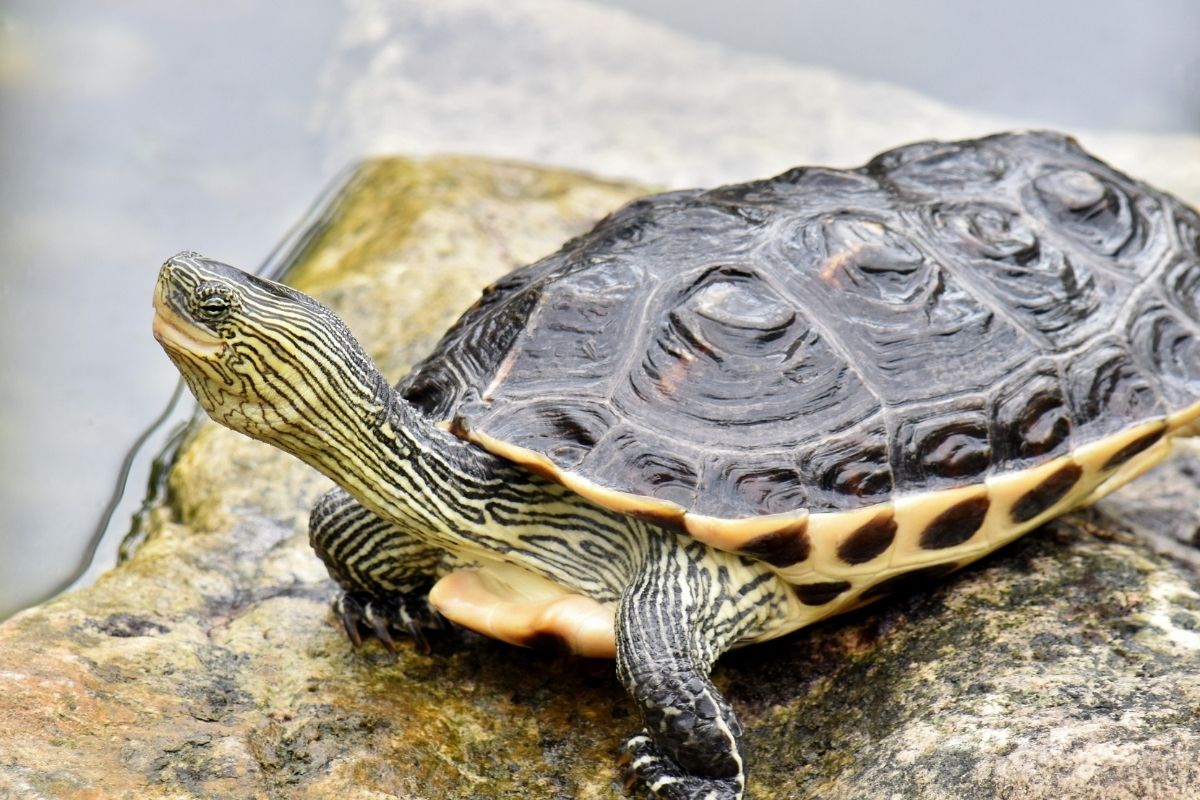
The Golden Thread Turtle is found in certain areas of Asia such as China, Taiwan, Laos, and Vietnam. This species is endangered due to the pet trade and hunters.
They enjoy residing in slow moving waters and eating an omnivorous diet. The older this turtle gets, however, the more they will favor plant matter over meat.
They have a long tail, and their shells are covered in tiny golden threads. These turtles can be found in many different types of habitats including rivers, lakes, ponds, and swamps.
They have shells of a brown coloring with three ridges running along it. As the turtle matures, however, two of these begin to disappear.
- Family Name: Geoemydidae
- Genus Name: Mauremys
- Binomial Name: Mauremys Sinensis
- Otherwise Known As: Chinese Stripe-necked Turtle
- Aquatic? Semi-Aquatic
- Maximum Size: Between 6 and 12 inches
- Average Lifespan: 60 years
Red-Eared Slider
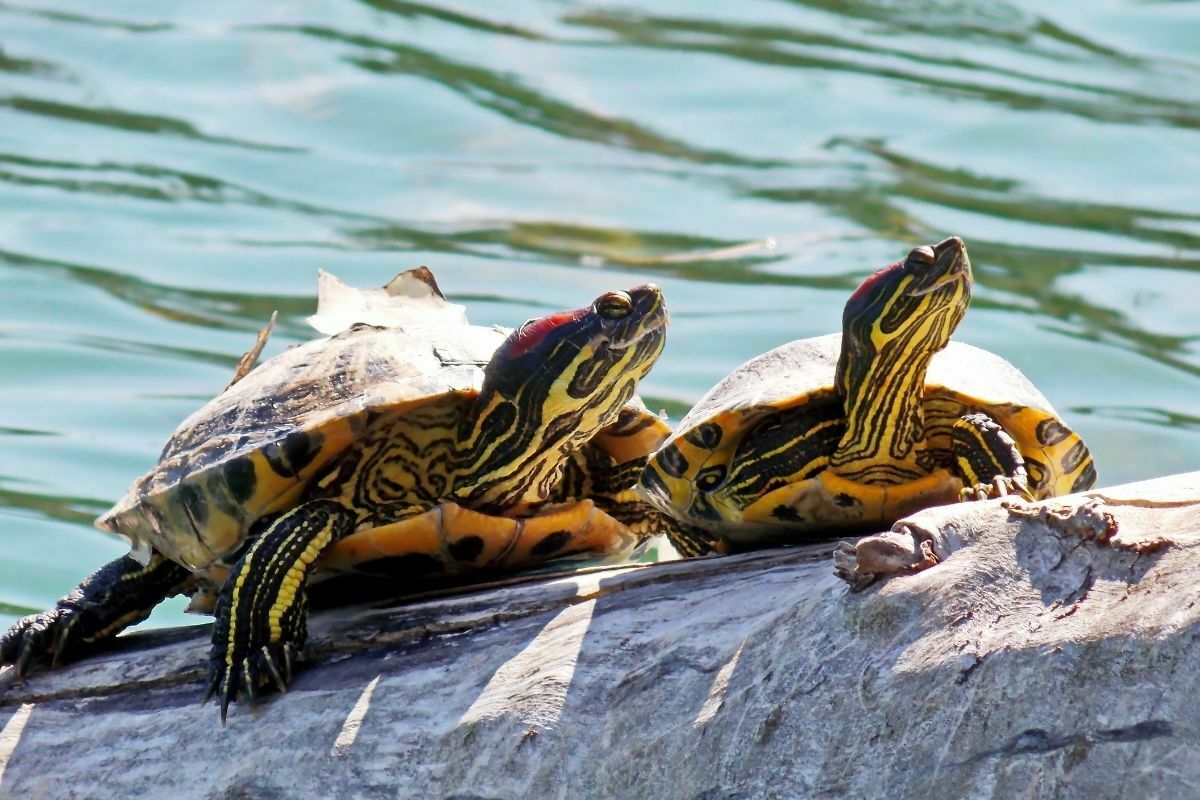
This turtle is native to Mexico, Central America, and South America, although it can actually be found in many states. They are semi-aquatic and feed on aquatic plants and insects.
They are commonly found in freshwater environments, although they do live in saltwater too.
Their name comes from their bright red ear lobes. Their shell is olive green with yellow markings all over it. Their heads will be a darker green with yellow and red patterns along it.
Red-eared Sliders are considered to be an invasive species due to the sheer volume of them that are released unsafely from captivity. This can be put down to the Red-eared Slider being one of the most popular turtles in the pet trade.
When people get bored of their pet, they release them into the wild. This has become such an issue that now people are blaming the turtles rather than the people unsafely releasing them into the wild to die.
- Family Name: Emydidae
- Genus Name: Trachemys
- Binomial Name: Trachemys Scripta Elegans
- Otherwise Known As: Water Slider, Red-eared Terrapin
- Aquatic? Semi-Aquatic
- Maximum Size: Between 6 and 10 inches
- Average Lifespan: 30 years
- Found In The Following States: Alabama, Arizona, Arkansas, California, Delaware, Florida, Georgia, Hawaii, Illinois, Indiana, Iowa, Kansas, Kentucky, Louisiana, Maryland, Massachusetts, Michigan, Minnesota, Mississippi, Missouri, Nebraska, Nevada, New Jersey, New Mexico, North Carolina, Ohio, Oklahoma, Oregon, Tennessee, Texas, Virginia, Washington, West Virginia, Wyoming
Peninsula Cooter
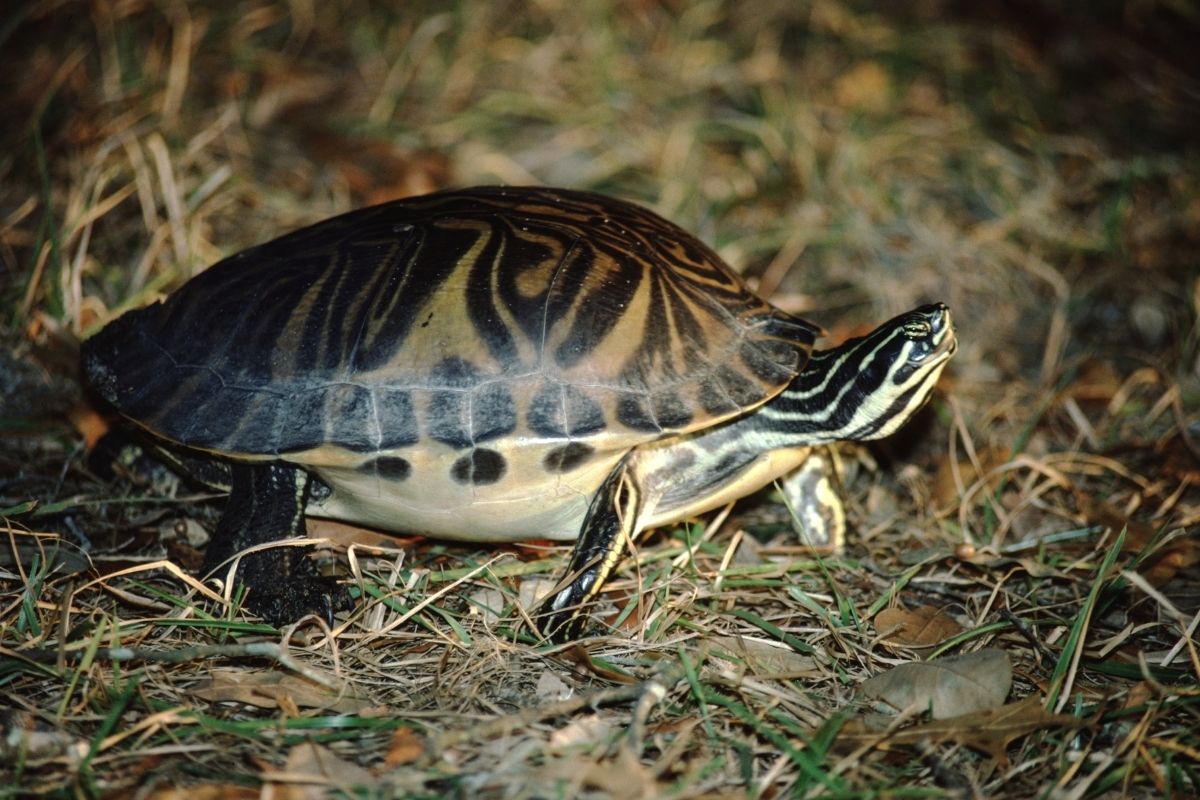
This turtle is a close cousin of the Florida Cooter, and can only be found in Florida Peninsular. You will have the best luck finding them in water, as they are aquatic animals.
The lower shell will be a yellow color and their skin is also covered in yellow lines, making it easy to identify when you see it.
The Peninsula Cooter is a herbivore and therefore thrives on plant matter over meat sources of food. If you want to feed one of these turtles, make sure that you bring some fruit or vegetables rather than any fish.
- Family Name: Emydidae
- Genus Name: Pseudemys
- Binomial Name: Pseudemys Peninsularis
- Otherwise Known As: Not Known
- Aquatic? Aquatic
- Maximum Size: Between 9 and 13 inches
- Average Lifespan: 30 years
- Found In The Following States: Florida
Yellow-Bellied Slider
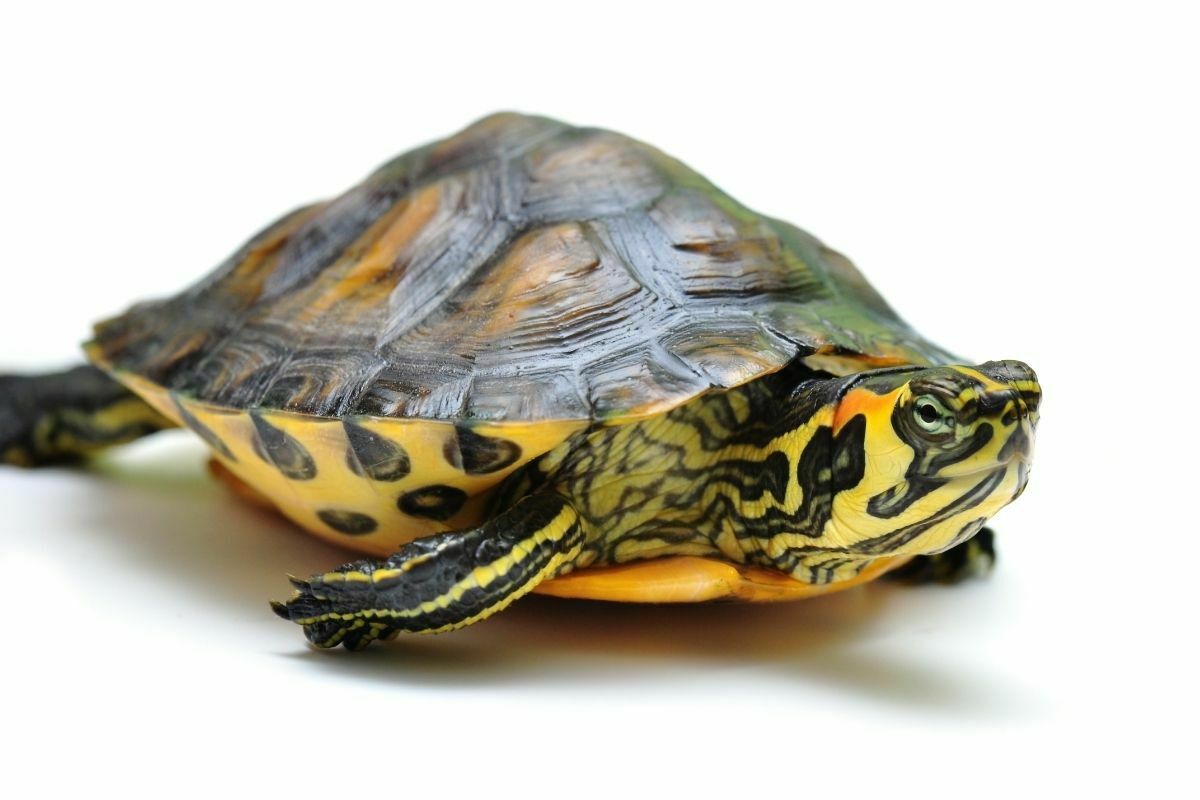
This turtle lives in the United States, with them remaining mainly in the south east. They enjoy wetlands as their habitats such as rivers, streams, and lakes. However, they also reside on land while looking for food or a new home.
Yellow-bellied Sliders are omnivores, meaning that they eat both plant material and animal matter. When they find something edible, they’ll consume it whole.
Yellow-bellied Sliders have yellow lower shells, as their name suggests. They also have plenty of yellow markings on their skin and yellow rings around the black of their eyes. Around all of this yellow, their shells are dark brown or olive green.
- Family Name: Emydidae
- Genus Name: Trachemys
- Binomial Name: Trachemys Scripta Scripta
- Otherwise Known As: None Known
- Aquatic? Semi-Aquatic
- Maximum Size: Between 5 and 13 inches
- Average Lifespan: Over 25 years
- Found In The Following States: Alabama, Florida, Georgia, Kansas, Maryland, Mississippi, North Carolina, South Carolina, Tennessee, Virginia
Indian Tent Turtle
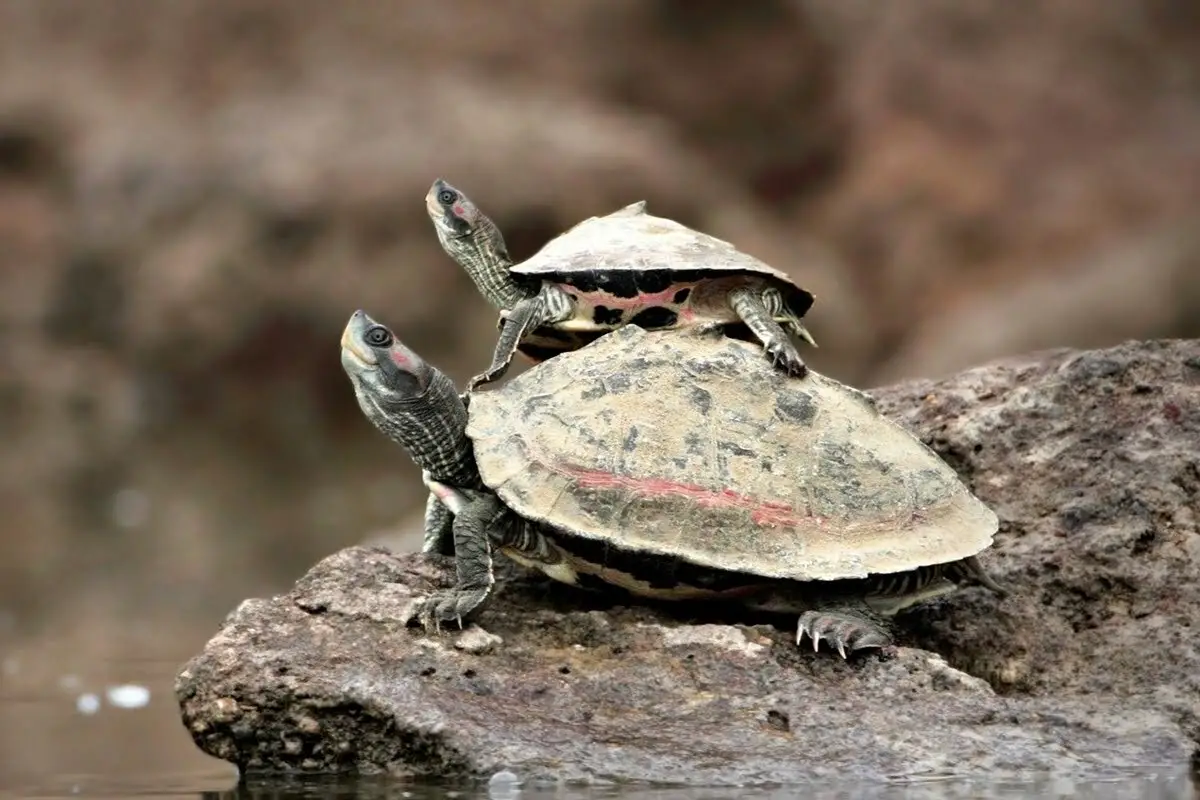
The Indian Tent Turtle is native to India and Sri Lanka. It is considered rare because of its small population size. It is mostly found in freshwater environments, but does sometimes venture into saltwater.
This turtle has a very unique appearance, having a large head and short legs. Its shell is light blue with a darker band across the middle.
Indian Tent Turtles are carnivorous animals. They prefer eating insects and other invertebrates. They are also known to eat fish and amphibians if they come across them.
- Family Name: Geoemydidae
- Genus Name: Pangshura
- Binomial Name: Pangshura Tentoria
- Otherwise Known As: Indian Pink-ringed Tent Turtle
- Aquatic? Semi-Aquatic
- Maximum Size: Between 3 and 9 inches
- Average Lifespan: Between 10 and 15 years
Arakan Forest Turtle
This species of turtle is one of the rarest to find and also the most endangered on the planet. They are native to Myanmar and Bangladesh, but otherwise not much else is known about this species of turtle.
They are nocturnal, making it incredibly difficult to find them. They are also omnivores and consume a diet of both meat and plant matter.
During the daytime, they hide under leaves to prevent anyone from spotting them. Their shells are light brown or gray with darker markings. Their legs are longer than the average for turtles and their claws are longer than the average.
Up until recently, it was believed that these turtles were extinct. It was only in 1994 that one was sighted and they were taken off of the extinct list. They now live within specific bamboo forests in their native countries.
- Family Name: Geoemydidae
- Genus Name: Heosemys
- Binomial Name: Heosemys Depressa
- Otherwise Known As: Arakan Turtle
- Aquatic? Semi-Terrestrial
- Maximum Size: 11 inches
- Average Lifespan: Not Known
European Pond Turtle
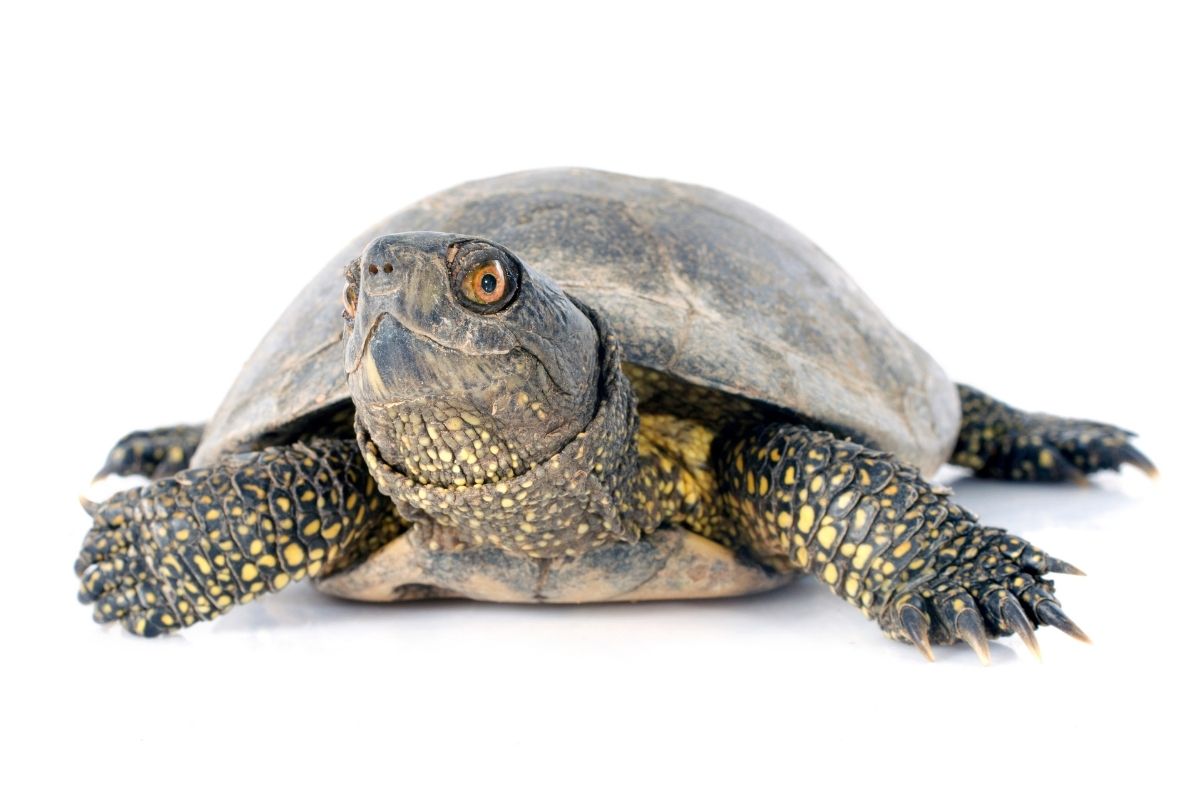
You can find the European Pond Turtle in many countries around Europe, North Africa, and the Mediterranean.
There are an impressive number of regional subspecies of these turtles – 14 have been recognized, to be exact.
These turtles enjoy wetlands that have sufficient cover from frees and other woodlands.
European Pond Turtles are semi-aquatic and therefore can travel both on land and through water to find food. Some have even traveled up to 2.5 miles a day to search for their next meal.
Their shells are dark brown to black with yellow markings around its circumference. European Pond Turtles are omnivores and therefore eat both meat and vegetation. As they mature, they might develop a preference for either meat or plant matter.
- Family Name: Emydidae
- Genus Name: Emys
- Binomial Name: Emys orbicularis
- Otherwise Known As: European Pond Tortoise, European Pond Terrapin
- Aquatic? Semi-Aquatic
- Maximum Size: Between 5 and 15 inches
- Average Lifespan: Between 40 and 60 years
Philippine Forest Turtle
These turtles are confined to the Philippine Islands, in particular Palawan. They are critically endangered and a lot is still to be uncovered about their species.
Their shells are dark in color with the front being shaped like a ginkgo leaf. Around their head runs a thin white line.
The Philippine Forest Turtle is perhaps the largest of the Geoemydidae turtle family found in the Philippines, making it one of the most sought after.
This turtle likes to live in swampy waters rather than freshwater, making it susceptible to loss of habitat.
They are also nocturnal and therefore very difficult to spot as they hide beneath rocks in the daytime. They are omnivores, living off a diet of both plant matter and meat.
- Family Name: Geoemydidae
- Genus Name: Siebenrockiella
- Binomial Name: Siebenrockiella Leytensis
- Otherwise Known As: Philippine Pond Turtle, Palawan Turtle, Leyte Pond Turtle
- Aquatic? Semi-Aquatic
- Maximum Size: Between 8 and 12 inches
- Average Lifespan: Not Known, although appears to live for a very long time
Japanese Pond Turtle
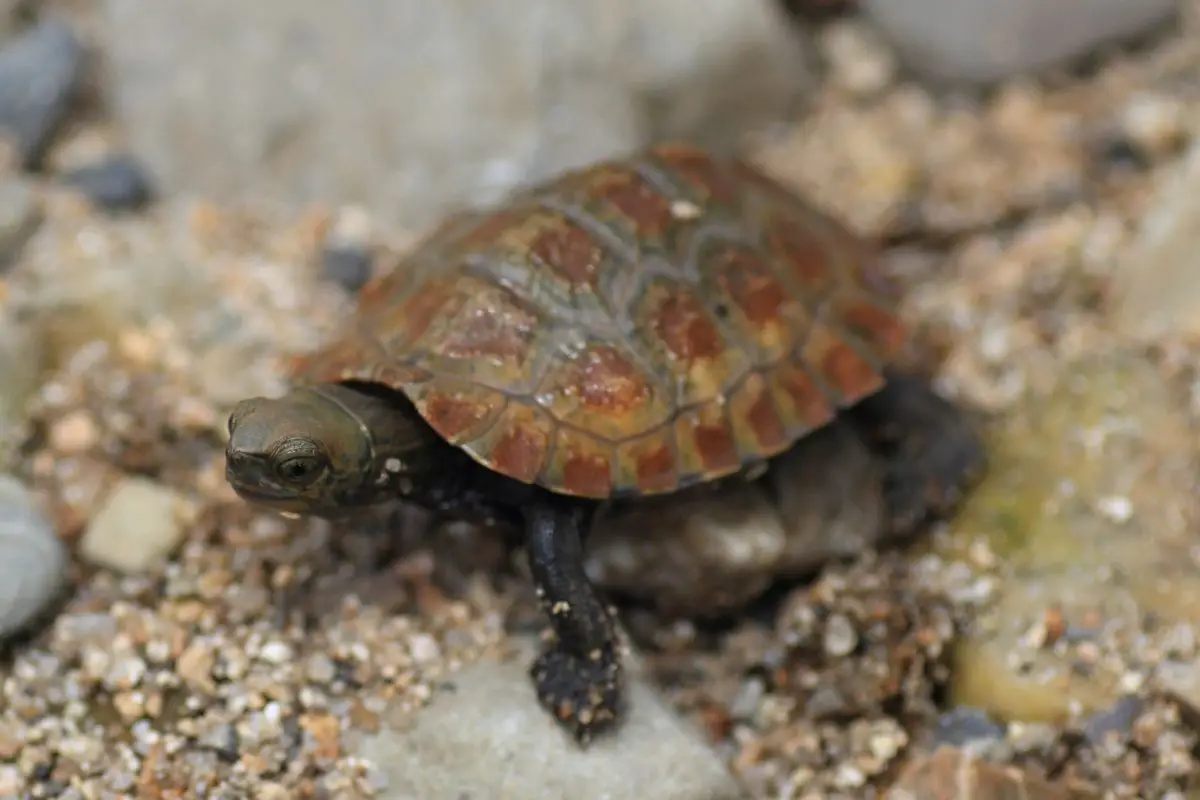
The Japanese Pond Turtle is only found in Japan, where it’s called the Nihon Ishigame. This turtle thrives in colder climates and therefore waters.
They live around the Japanese islands and also hibernate under the depths of said water. Many Japanese families keep them as pets, as well as families all around the world.
Their shells are either black or brown, and sometimes have a yellow tint to them. The edges of the shell are serrated, leaving it with a lovely curved pattern. You will be able to see orange stripes on their legs, making it easy to identify them.
The Japanese Pond Turtle is an omnivore and therefore eats plants and animals. These turtles may grow between 5 and 8 inches long. They typically live to be at least 20, but many live for much longer than this.
- Family Name: Geoemydidae
- Genus Name: Mauremys
- Binomial Name: Mauremys Japonica
- Otherwise Known As: Japanese Stone Turtle, Japanese Turtle
- Aquatic? Aquatic
- Maximum Size: Between 5 and 8 inches
- Average Lifespan: At least 20 years
Map Turtles
Alabama Map Turtle
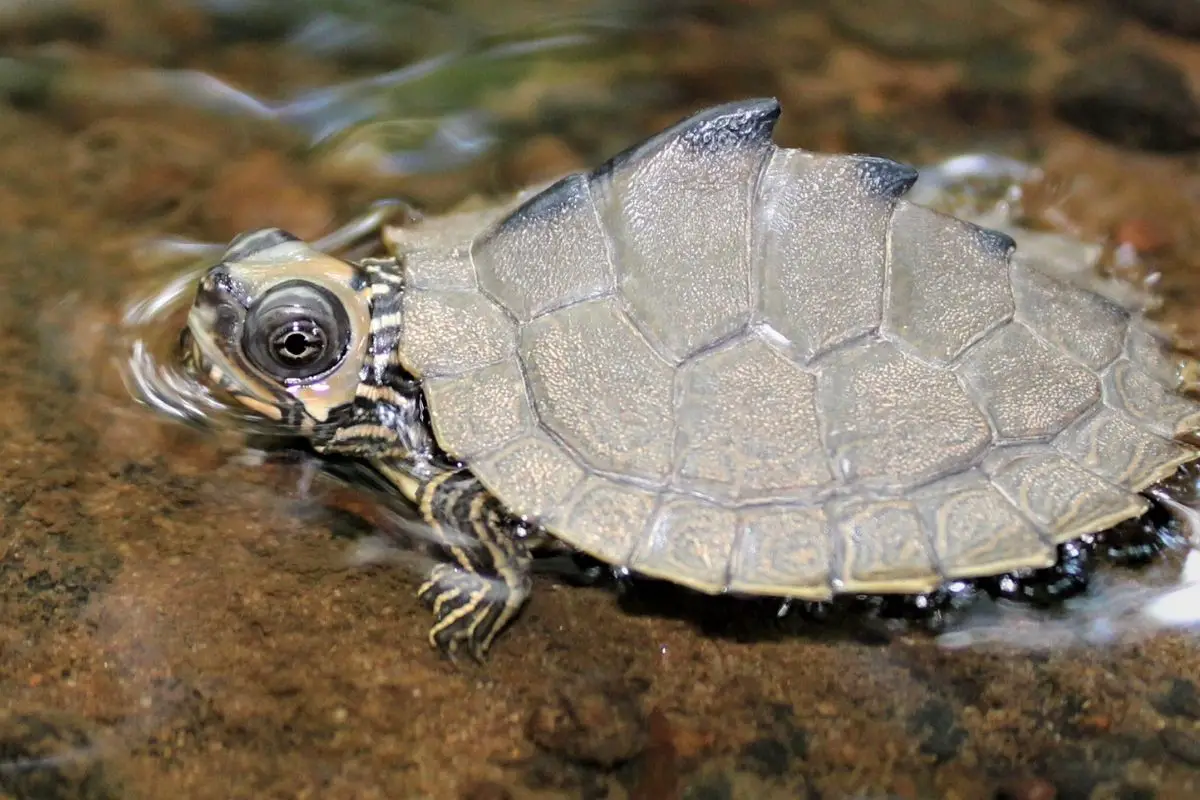
This turtle can only be found in a small patch of the southeastern US, including Alabama, Mississippi, and Georgia. They like to reside in rivers but are on the critically endangered list, so need to be protected at all costs.
They have a flat top and a round bottom, which makes their shell appear more like an upside down bowl. The shell is usually green with yellow markings.
They also have black stripes running along their spine. They are also known as the “map turtle”, due to the fact that they look like a map when viewed from above.
These turtles eat mostly fish, shrimp, crabs, worms, and other aquatic creatures. They are not considered to be aggressive towards humans, unless provoked, and will often swim away if you try to pick them up.
- Family Name: Emydidae
- Genus Name: Graptemys
- Binomial Name: Graptemys Pulchra
- Otherwise Known As: Not Known
- Aquatic? Yes
- Maximum Size: Between 3.5 and 11.5 inches
- Average Lifespan: 20 years
- Found In The Following States: Alabama, Georgia, Mississippi
Northern Map Turtle
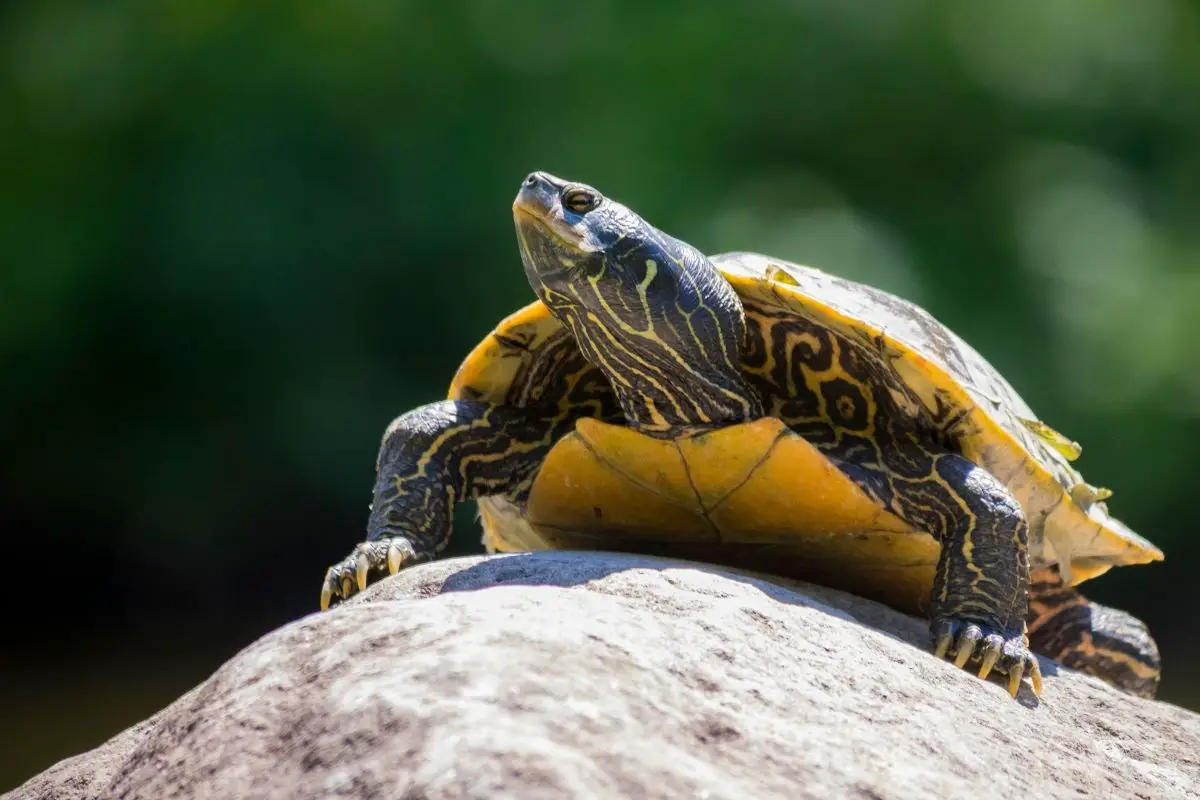
Out of all of the map turtles, the Northern Map Turtle is the most widespread and therefore the easiest to spot. It can be found all over the east and central parts of the USA. They typically reside in rivers and are rarely out of the water.
They have two different types of shells, one being a normal shell and the other being a hard shell.
Their normal shell is dark brown with lighter lines that resemble the markings on a map. The hard shell has a smooth surface and is usually either green or brown.
These turtles eat mainly fish, crustaceans, insects, and amphibians. They are very territorial and might attack any human who comes near them.
- Family Name: Emydidae
- Genus Name: Graptemys
- Binomial Name: Graptemys Geographica
- Otherwise Known As: Common Map Turtle
- Aquatic? Yes
- Maximum Size: Between 4 and 6 inches
- Average Lifespan: Between 15 and 20 years
- Found In The Following States: Alabama, Arkansas, Georgia, Illinois, Indiana, Iowa, Kansas, Kentucky, Maryland, Michigan, Minnesota, Missouri, New Jersey, New York, Ohio, Oklahoma, Pennsylvania, Tennessee, Vermont, Virginia, West Virginia, Wisconsin
Barbour’s Map Turtle
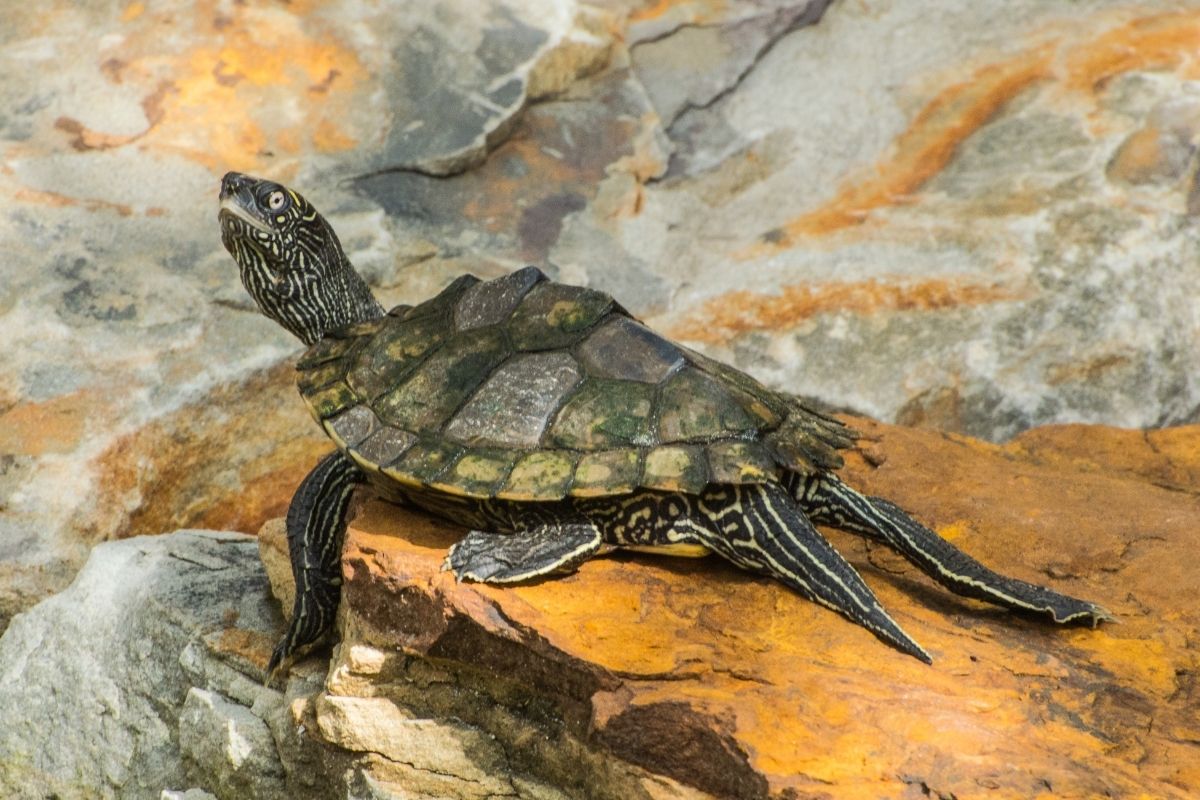
You can find the Barbour’s Map Turtle in many quick moving waters such as rivers and streams. They are mainly found in south east Alabama, the south west of Georgia, and the Florida Panhandle.
These turtles are among the few that are more carnivores than the majority of other turtles, eating meat sources only.
You often won’t be able to spot a Barbour’s Map Turtle on account of them spending the majority of their time underwater, except for when the females begin nesting on land.
This turtle can be distinguished by their shark tooth keels with black tips running down their spines. The edges of their shells are also a vibrant yellow color. Again, this species is endangered due to the loss of their habitats.
- Family Name: Emydidae
- Genus Name: Graptemys
- Binomial Name: Graptemys Baarbouri
- Otherwise Known As: Not Known
- Aquatic? Yes
- Maximum Size: Between 3.5 and 5.5 inches
- Average Lifespan: 30 years
- Found In The Following States: Alabama, Georgia, Florida
Ouachita Map Turtle
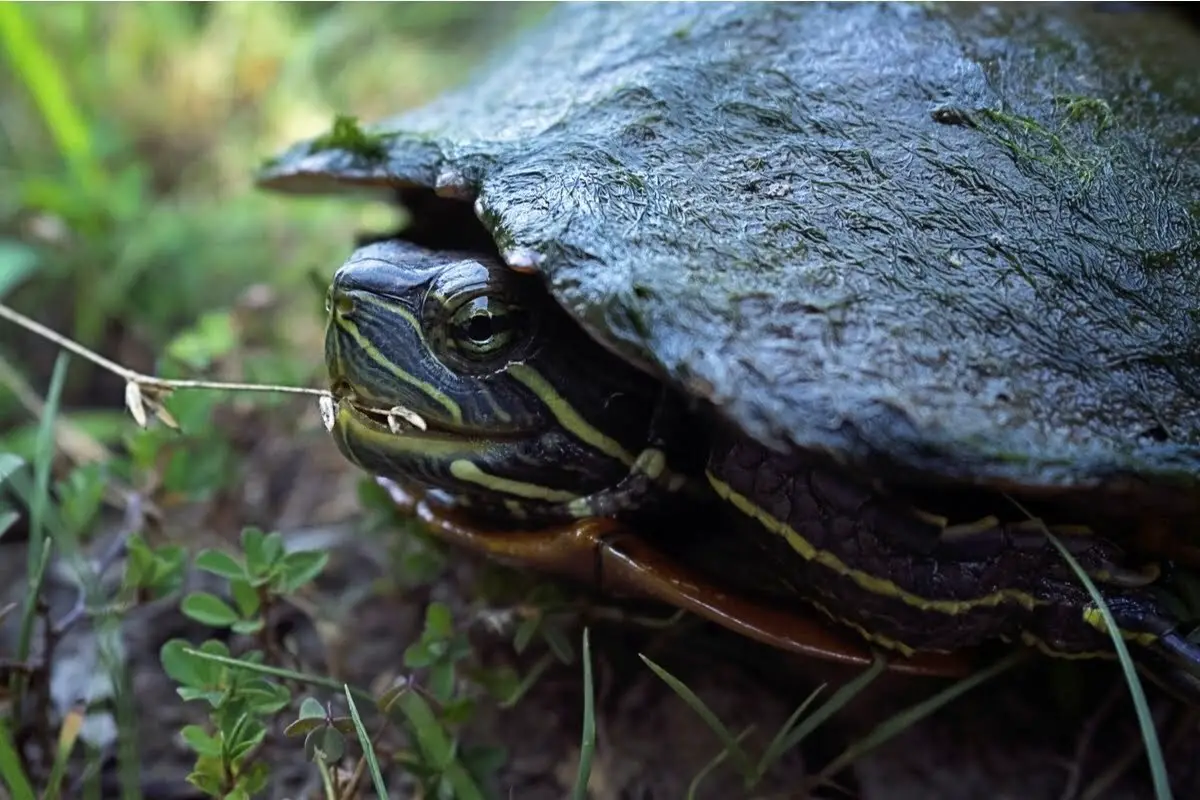
Ouachita Map Turtles can be found in the Midwest areas of the United States. Their defining feature is their large patches of light coloring behind their eyes.
The male turtles will have one keel coming from their shell which is very pronounced and impossible to miss.
The female turtles tend to have less defined keels. These turtles are not very aggressive and do not pose much of a threat to humans.
You can find them in rivers and drainage waterways. They eat both plant matter and meat sources due to their omnivorous diet.
- Family Name: Emydidae
- Genus Name: Graptemys
- Binomial Name: Graptemys Ouachitensis
- Otherwise Known As: Not Known
- Aquatic? Yes
- Maximum Size: Between 3.5 and 10 inches
- Average Lifespan: Between 15 and 20 years
- Found In The Following States: Alabama, Arkansas, Illinois, Indiana, Iowa, Kansas, Kentucky, Louisiana, Minnesota, Mississippi, Missouri, Ohio, Oklahoma, Tennessee, Texas, West Virginia, Wisconsin
Black-Knobbed Map Turtle
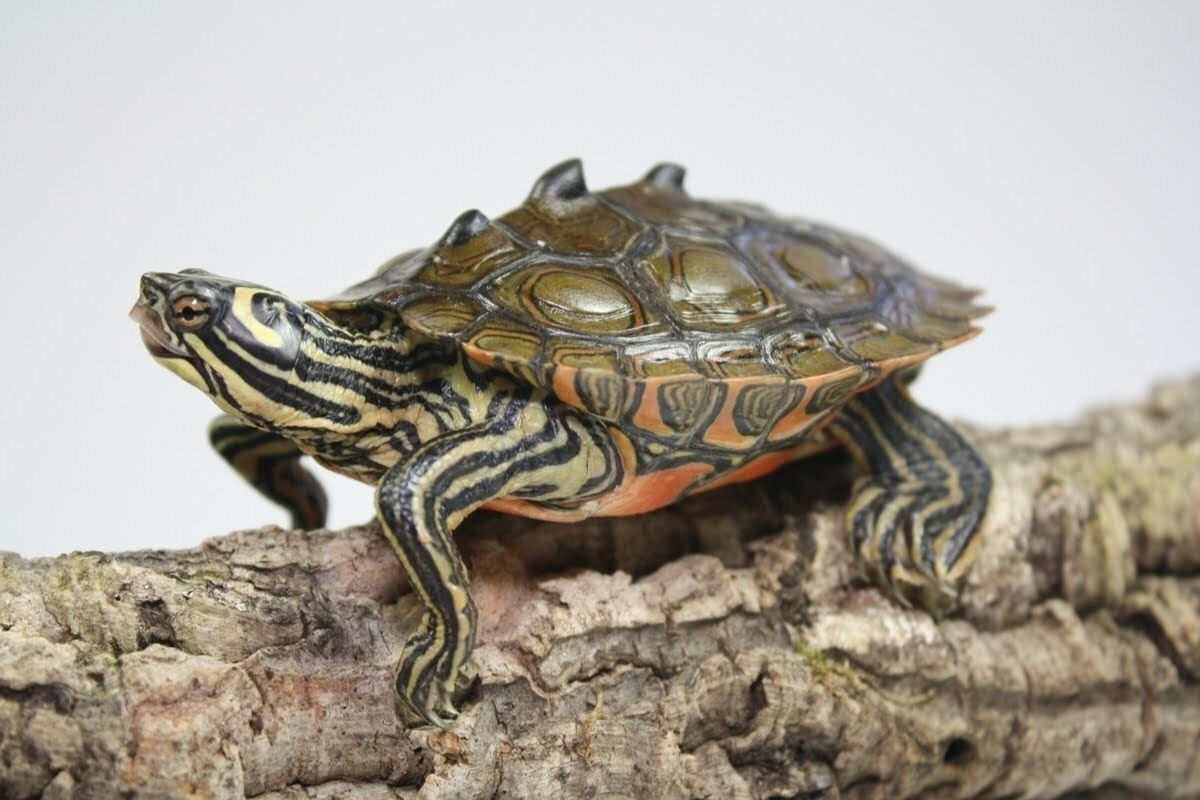
This is probably the easiest species of turtle to correctly identify, thanks to its distinctive black keels protruding high from its back. Their shells are dark green and their skin is gray, so they are quite distinguishable all round.
The Black-knobbed Map Turtle has been around since the early 1900s, and was once common throughout the southeast United States.
However, it now lives in very limited areas, and is considered to be a near threatened species of turtle. It is threatened by habitat destruction, pollution, overfishing, and invasive species.
They eat a mostly meat-only diet and like fresh waters over brackish water. They don’t look like the majority of other map turtles.
- Family Name: Emydidae
- Genus Name: Graptemys
- Binomial Name: Graptemys Nigrinoda
- Otherwise Known As: Black-knobbed Sawback
- Aquatic? Yes
- Maximum Size: Between 3.5 and 8 inches
- Average Lifespan: Between 20 and 30 years
- Found In The Following States: Alabama and Mississippi
Texas Map Turtle
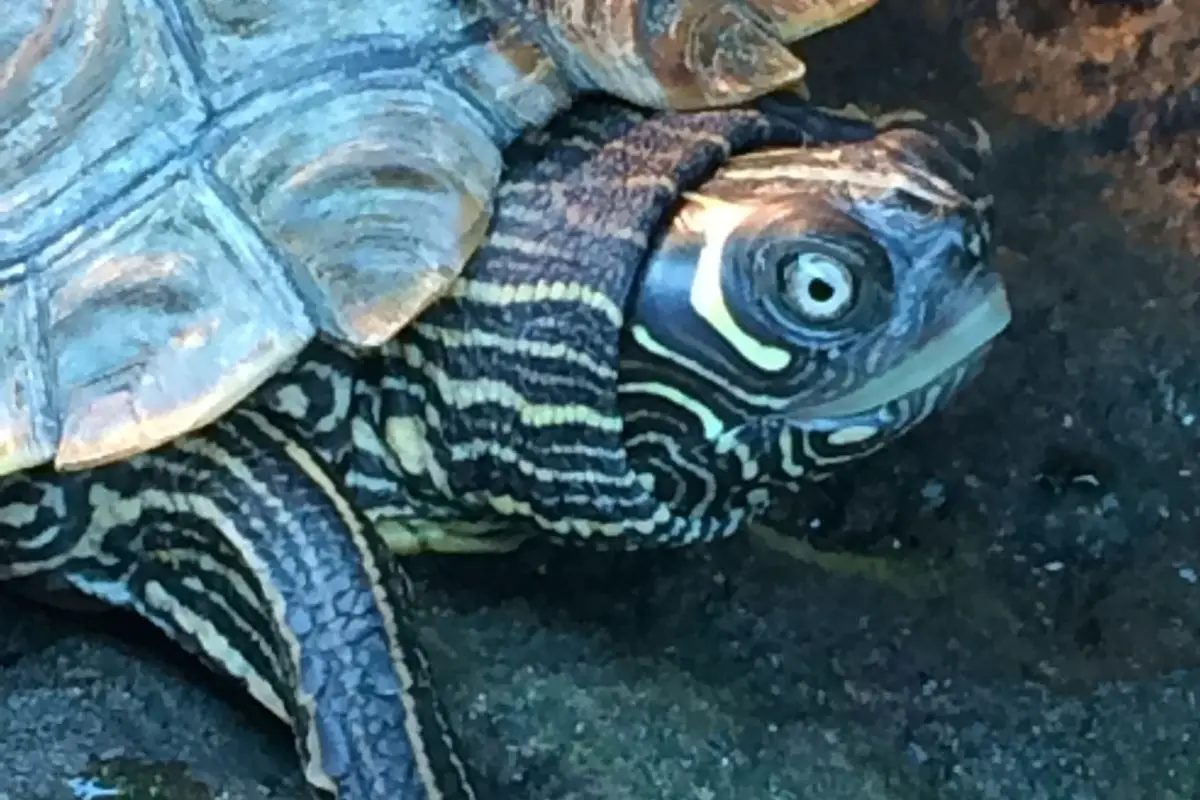
Another very small species of turtle, the Texas Map Turtle can only be found in Texas (hence their name). They love residing in fast moving waters such as streams and rivers, and you will most commonly find them in waters joining onto the Colorado River.
Their shells are brown or olive colored with yellow markings that look similar to those on a map. Their keels are spiked and sharp at the end, so don’t get too close!
They also have three spots on top of their heads which will either be yellow or orange colored. These omnivorous turtles eat anything that comes into their line of sight.
- Family Name: Emydidae
- Genus Name: Graptemys Versa
- Binomial Name: Graptemys Ouachitensis
- Otherwise Known As: Not Known
- Aquatic? Yes
- Maximum Size: Between 3.5 and 5 inches
- Average Lifespan: Between 30 and 50 years
- Found In The Following States: Texas
Cagle’s Map Turtle
The Cagle’s Map Turtle gets its name from Dr. Fred Ray Cagle, a herpetologist. You can find this turtle in Texas rivers, although it might be too difficult to spot due to its incredibly small size (in relation to other turtle species).
You’ll have the most luck finding this turtle in the south of the Guadalupe River, such as in San Antonio rivers.
It eats mainly fish and insects, but will sometimes take frogs or crayfish if there aren’t any available. It has a map-like pattern on its shell along with pronounced keels and a serrated edging. Their skin is also striped with yellow coloring.
- Family Name: Emydidae
- Genus Name: Graptemys
- Binomial Name: Graptemys Caglei
- Otherwise Known As: Not Known
- Aquatic? Yes
- Maximum Size: Between 3.5 and 10 inches
- Average Lifespan: Between 30 and 50 years
- Found In The Following States: Texas
Yellow-Blotched Map Turtle
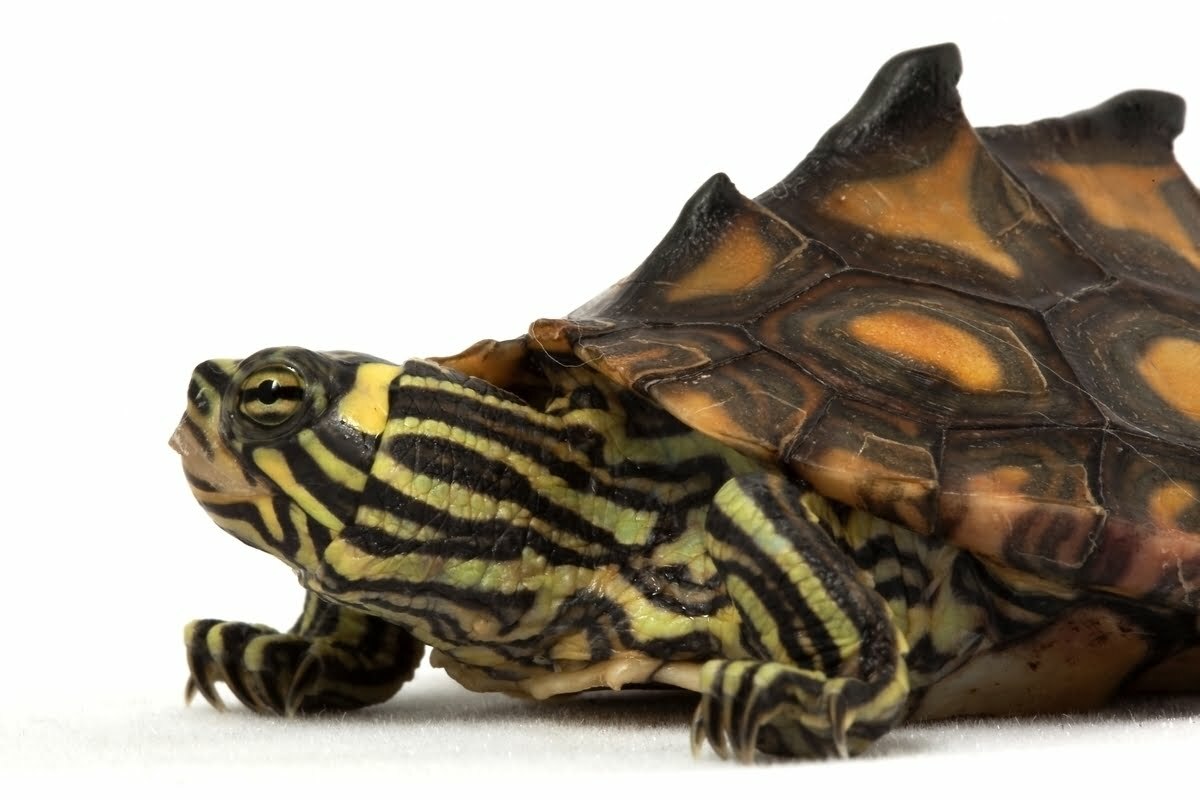
This is one of the rarer species of turtles on our list, and they can only be seen in the Pascagoula River of Mississippi. They are on the threatened species list due to their very confined habitat. Once the habitat is harmed, so are the turtles.
You can identify the Yellow-blotched Map Turtle thanks to a central keel higher than all of the others. In fact, it is the highest keel of any of the map turtles.
They are omnivores and enjoy eating insects, fish, and plant matter. They do have a preference for meat, though.
- Family Name: Emydidae
- Genus Name: Graptemys Versa
- Binomial Name: Graptemys Flavimaculata
- Otherwise Known As: Yellow-blotched Sawback
- Aquatic? Yes
- Maximum Size: Between 3 and 7 inches
- Average Lifespan: Between 30 and 50 years
- Found In The Following States: Mississippi
False Map Turtle
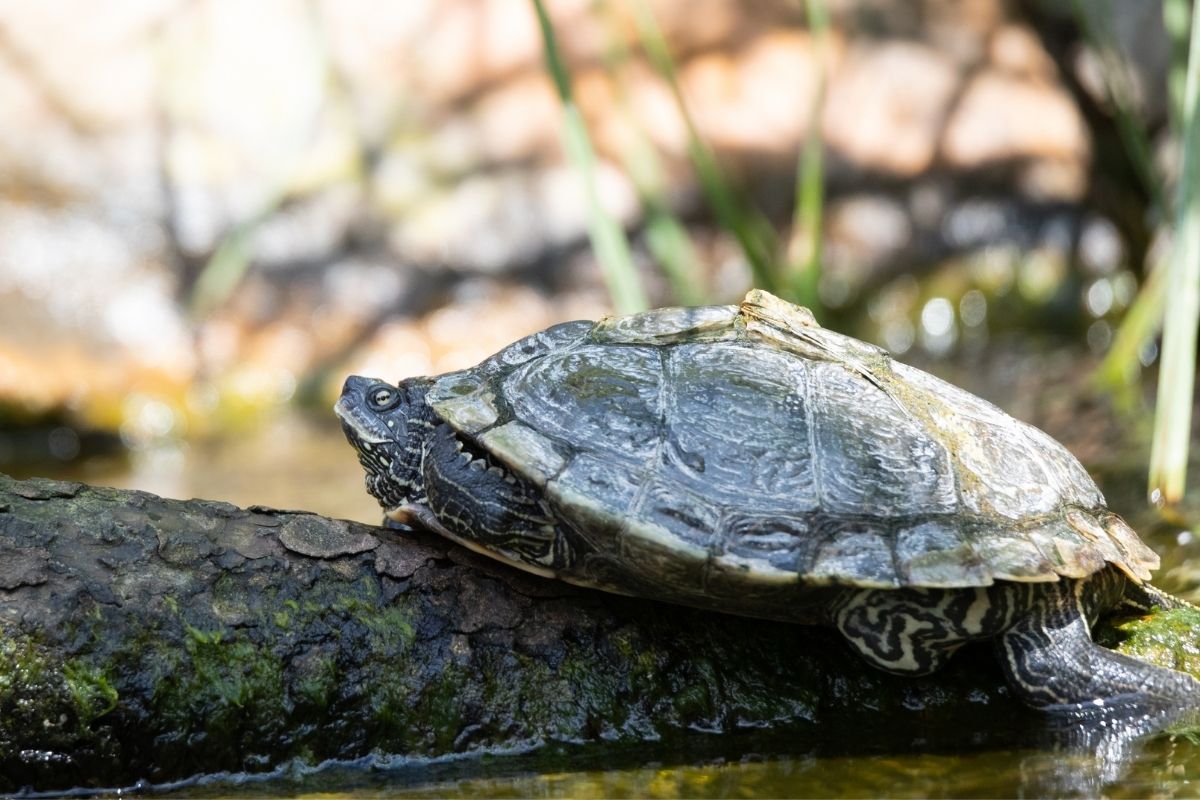
You’ll be able to find this turtle throughout the majority of the Midwest states of the US. False Map Turtles enjoy large bodies of water so will mainly reside in big river systems such as the Mississippi.
They eat mainly aquatic plants and algae, but will occasionally eat some invertebrates such as worms and snails. Their defining feature different to other map turtles is that their heads do not feature a colored patch.
Their shells are dark green and rough, and they have a distinctively shaped head. Their skin is generally brown in color, but can vary depending on the environment that they live in.
They don’t enjoy spending too much time in water and will much prefer to be lounging on vegetation just next to the water.
They have big heels that are shaped like the teeth of a saw. They also have a yellow pattern on their shells with black patches between it.
- Family Name: Emydidae
- Genus Name: Graptemys
- Binomial Name: Graptemys Pseudogeographica
- Otherwise Known As: Sawback Turtle
- Aquatic? Yes
- Maximum Size: Between 3.5 and 10 inches
- Average Lifespan: Between 30 and 50 years
- Found In The Following States: Alabama, Arkansas, Florida, Illinois, Indiana, Iowa, Kansas, Kentucky, Louisiana, Minnesota, Mississippi, Missouri, Nebraska, North Dakota, Ohio, Oklahoma, South Dakota, Tennessee, Texas, Wisconsin
Mississippi Map Turtle
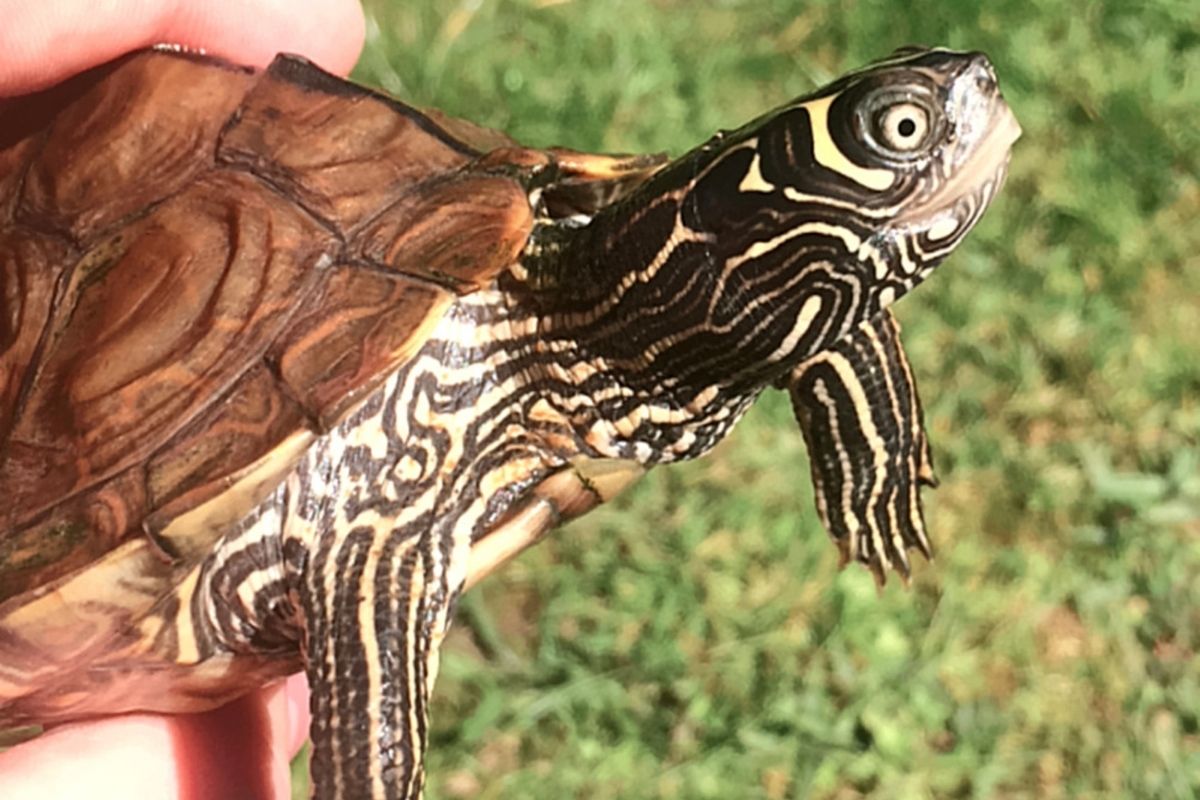
The Mississippi Map Turtle is a subspecies of the False Map Turtle, and therefore they are very close to one another. They can be mainly found in the Mississippi River and its adjoining waterways.
Many people see them lounging on rocks around this body of water rather than in the water itself.
Mississippi Map Turtles have yellow and brown shells with a pattern similar to that of a map. Their keels are quite sharp and have black tips.
These turtles follow an omnivorous diet and therefore eat fish, plant matter, and invertebrates.
- Family Name: Emydidae
- Genus Name: Graptemys
- Binomial Name: Graptemys Pseudogeographica Kohni
- Otherwise Known As: Sawback Turtle
- Aquatic? Yes
- Maximum Size: Between 3.5 and 10 inches
- Average Lifespan: Between 30 and 50 years
- Found In The Following States: Arkansas, Iowa, Kentucky, Louisiana, Minnesota, Mississippi, Missouri, Tennessee, Wisconsin
Leaf Turtles
Leaf Turtle
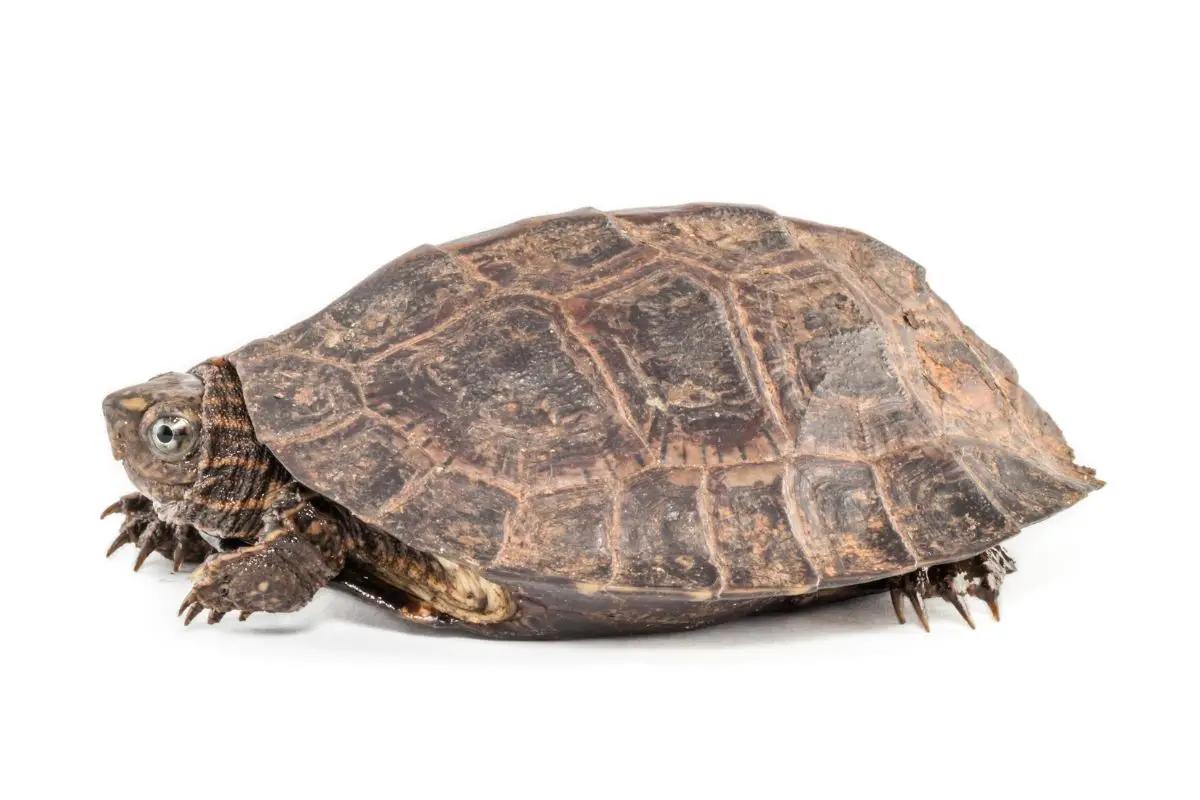
Leaf turtles are mainly found only in Asia, although they are quite commonly seen in the pet trade.
The reliance on importing them to various different countries has put serious health complications onto them, meaning that they are soon to be extinct.
While you can breed Leaf Turtles in captivity, it is proven to be extremely difficult as they are very sensitive specimens.
Leaf Turtles are one of the smaller turtle species, with some being as short as only 4 inches! The name originates from their mottled markings on their shell which can be likened to that of a leaf.
- Family Name: Geoemydidae
- Genus Name: Geoemyda
- Binomial Name: Multiple Different
- Otherwise Known As: Multiple Different
- Aquatic? Aquatic
- Maximum Size: Between 4 and 9 inches
- Average Lifespan: 20 years
Black-Breasted Leaf Turtle
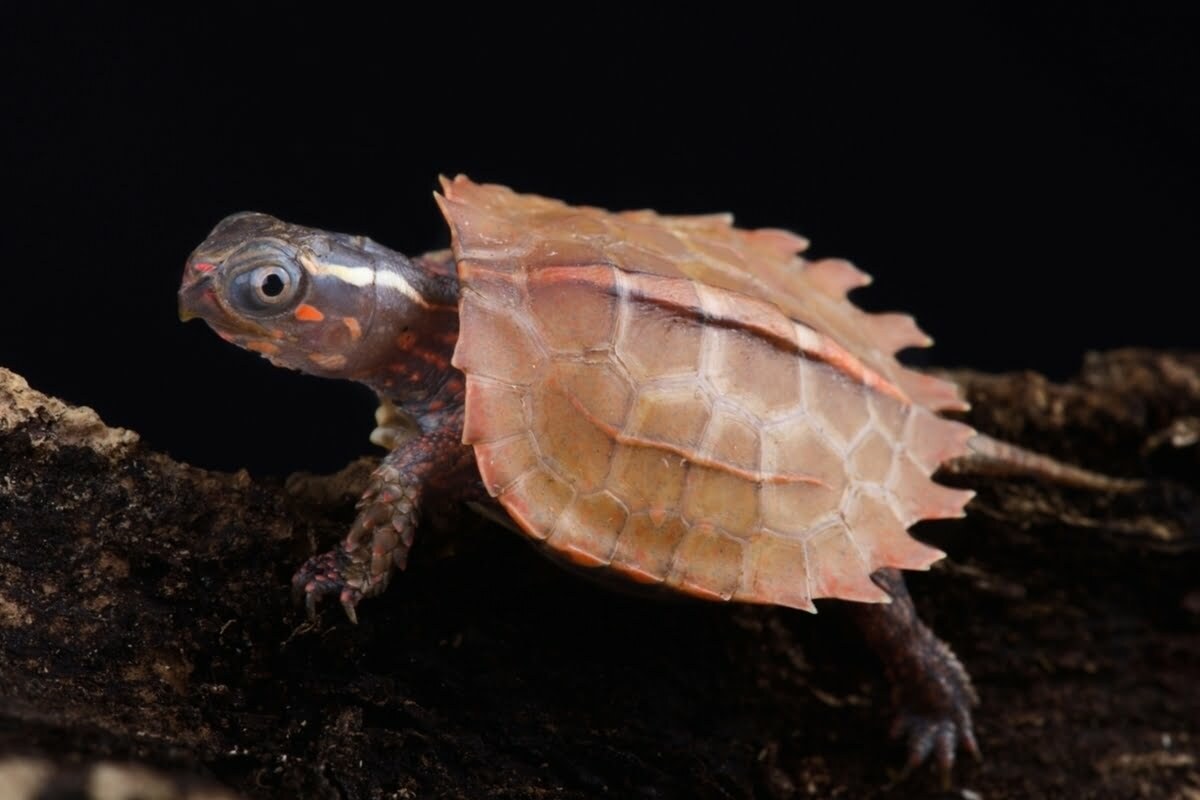
This turtle is native to the south east of Asia, and can also be found in the south of China as well as north Vietnam. You can easily identify a Black-breasted Leaf Turtle thanks to the mottled pattern on their dark green shells.
They also have distinctive eyes and three bumps along their keels, and their lower shells will be a striking black color.
These turtles enjoy disguising themselves underneath leaves within the Asian forests. For this reason, it’s surprisingly difficult to spot a Black-breasted Leaf Turtle in the wild. They are omnivores so eat all kinds of food.
This species is also endangered, mainly due to the pet trade using them so dangerously.
- Family Name: Geoemydidae
- Genus Name: Geoemyda
- Binomial Name: Geoemyda spengleri
- Otherwise Known As: Vietnamese Leaf Turtle, Black-breasted Hill Turtle
- Aquatic? Yes
- Maximum Size: Between 3 and 4 inches
- Average Lifespan: 20 years
Mud Turtles
Mud Turtle
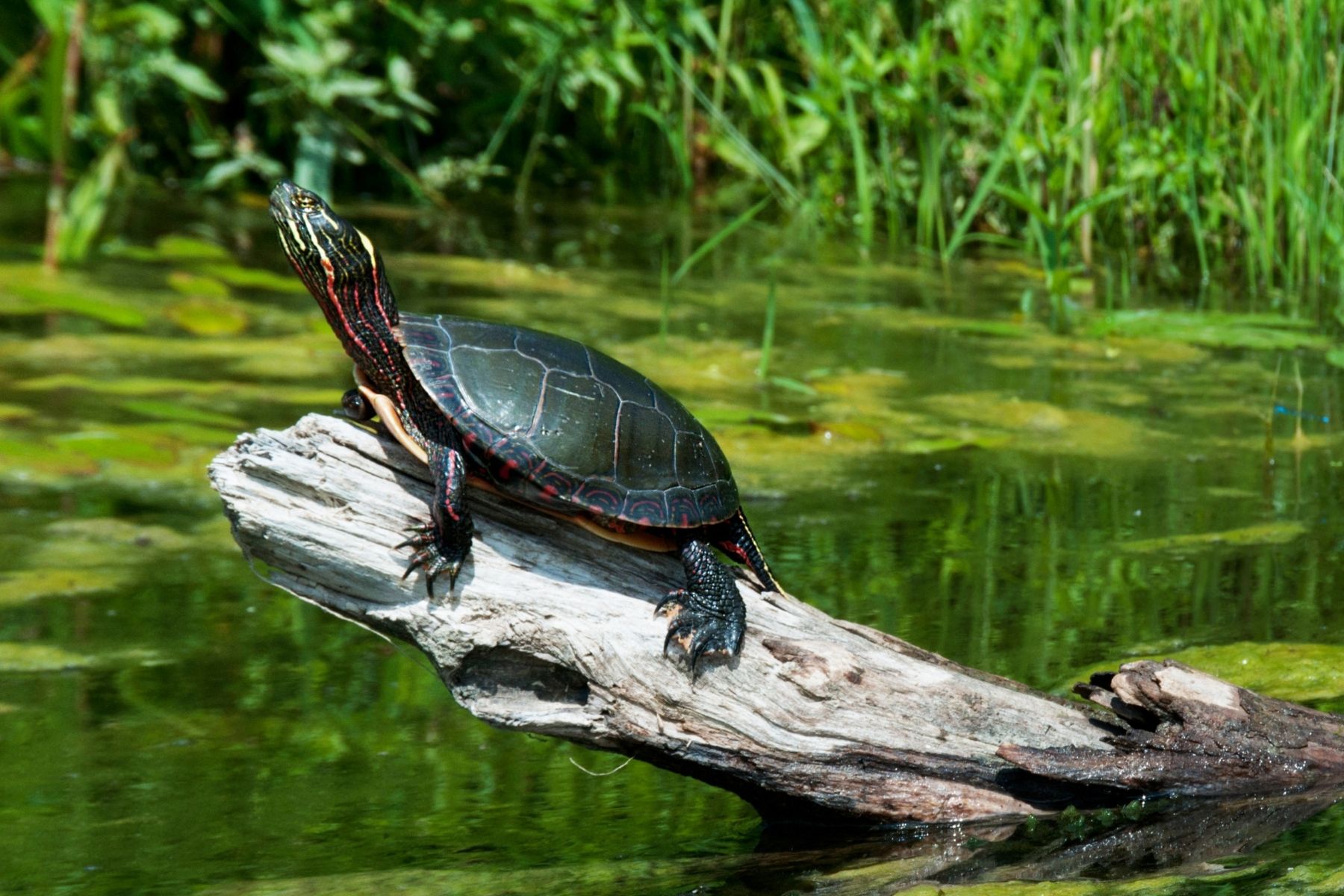
This group of turtles are aquatic and therefore like to spend the majority of their time in the water. They are native to the USA and Central America.
They are quite small and slow, and therefore prefer slower moving waters with soft bottoms. Think mud, sand, and vegetation.
Mud turtles tend to have a flatter shell compared to other turtle species. Due to their small size, they are commonly seen in the pet trade. Most Mud Turtles are carnivores and therefore enjoy a diet of meat rather than vegetation.
- Family Name: Kinosternidae
- Genus Name: Kinosternon
- Binomial Name: Multiple Different
- Otherwise Known As: Multiple Different
- Aquatic? Yes
- Maximum Size: Between 5 and 10 inches
- Average Lifespan: Between 10 and 50 years
Striped Mud Turtle
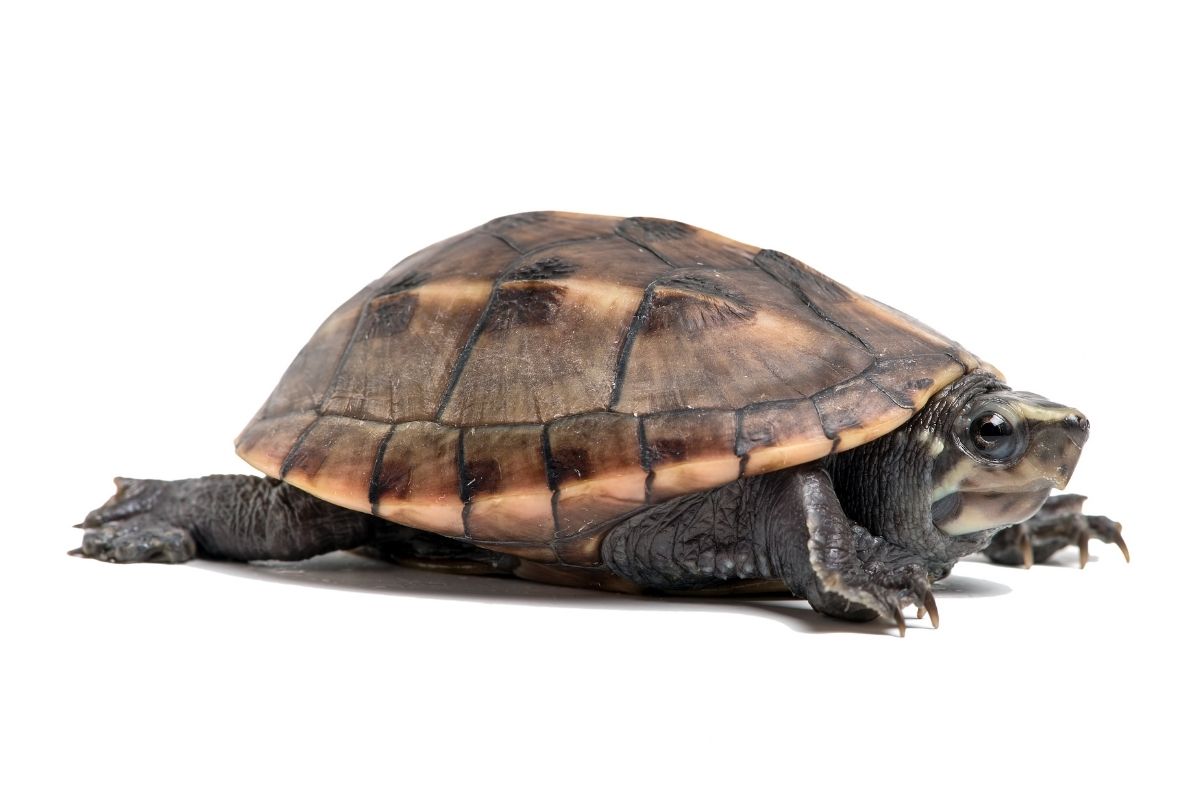
The Striped Mud Turtle is a small species that have three very distinctive stripes traveling down their brown shells.
These stripes will be a light color so they will stand out easily against the darkness of their shells. They also have yellow stripes on their heads between their eyes.
You can find the Striped Mud Turtle among south eastern areas of the USA, and they are one of the more active mud turtles. They can run on land quickly and enjoy foraging for food out of the water.
When in the water, they enjoy shallow areas with soft bottoms such as mud or sand. They prefer the water to be moving slowly, but not too quickly.
These turtles are omnivores, which is unusual for mud turtles, and they enjoy both plant and animal matter.
- Family Name: Kinosternidae
- Genus Name: Kinosternon
- Binomial Name: Kinosternon Baurii
- Otherwise Known As: Three-striped Mud Turtle
- Aquatic? Yes
- Maximum Size: Between 4 and 5 inches
- Average Lifespan: Between 10 and 50 years
- Found In The Following States: Alabama, Florida, Georgia, Maryland, North Carolina, South Carolina, Virginia
Mississippi Mud Turtle
The Mississippi Mud Turtle is just one of the two subspecies of the Eastern Mud Turtle. You will often be able to find them at the bottom of a body of water as long as it’s muddy and stagnant. Swamps are very good places to find this turtle.
However, this turtle actually spends the most time on land than any other mud turtle, so it’s possible to see them lounging on rocks. They are most active on land after it has rained, so take your umbrella when looking for them!
These small turtles have a dark shell with yellow bellies. You can identify them from other mud turtles thanks to their yellow banding that surrounds their face and necks. The Mississippi Mud Turtle enjoys eating meat over plants.
- Family Name: Kinosternidae
- Genus Name: Kinosternon
- Trinomial Name: Kinosternon Subrubrum Hippocrepis
- Otherwise Known As: Not Known
- Aquatic? Semi-Aquatic
- Maximum Size: Between 3 and 4.5 inches
- Average Lifespan: Between 30 and 50 years
White-Lipped Mud Turtle

White-lipped Mud Turtles are native to areas in central and the south of America. They reside in slow waters that are murky, such as swamps and marshes.
If the water has a sandy bottom, they will enjoy it more. This is because as the water dips they can burrow into the soft floor.
They are mostly nocturnal, but they do like to come out during the day if there is enough sunlight. Their shells are more oval in shape than other turtles, and the color will either be black or brown.
As their name suggests, their mouths will be white or cream colored. Finally, their tails are spiked like a horn.
Another mud turtle that is an omnivore, the White-lipped Mud Turtle enjoys snacking on works, mollusks, fish, plant matter, and more.
- Family Name: Kinosternidae
- Genus Name: Kinosternon
- Binomial Name: Kinosternon Leucostomum
- Otherwise Known As: Not Known
- Aquatic? Yes
- Maximum Size: 8 inches
- Average Lifespan: Between 30 and 50 years
Red-Cheeked Mud Turtle
As the name suggests, you can easily distinguish this turtle from others thanks to its red blotches on its cheeks. You’ll be able to find this turtle throughout certain areas of South America.
These turtles better enjoy warm water than cold, and they like to reside on soft bottoms such as sand or vegetation. However, you’re much more likely to see them floating on the surface of the water.
Red-cheeked Mud Turtles have brown shells that are more domed than other mud turtles. they have bright orange bellies, though, which is another way to easily categorize them. These turtles are carnivores and therefore will only eat meat wherever possible.
- Family Name: Kinosternidae
- Genus Name: Kinosternon
- Trinomial Name: Kinosternon Scorpioides Cruentatum
- Otherwise Known As: Not Known
- Aquatic? Semi-Aquatic
- Maximum Size: 7 inches
- Average Lifespan: Between 30 and 50 years
Yellow Mud Turtle
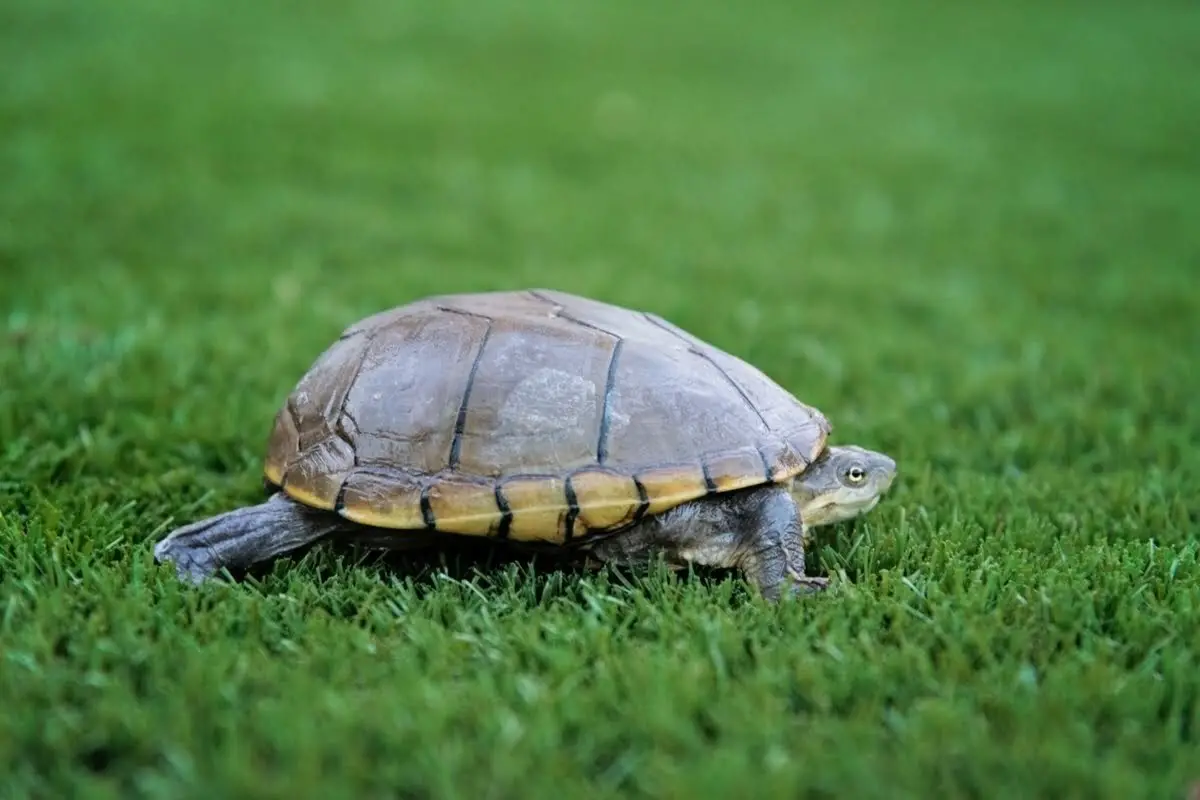
Yellow Mud Turtles are native to mid and south western parts of the United States as well as areas in northern Mexico.
They live in wetlands such as ponds and swamps, although they do tend to spend a good amount of their time on land. They enjoy digging in sandy places and they will burrow there from time to time.
These turtles have olive green shells and they have plenty of yellow patterns on their face. Their lower shells are also yellow, which is where they get their name from.
They are carnivores and therefore spend the majority of their time looking for crustaceans, worms, mollusks, and invertebrates to eat.
- Family Name: Kinosternidae
- Genus Name: Kinosternon
- Binomial Name: Kinosternon Flavescens
- Otherwise Known As: Yellow-necked Mud Turtle
- Aquatic? Yes
- Maximum Size: Between 4 and 6 inches
- Average Lifespan: Between 10 and 50 years
- Found In The Following States: Arizona, Arkansas, Colorado, Illinois, Iowa, Kansas, Missouri, Nebraska, New Mexico, Oklahoma, Texas
Scorpion Mud Turtle
Scorpion Mud Turtles can be found throughout central and southern parts of America, with a popular example being Mexico.
They enjoy spending most of their time in the water and even go as far as using any type of water as their home. It doesn’t matter if it’s salty, fresh, murky, fast or slow – if it’s wet, they’ll enjoy it.
They also prefer to live near bodies of water, but they don’t mind living anywhere that isn’t too hot or cold. This makes scorpion mud turtles great swimmers, and they can swim up to 20 miles per hour.
Their shells are black or brown with gray skin. They are most distinguishable by their orange, yellow, or red patterns on their head and neck areas. They are carnivores and have even been known to be cannibals if needs be.
- Family Name: Kinosternidae
- Genus Name: Kinosternon
- Trinomial Name: Kinosternon Scorpioides
- Otherwise Known As: Not Known
- Aquatic? Yes
- Maximum Size: Between 3 and 11 inches
- Average Lifespan: Between 40 and 50 years
Musk Turtles
Musk Turtle
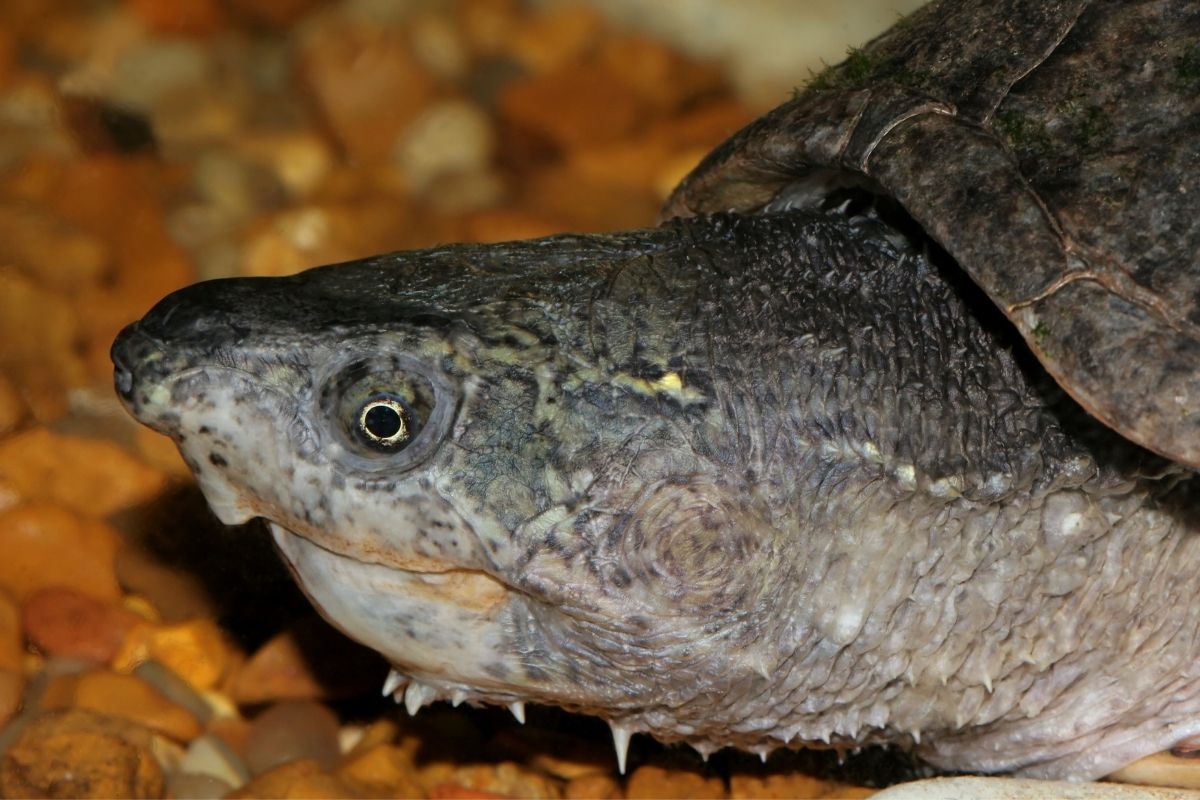
Musk turtles are native to the United States and therefore they can often be seen around many states. They are commonly confused with mud turtles, which we just looked at, but musk turtles tend to be slightly bigger and have higher domed shells.
Still, musk turtles tend to be popular in the pet trade due to their small size. They eat insects, mollusks, and worms mostly, although some are omnivores and therefore enjoy the occasional plant as well.
These turtles walk along the bottom of the water where they can eat their way through vegetation while they’re hunting their prey.
- Family Name: Kinosternidae
- Genus Name: Sternotherus
- Binomial Name: Multiple Different
- Otherwise Known As: Multiple Different
- Aquatic? Yes
- Maximum Size: Between 2 and 5.5 inches
- Average Lifespan: 50 years
Loggerhead Musk Turtle
You can use the size of a Loggerhead Musk Turtle’s head to correctly distinguish them from a crowd, as they tend to have very large heads.
They are most likely to be living in ponds or rivers, however they can sometimes be found among wetlands too.
The Stripe-necked Musk Turtle is a subspecies of the Loggerhead Musk Turtle, so these two are closely related. Loggerheads have a brown or tan shell with black spots along them. They also tend to have yellow stripes along their skin.
Another musk turtle that follows a carnivorous diet, the Loggerhead Musk Turtle enjoys eating insects, fish, and mollusks.
- Family Name: Kinosternidae
- Genus Name: Sternotherus
- Binomial Name: Sternotherus Minor
- Otherwise Known As: Not Known
- Aquatic? Yes
- Maximum Size: Between 3 and 4 inches
- Average Lifespan: 20 years
- Found In The Following States: Alabama, Florida, Georgia, Kentucky, Louisiana, Mississippi, North Carolina, Tennessee, Virginia
Common Musk Turtle
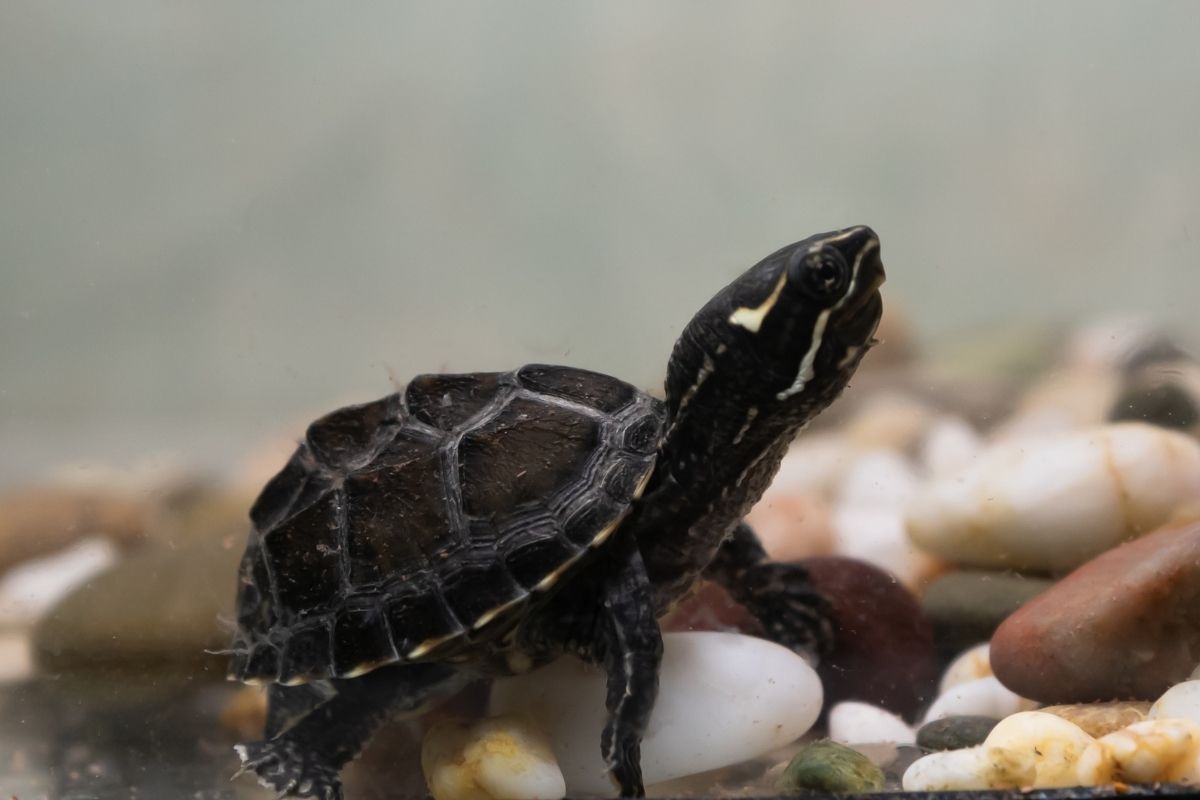
The Common Musk Turtle is – you guessed it – the most common type of musk turtle that you will see around the USA. They live in marshy areas with either stagnant or slow-moving water, and you will rarely see them out of the water.
Another name for these turtles is the Stinkpot Turtle because they let off such an odor from their musk glands. This is probably one of the reasons why they’re not so hot on the pet trade!
Their shells are dark brown or black and they don’t have any distinctive markings on them to help identify them.
They also have dark skin with two yellow lines running along it. The skin around their necks is also loose. They are omnivores and also nocturnal, so they do most of their hunting at night.
- Family Name: Kinosternidae
- Genus Name: Sternotherus
- Binomial Name: Sternotherus Odoratus
- Otherwise Known As: Stinkpot Turtle, Eastern Musk Turtle
- Aquatic? Yes
- Maximum Size: Between 4 and 5 inches
- Average Lifespan: Between 30 and 50 years
- Found In The Following States: Alabama, Arkansas, Connecticut, Delaware, Florida, Georgia, Illinois, Indiana, Iowa, Kansas, Kentucky, Louisiana, Maine, Maryland, Massachusetts, Michigan, Minnesota, Mississippi, Missouri, New Hampshire, New Jersey, New York, North Carolina, Ohio, Oklahoma, Pennsylvania, Rhode Island, South Carolina, Tennessee, Texas, Vermont, Virginia, West Virginia, Wisconsin
Razor-Back Musk Turtle
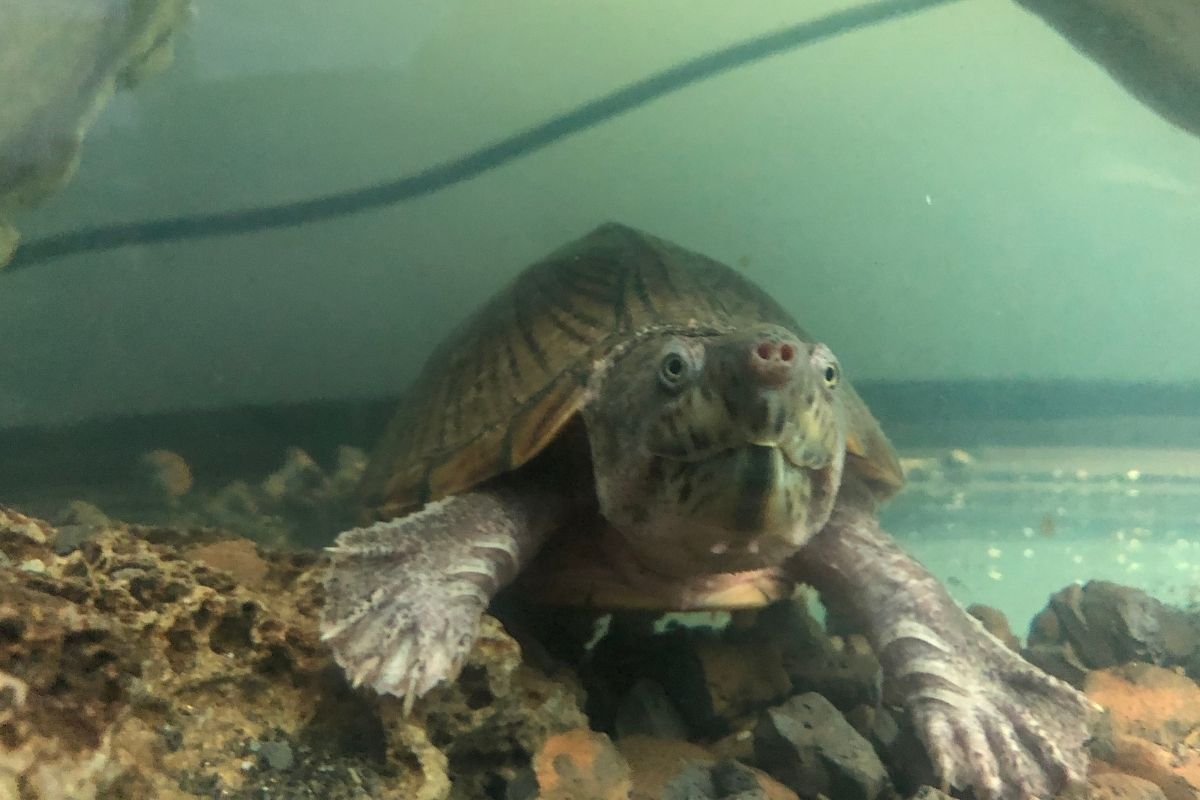
This is the biggest type of Musk turtle there is, and they are aquatic which means they spend the majority of their time in water.
They enjoy slow moving water such as lakes and ponds. They also enjoy lots of vegetation on the ground to hide in while they hunt for their prey.
This is because Razor-back Musk Turtles are carnivores and therefore enjoy snacking on small fish, mollusks, insects, and more.
They can grow up to be between 6 and 10 inches long. Their coloration varies greatly depending on where they were born.
Some are light green, some are olive green, and others are even darker than that. They have black stripes going around their skin along with black spots.
- Family Name: Kinosternidae
- Genus Name: Sternotherus
- Binomial Name: Sternotherus Carinatus
- Otherwise Known As: Not Known
- Aquatic? Yes
- Maximum Size: 6 inches
- Average Lifespan: 30 years
- Found In The Following States: Alabama, Arkansas, Louisiana, Mississippi, Oklahoma, Texas
Flattened Musk Turtle
The Flattened Musk Turtle is on the critically endangered list and therefore can only be found in its native state of Alabama.
It resides in one river in the state called the Black Warrior River. As this is the only place in the world to see this turtle, it is extremely rare.
The name comes from their flattened shell – many people who have seen one say that it looks like someone has stepped on them.
The Flattened Musk Turtle has a dark brown shell with black flecks all over it. These carnivores enjoy eating all types of meat matter such as worms, fish, and amphibians.
- Family Name: Kinosternidae
- Genus Name: Sternotherus
- Binomial Name: Sternotherus Depressus
- Otherwise Known As: Not Known
- Aquatic? Yes
- Maximum Size: Between 3 and 4 inches
- Average Lifespan: 50 years
- Found In The Following States: Alabama
Painted Turtles
Painted Turtle

Painted Turtles are medium in size and very aquatic, meaning that they spend the majority of their time in the water.
As a whole, this species is the one that is the most widespread among the USA, so they’re very common to see while out and about.
What’s more is that painted turtles like to spend their time in shallow waters such as ponds, making them even more noticeable. They are also commonly kept as pets.
Painted Turtles get their name from their lovely shells that have a painted appearance, in all kinds of colors and patterns. These turtles are omnivores and therefore eat both plant and animal matter.
There are four subspecies of Painted Turtles, which we’ll look at below.
- Family Name: Emydidae
- Genus Name: Chrysemys
- Binomial Name: Multiple Different
- Otherwise Known As: Sun Turtles
- Aquatic? Yes
- Maximum Size: Between 4 and 10 inches
- Average Lifespan: Between 25 and 55 years
Western Painted Turtle
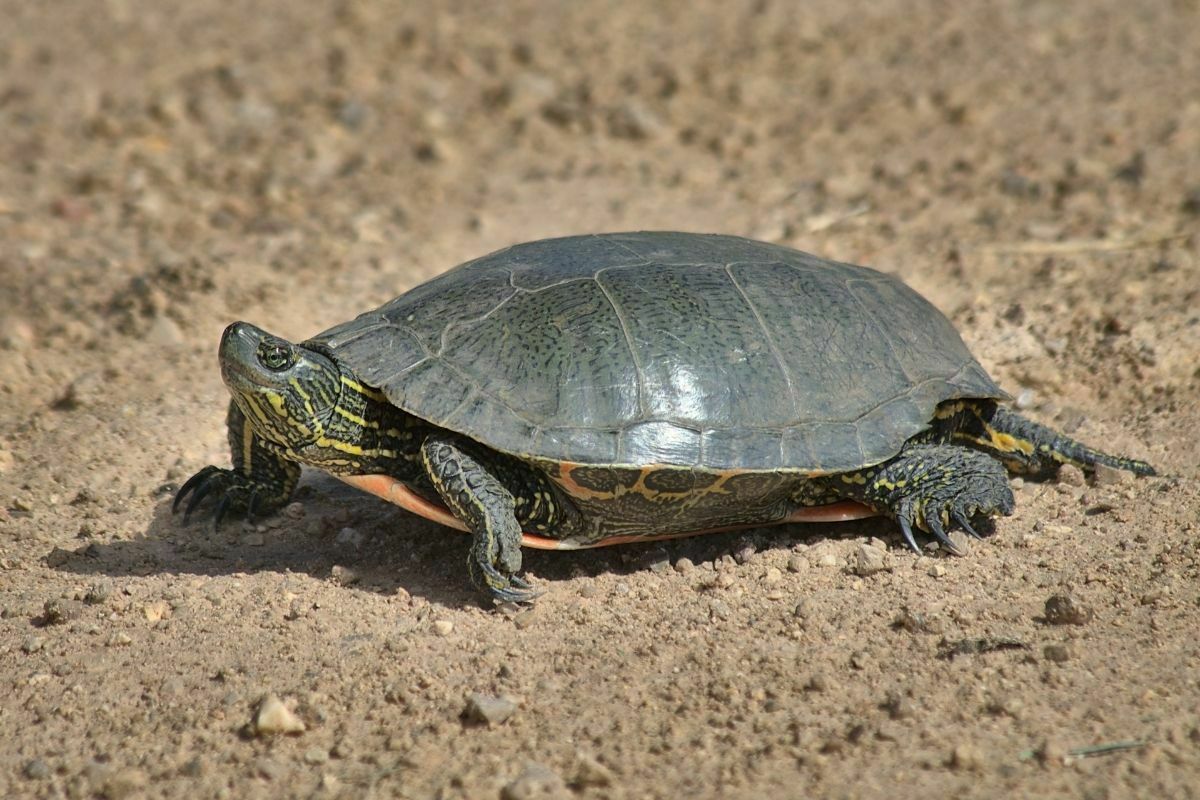
The Western Painted Turtle is the most interesting to look at out of all of the Painted Turtles. This is because the colors are the most vibrant with both green and red being the colors of the lower shell.
The Western Painted Turtle also happens to be Colorado’s state reptile, so it holds an impressive title! This turtle eats both plants and meat making it an omnivore, although it has a preference for vegetation.
- Family Name: Emydidae
- Genus Name: Chrysemys
- Binomial Name: Chrysemys Picta
- Otherwise Known As: Western Sun Turtles
- Aquatic? Yes
- Maximum Size: Between 4 and 10 inches
- Average Lifespan: Between 30 and 40 years
- Found In The Following States: Arizona, Arkansas, California, Colorado, Idaho, Illinois, Iowa, Kansas, Minnesota, Missouri, Montana, Nebraska, Nevada, New Mexico, North Dakota, Oklahoma, Oregon, South Dakota, Texas, Utah, Washington, Wisconsin, Wyoming
Eastern Painted Turtle
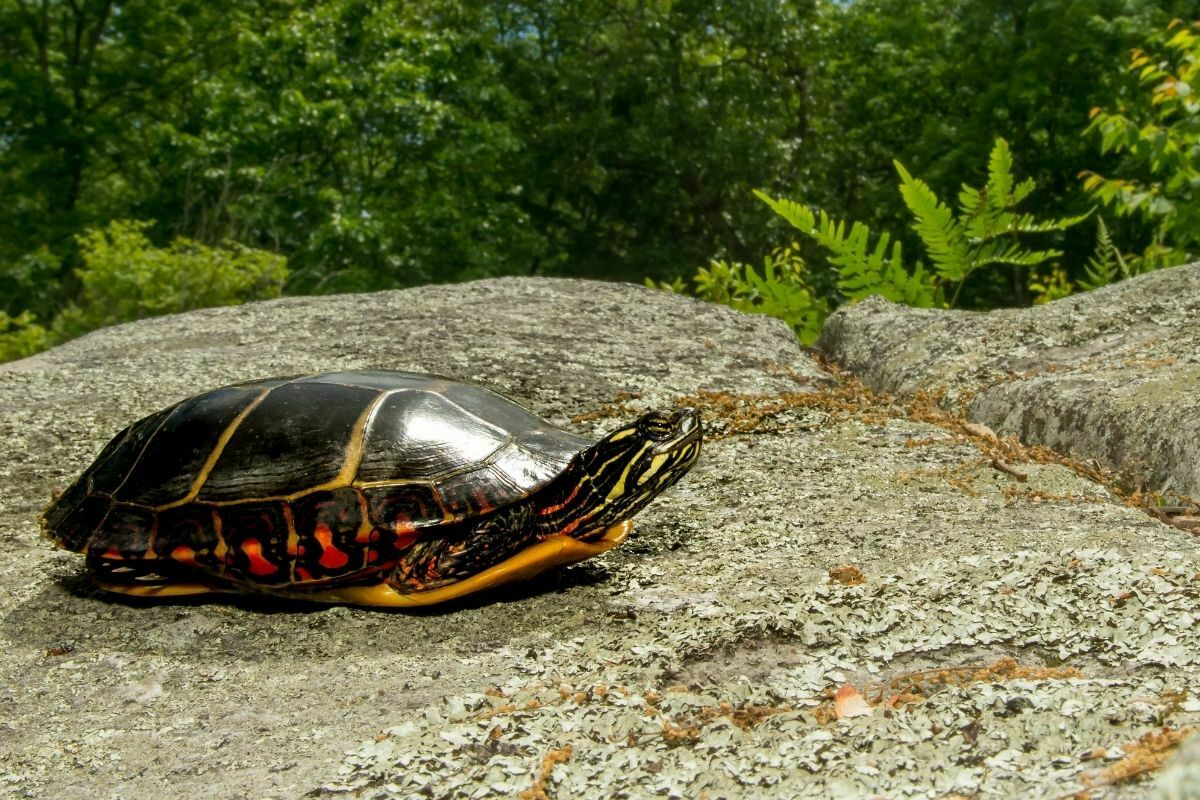
The Eastern Painted Turtle is the first subspecies of the Painted Turtle, and it has an olive shell with red patterns all over it.
It also has red lines reaching up its neck towards its face. Their lower shell is yellow and they have white spots on their face. This turtle is completely multicolored!
The Eastern Painted Turtle is an omnivore and therefore eats both plants and meat. It lives in freshwater bodies such as lakes and rivers.
- Family Name: Emydidae
- Genus Name: Chrysemys
- Binomial Name: Chrysemys Picta Picta
- Otherwise Known As: Eastern Sun Turtles
- Aquatic? Yes
- Maximum Size: Between 5 and 7 inches
- Average Lifespan: 25 years
- Found In The Following States: Alabama, Connecticut, Delaware, Georgia, Maine, Maryland, Massachusetts, New Hampshire, New Jersey, New York, North Carolina, Pennsylvania, Rhode Island, South Carolina, Tennessee, Virginia, West Virginia
Midland Painted Turtle
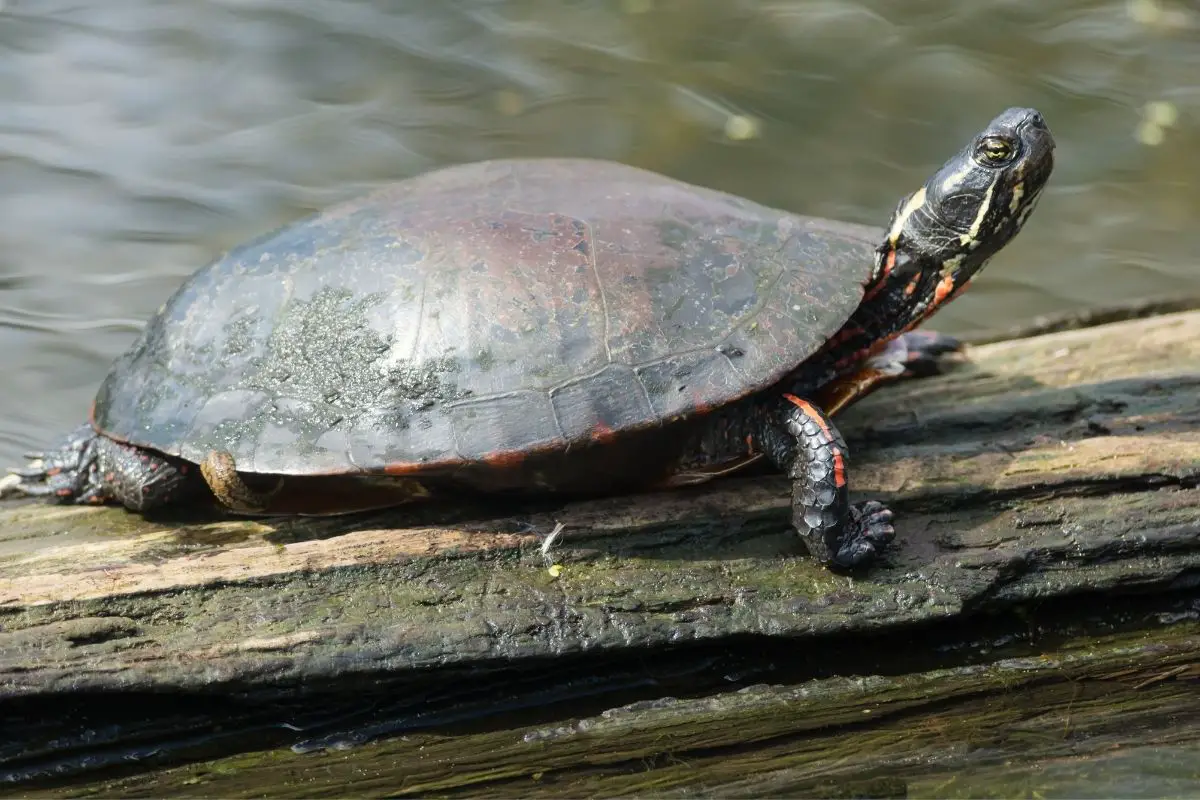
The Midland turtle is a subspecies found along most of the Central USA, as well as in some southern and eastern states.
You can easily spot a Midland Painted Turtle thanks to their black spot in the middle of their lower shell. The rest of the lower shell is yellow, so this spot is sure to stand out.
Again, this turtle is an omnivore and will eat both plants and animals. They live in freshwater habitats including ponds, streams, and rivers.
- Family Name: Emydidae
- Genus Name: Chrysemys
- Binomial Name: Chrysemys Picta Marginata
- Otherwise Known As: Midland Sun Turtles
- Aquatic? Yes
- Maximum Size: Between 4 and 10 inches
- Average Lifespan: Between 30 and 40 years
- Found In The Following States: Alabama, Georgia, Illinois, Indiana, Kentucky, Maryland, Massachusetts, Michigan, New Hampshire, Ohio, Pennsylvania, Tennessee, Vermont, West Virginia, Wisconsin
Southern Painted Turtle
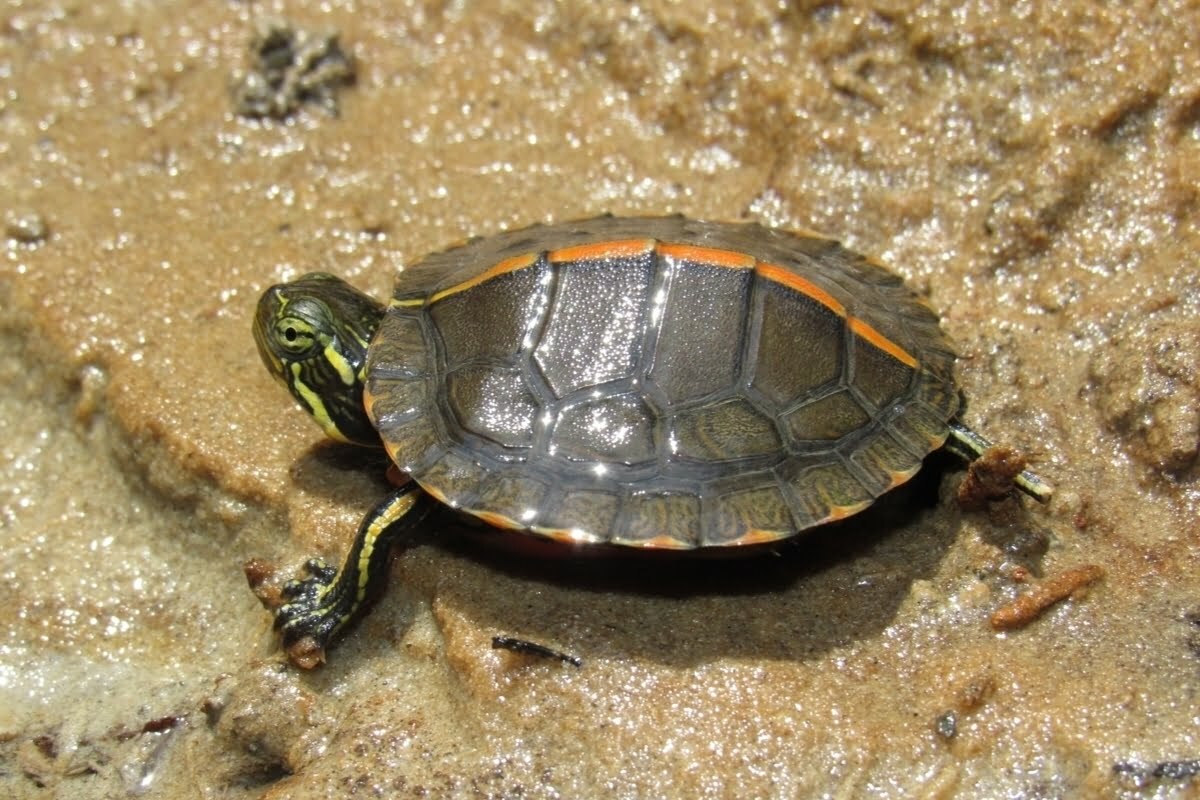
This is the smallest of the subspecies of Painted Turtles, growing only up to 6 inches long. They are native to the southern states of the USA, residing in places with slow moving waters and wetlands.
You can identify these turtles by their distinctive stipe that runs down the entire length of their shell. This will either be a vibrant red, orange, or yellow color.
The Southern Painted Turtle is an omnivore when young, but as they get older they tend to follow a herbivore diet.
- Family Name: Emydidae
- Genus Name: Chrysemys
- Binomial Name: Chrysemys Picta Dorsalis
- Otherwise Known As: Southern Sun Turtles
- Aquatic? Yes
- Maximum Size: Between 4 and 6 inches
- Average Lifespan: Between 30 and 40 years
- Found In The Following States: Alabama, Arkansas, Florida, Georgia, Kentucky, Louisiana, Mississippi, Missouri, Oklahoma, Tennessee, Texas
Snake-Necked And Side-Necked Turtles
African Helmeted Turtle
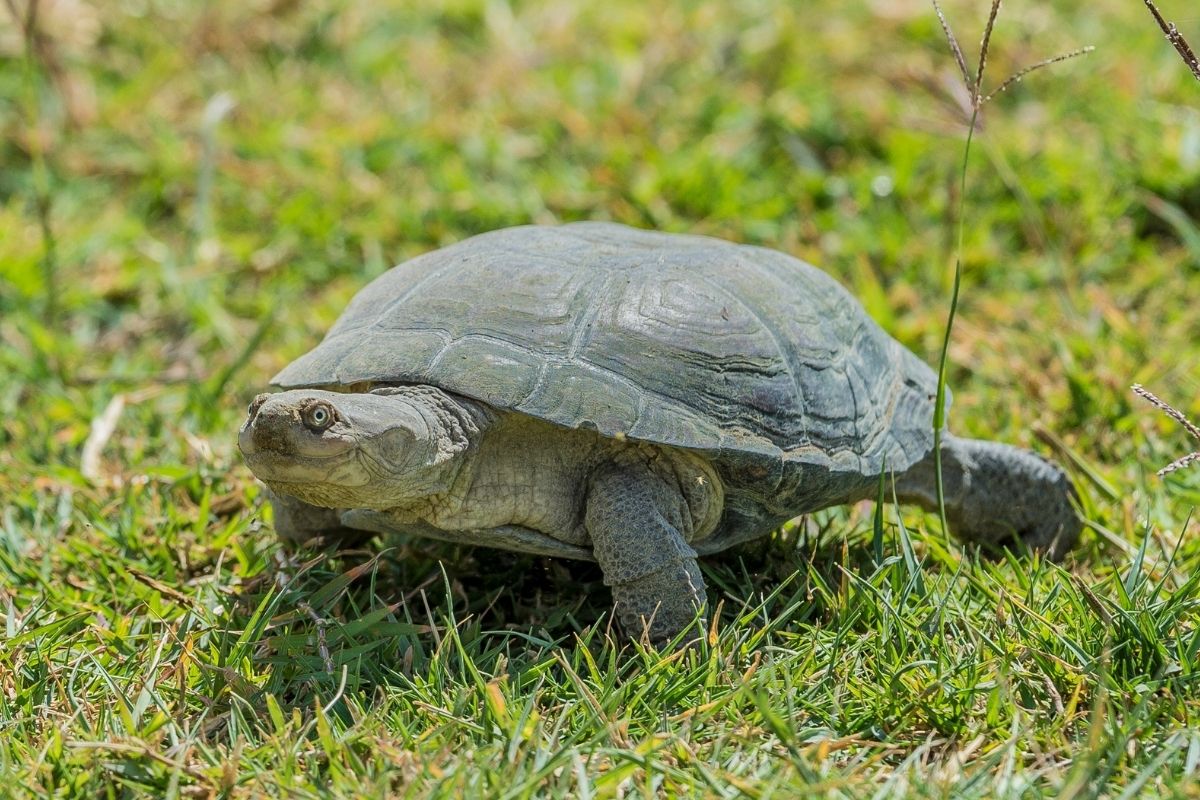
This turtle is commonly misconstrued as the African Side-necked turtle due to them both having a similar name. However, this is not the case. The African Helmeted Turtle is a terrapin while the latter is a mud turtle.
You can only find these turtles in Sub-Saharan Africa as well as Yemen. They thrive in marshes, but will tolerate almost any other body of water as well.
They have brown to black shells with gray skin and a tan belly. Their mouths are upturned to make them look like they are always smiling.
These omnivores love both plants and meat, and they sometimes even get together to target bigger prey such as birds. However, they can also work underwater to consume fish, insects, and other sources of food within.
- Family Name: Pelomedusidae
- Genus Name: Pelomedusa
- Binomial Name: Pelomedusa subrufa
- Otherwise Known As: Crocodile Turtle, African Side-necked turtle, Marsh Terrapin
- Aquatic? Semi-Aquatic
- Maximum Size: 8 Inches
- Average Lifespan: 50 years
Snake-Necked Turtle
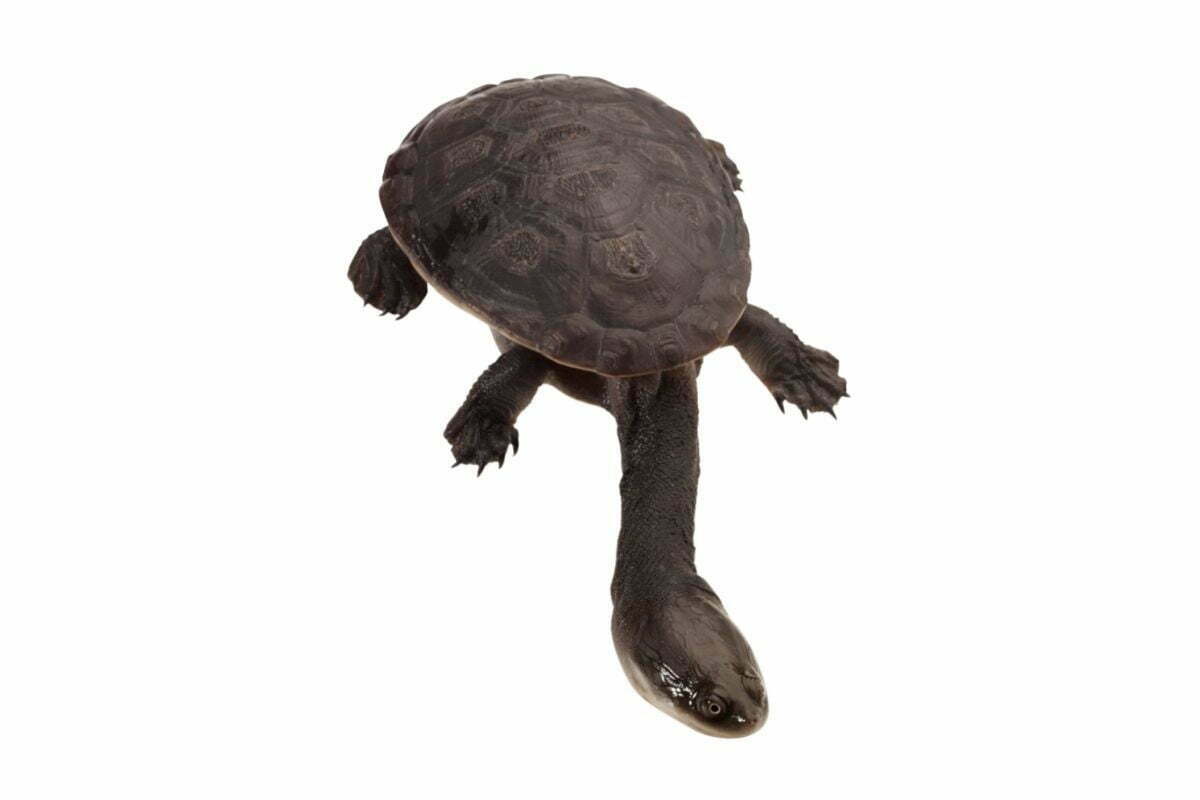
Snake-necked Turtles can be found in Indonesia, Australia, and South America. They are a family of lots of different subspecies, but they are all mostly carnivores and avid hunters. They eat worms, amphibians, fish, mollusks, insects, and more.
These turtles have longer necks than other turtles, and they can draw them into their shells like a snake does. They can also withdraw their necks left and right, which other turtles cannot do, like a snake slithering around.
- Family Name: Chelidae
- Genus Name: Chelodina
- Binomial Name: Multiple Different
- Otherwise Known As: Multiple Different
- Aquatic? Aquatic
- Maximum Size: 18 Inches
- Average Lifespan: 30 years and over
African Side-Necked Turtle
As we mentioned before, this turtle is commonly confused with the African Helmeted Turtle. The African Side-necked Turtle, however, is a mud turtle rather than a terrapin.
You can find this subspecies along slow moving water within West Africa. Swamps are their favorite, along with other waters with soft bottoms such as mud and sand.
Both the skin and shell of this turtle is dark brown or black. They have a dark gray lower shell, too, so they are very dark overall.
However, you might be able to see a lighter mottled patch on the top of their head. Much like the African Helmeted Turtle, these turtles have an upturned mouth to make them look like they are always smiling.
The African Side-necked Turtle is an omnivore and therefore snacks on anything that they come across.
- Family Name: Pelomedusidae
- Genus Name: Pelusios
- Binomial Name: Pelusios Castaneus
- Otherwise Known As: West African Mud Turtle, African Mud Turtle
- Aquatic? Aquatic
- Maximum Size: Between 8 and 10 Inches
- Average Lifespan: 50 years
Eastern Snake-Necked Turtle
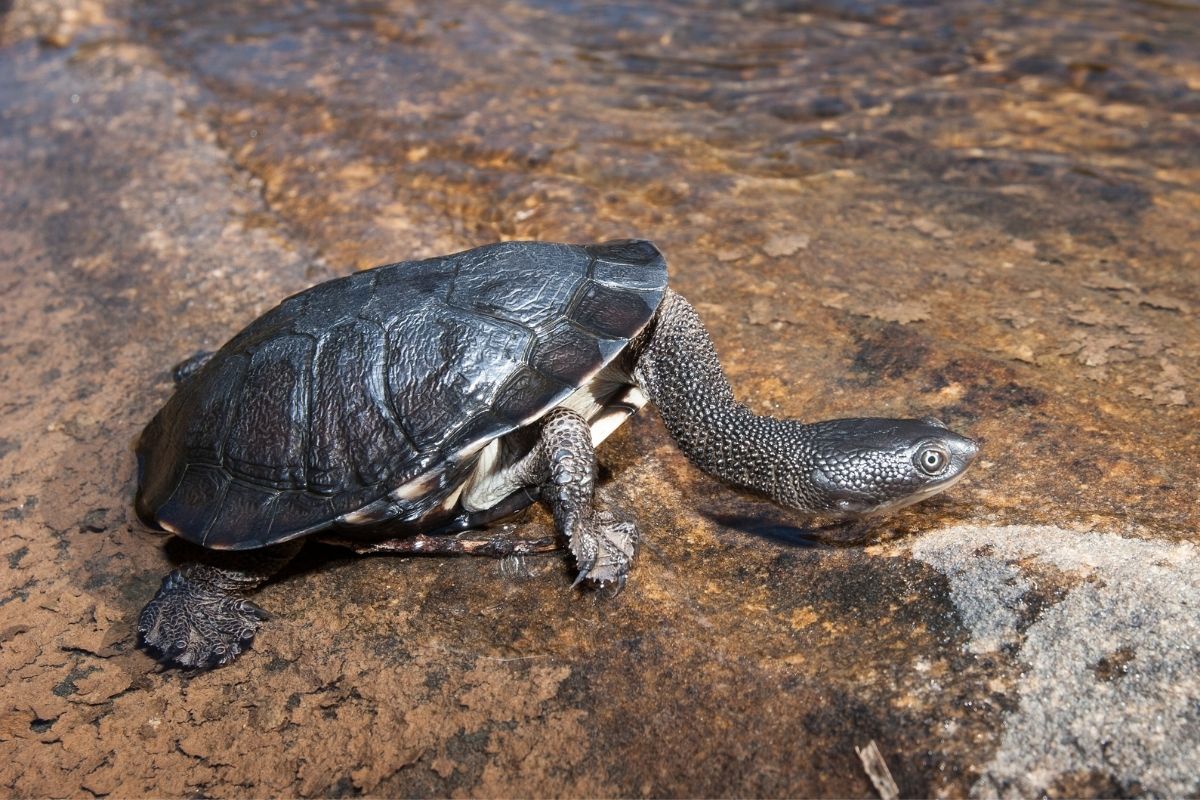
These turtles are native to south east areas of Australia, and they enjoy living on coastal waters that are either stagnant or slow moving. Swamps and marshes are among their favorite habitats to reside in.
You’ll rarely see an Eastern Snake-necked Turtle because they spend the majority of their time at the bottom of the water. Here they will hunt for prey with the help of their unusually long necks.
Their shells will either be black or brown and have a more oval shape than most other turtles. There is a groove in the center of their shell which can help in correctly identifying them.
Their skin is also brown, and they have white bellies with dark lines running along it.
Eastern Snake-necked Turtles are carnivorous and therefore feed on meat wherever possible. Their long necks help them to catch prey with ease, so they won’t be eating much plant matter at all.
- Family Name: Chelidae
- Genus Name: Chelodina
- Binomial Name: Chelodina Longicollis
- Otherwise Known As: Eastern Long-necked Turtle, Common Snake-necked Turtle
- Aquatic? Aquatic
- Maximum Size: Between 9 and 10 Inches
- Average Lifespan: Between 30 and 40 years
Pink-Bellied Side-Necked Turtle
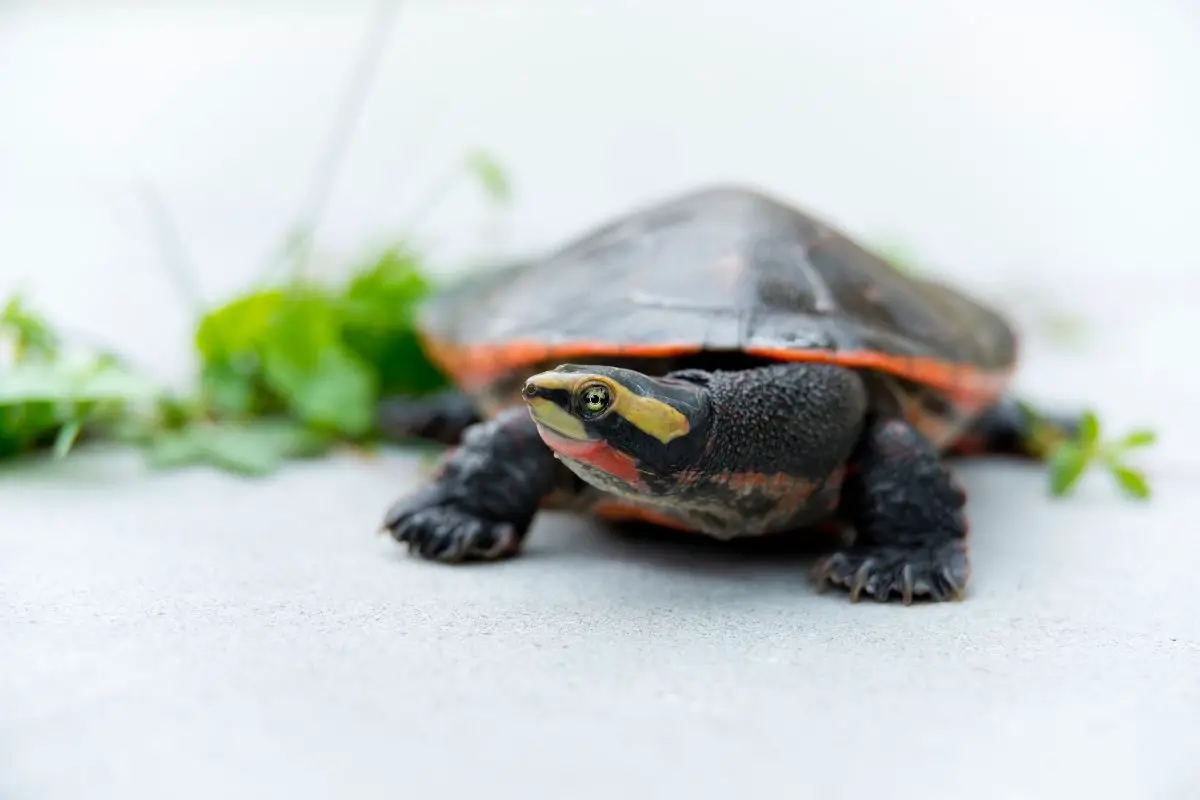
The Pink-bellied Side-necked Turtles (that’s quite a mouthful!) are native to the tropical areas of Australian and Papua New Guinea.
They are very colorful, making them attractive in the pet trade. They have pink or red bellies with yellow stripes along their cheeks.
Their shells are quite flat compared to other turtle species and it is a deep olive green color. These turtles are carnivores and therefore prey on worms, mollusks, and other insects.
You’ll usually find them in warm areas with lots of vegetation to hide in. They’re most likely hanging out in a lagoon.
- Family Name: Chelidae
- Genus Name: Emydura
- Binomial Name: Emydura Subglobosa
- Otherwise Known As: Red-bellied Short-necked Turtle, Jardine River Turtle
- Aquatic? Aquatic
- Maximum Size: Between 5 and 10 Inches
- Average Lifespan: 50 years and over
Snapping Turtles
Common Snapping Turtle
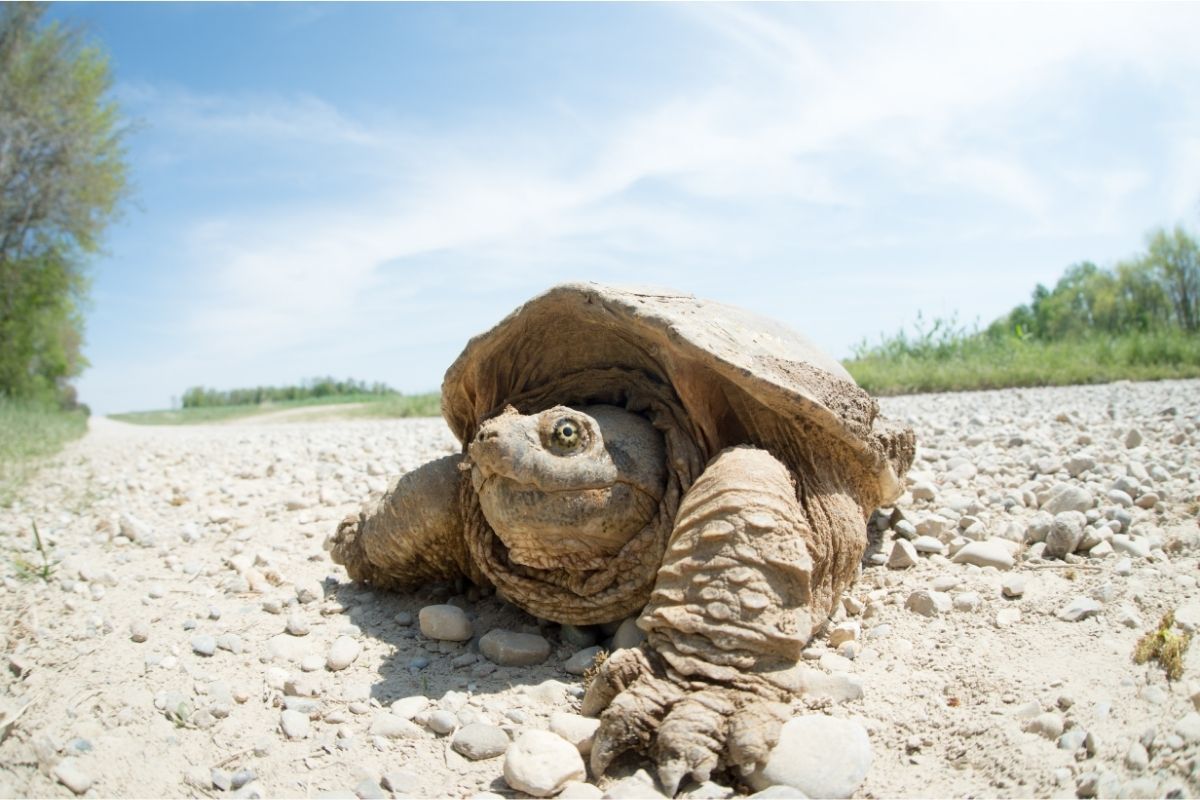
This turtle is one of the most common in the USA and it is found in almost every state. They enjoy freshwater and aren’t afraid to walk to new habitats, even if it’s in another state!
These turtles are so popularized that they have even colonized non-native states, establishing dominance all over the US.
Common Snappers have been known to be aggressive if they think that they are in danger. When cornered, they might hiss or even bite you. They prefer larger areas of water for this reason, so they don’t feel confined or in danger.
You can easily spot a Common Snapping Turtle thanks to their hooked bottom jaw. Their claws are also very long and their tails are covered in spines. They are carnivores and eat lots of different prey, some even as big as certain birds!
- Family Name: Chelydridae
- Genus Name: Chelydra
- Binomial Name: Chelydra Serpentina
- Otherwise Known As: Eastern Snapping Turtle, Common Snapper, Snapper
- Aquatic? Yes
- Maximum Size: Between 10 and 19 Inches
- Average Lifespan: Between 40 and 50 years
- Found In The Following States: Alabama, Arizona, Arkansas, California, Colorado, Connecticut, Delaware, Florida, Georgia, Illinois, Indiana, Iowa, Kansas, Kentucky, Louisiana, Maine, Maryland, Massachusetts, Michigan, Minnesota, Mississippi, Missouri, Montana, Nebraska, Nevada, New Hampshire, New Jersey, New Mexico, New York, North Carolina, North Dakota, Ohio, Oklahoma, Oregon, Pennsylvania, Rhode Island, South Carolina, South Dakota, Tennessee, Texas, Utah, Vermont, Virginia, Washington, West Virginia, Wisconsin, Wyoming
Alligator Snapping Turtle
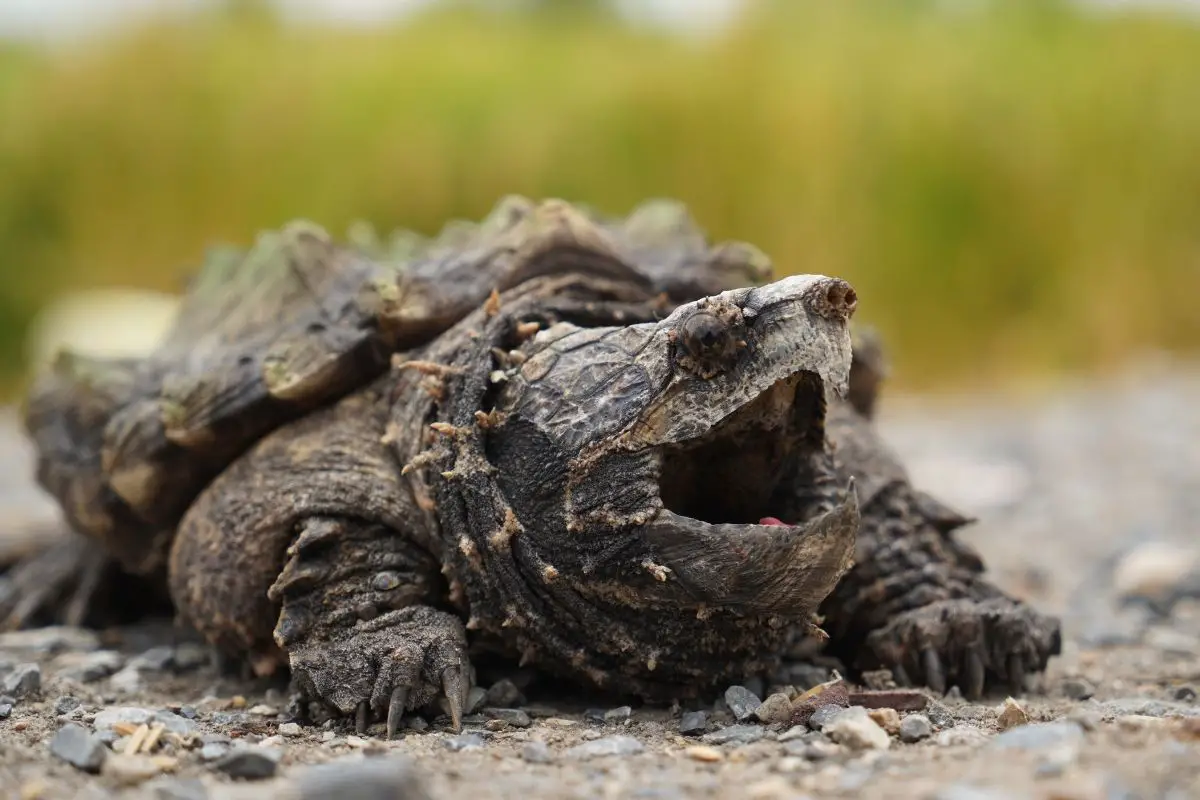
This is the largest turtle species that lives in freshwater in the world! They have an appearance likened to a dinosaur, so something much different to turtles that you’re used to seeing!
However, this does mean that they are very easy to correctly identify when you see one.
They have a large head with a short neck, and they have a big body with broad flippers. Their beak is pointed and sharp. They use this beak to grab onto fish and other aquatic creatures and eat it, as they are carnivores.
You won’t often see an Alligator Snapping Turtle as they tend to live at the bottom of deep waters, and rarely make their way to the surface.
- Family Name: Chelydridae
- Genus Name: Macrochelys
- Binomial Name: Macrochelys Temminckii
- Otherwise Known As: Loggerhead Snapper, Alligator Snapper
- Aquatic? Aquatic
- Maximum Size: Between 13 and 31 Inches
- Average Lifespan: Between 20 and 70 years
- Found In The Following States: Alabama, Arkansas, Florida, Georgia, Illinois, Indiana, Kansas, Kentucky, Louisiana, Mississippi, Missouri, Oklahoma, Tennessee, Texas, Wyoming
Softshell Turtles
Florida Softshell Turtle
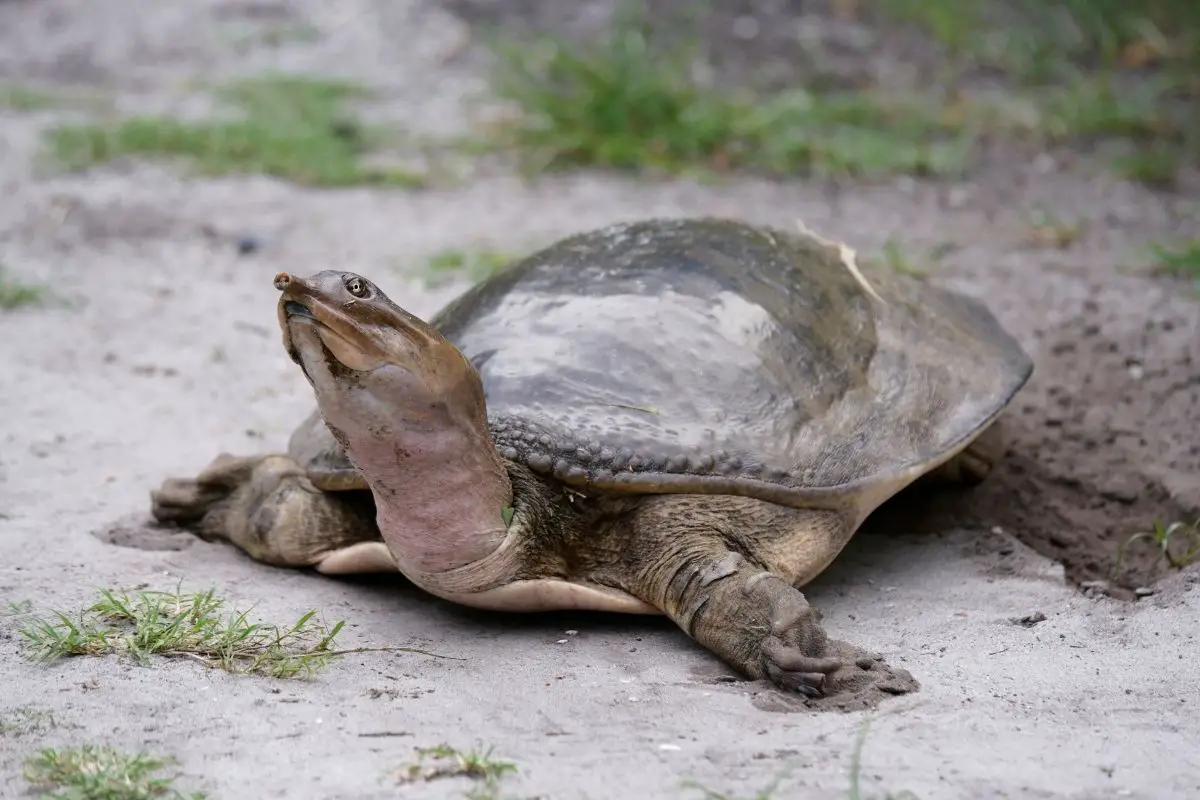
This is the largest subspecies of softshell turtles to be found in America, and they are mainly confined to Florida. However, they can also be found in other southeast states.
People have likened the Florida Softshell Turtle to leathery pancakes thanks to their incredibly flat brown shells.
The Florida Softshell Turtle has a long snout that looks like a snorkel, making it quite easy to identify. They enjoy stagnant or slow waters with soft bottoms.
Here they can burrow and hide from their prey before hunting. These turtles are carnivores and therefore eat any meat source that they can find underwater.
- Family Name: Trionychidae
- Genus Name: Apalone
- Binomial Name: Apalone Ferox
- Otherwise Known As: Not Known
- Aquatic? Aquatic
- Maximum Size: Between 6 and 24 Inches
- Average Lifespan: 30 years and over
- Found In The Following States: Alabama, Florida, Georgia, South Carolina
Spiny Softshell Turtle
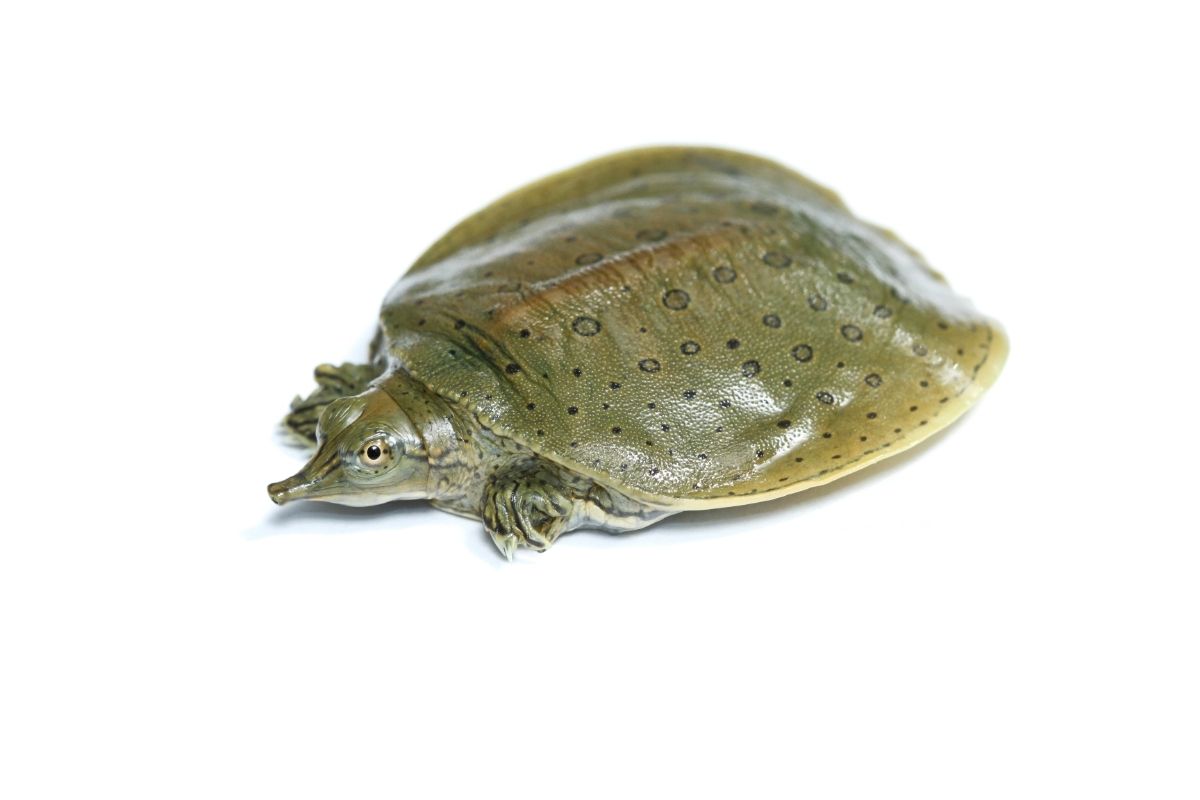
Another turtle species that is widely seen all over the US, the Spiny Softshell Turtle is more common than the Smooth Softshell.
There are many subspecies of this turtle and they all over quick waters. They can swim very quickly and can be aggressive if challenged.
Again, they have leathery soft shells with black spots along it. The shell is rough to touch – some would even say spiky. Their noses are long and beak-like, and they eat a meat only diet.
- Family Name: Trionychidae
- Genus Name: Apalone
- Binomial Name: Apalone Spinifera
- Otherwise Known As: Not Known
- Aquatic? Aquatic
- Maximum Size: Between 5 and 18 Inches
- Average Lifespan: Between 20 and 50 years
- Found In The Following States: Alabama, Arizona, Arkansas, California, Colorado, Florida, Georgia, Illinois, Indiana, Iowa, Kansas, Kentucky, Louisiana, Maryland, Michigan, Minnesota, Mississippi, Missouri, Montana, Nebraska, Nevada, New Jersey, New Mexico, New York, North Carolina, North Dakota, Ohio, Oklahoma, Pennsylvania, South Carolina, South Dakota, Tennessee, Texas, Utah, Vermont, Virginia, Washington, West Virginia, Wisconsin, Wyoming
Black Softshell Turtle
You’ll only be able to find the Black Softshell Turtle in rivers running through Bangladesh and India. They require very specific homes and are very finicky about where they reside. Due to this, they have now become a critically endangered species.
As you can guess from their name, these turtles have black shells that are leathery and soft rather than the usual hard shells that you associate with turtles.
Their noses are also shaped like snorkels, allowing them to breathe easily underwater, even when buried in thick vegetation.
The Black Softshell Turtle is a very friendly species and often interacts with local people living near their habitats. They are almost completely dependent on humans coming to feed them instead of hunting for their prey themselves.
- Family Name: Trionychidae
- Genus Name: Nilssonia
- Binomial Name: Nilssonia Nigricans
- Otherwise Known As: Bostami Turtle
- Aquatic? Yes
- Maximum Size: Between 15 and 35 Inches
- Average Lifespan: 50 years
Chinese Softshell Turtle
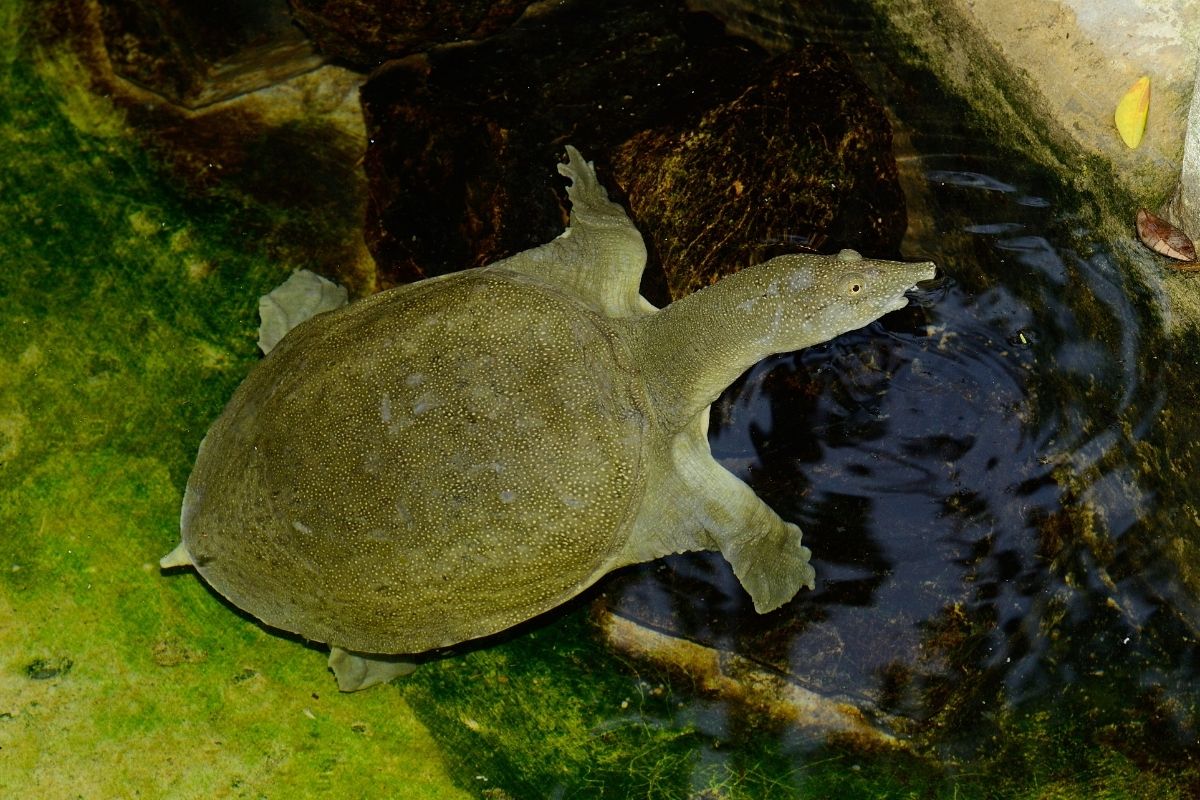
Chinese Softshells can be found in China and some other parts of Eastern Asia. However, they have also been successfully implemented in other countries such as Brazil, Spain, and the state of Hawaii.
While they are used predominantly as a food source in China, they are not so commonly used as food in other parts of the world.
While being used as a food source has made them one of the more economically beneficial turtle species in the world, it has also landed them with the title of vulnerable species.
The Chinese Softshell has a green leathery shell that often comes littered with black dots. Their skin is commonly mottled as well. They are carnivores, so they eat fish, insects, worms, and any other meat that they can find.
- Family Name: Trionychidae
- Genus Name: Pelodiscus
- Binomial Name: Pelodiscus Sinensis
- Otherwise Known As: Not Known
- Aquatic? Yes
- Maximum Size: Between 10 and 13 Inches
- Average Lifespan: 25 years and over
- Found In The Following States: Hawaii
African Softshell Turtle
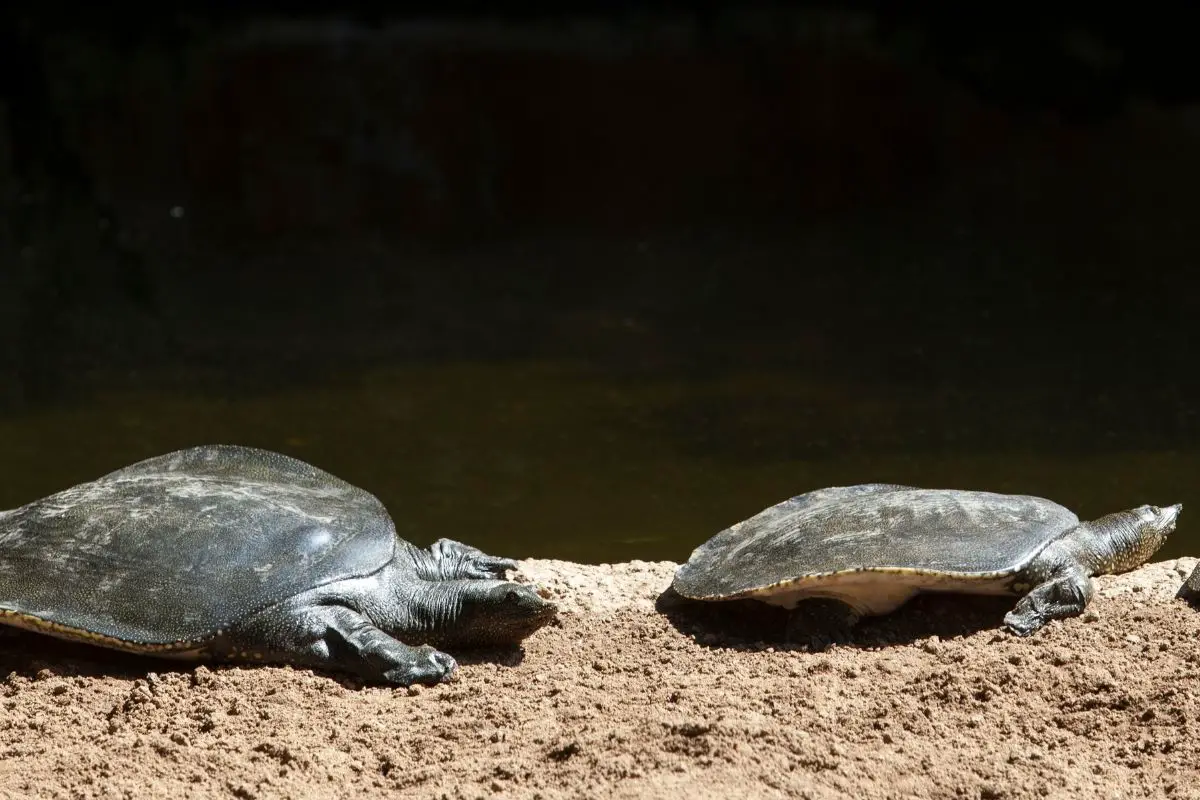
The African Softshell is another very large turtle that enjoys spending most of its time in the water.
It is native to Middle Eastern countries such as Lebanon, Turkey, Syria, and Israel. The African Softshell is the only subspecies of its genus still alive – all the others are now extinct.
They enjoy living in all sorts of water types, including both freshwater and brackish waters. They’ll be more common in waters near the coastline. They are carnivores and therefore eat any meat that they find underwater as well as on land.
The African Softshell Turtles have flat, leather-like shells that are brown in color with little white flecks all over them. Their skin also includes this flecked pattern. Their lower shell is white, too.
- Family Name: Trionychidae
- Genus Name: Trionyx
- Binomial Name: Trionyx Triunguis
- Otherwise Known As: Nile Softshell Turtle
- Aquatic? Yes
- Maximum Size: Between 33 and 37 Inches
- Average Lifespan: Between 25 and 45 years
Smooth Softshell Turtle
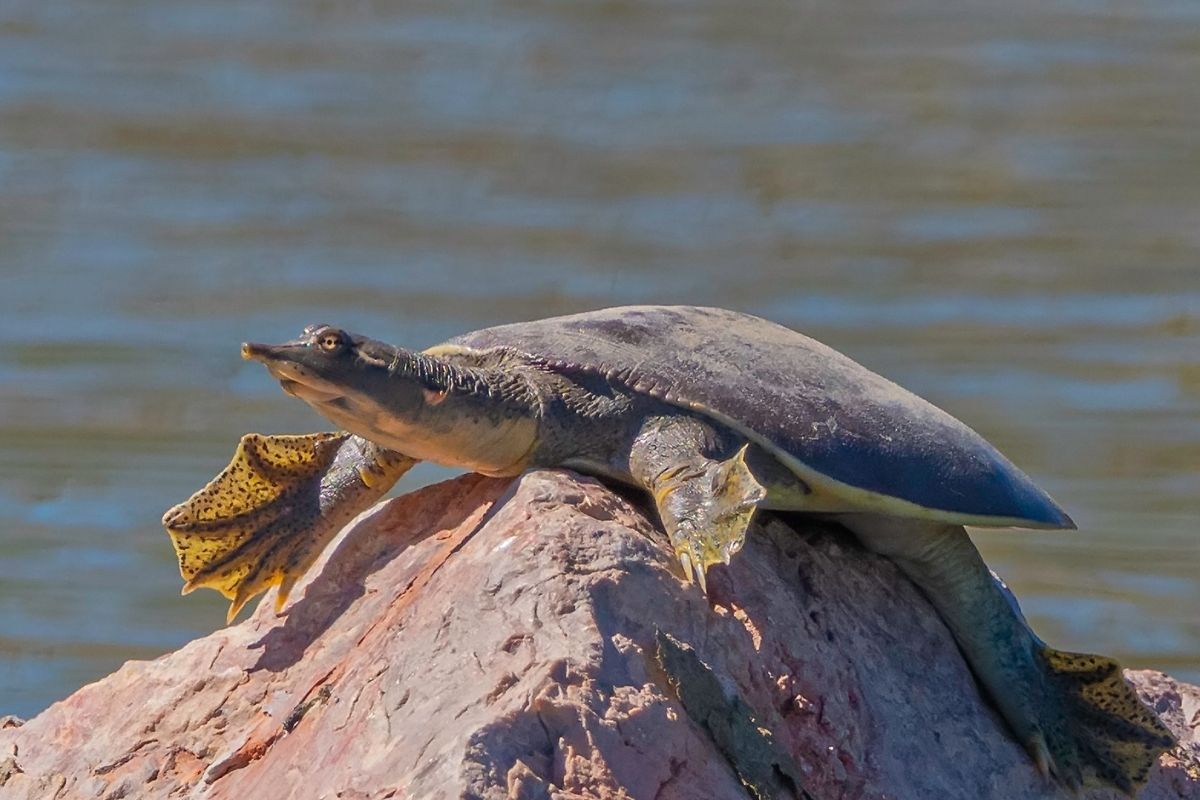
You will be able to see these turtles all over the United States, and it even has its own subspecies – the Midland Smooth Softshell Turtle (Apalone Mutica Mutica), and the Gulf Coast Smooth Softshell Turtle (Apalone Mutica Calvata).
We’ll let you figure out where you can find these subspecies!
The Smooth Softshell is a quick turtle that can run and swim faster than you imagine. They have a leathery shell that is easily malleable, which can be unsettling at times.
It will either be brown or dark gray, and its snout will be tapered and long. These carnivores love all kinds of meat.
- Family Name: Trionychidae
- Genus Name: Apalone
- Binomial Name: Apalone Mutica
- Otherwise Known As: Not Known
- Aquatic? Aquatic
- Maximum Size: Between 4.5 and 14 Inches
- Average Lifespan: 20 years and over
- Found In The Following States: Alabama, Arizona, Florida, Illinois, Indiana, Iowa, Kansas, Kentucky, Louisiana, Minnesota, Mississippi, Missouri, Nebraska, New Mexico, North Dakota, Ohio, Oklahoma, Pennsylvania, South Dakota, Tennessee, Texas, West Virginia, Wisconsin
Indian Peacock Softshell Turtle
There is very little known about the Indian Peacock Softshell turtle, other than the fact that it is on the vulnerable species list. It is native to Bangladesh and India, so will only be seen in rivers within these countries.
It is illegal to have these turtles as pets in their native countries. However, some are kept in temples within small pools for religious purposes.
Their shells are dark green in color and leathery to look at and to touch. They have yellow spots along the circumference of their shell, with darker colored patches all over the rest of their shell.
Their skin will be the same color as their shell and their noses are like snorkels. The Indian Peacock Softshell is nocturnal, meaning that they hunt at night for their meaty prey.
- Family Name: Trionychidae
- Genus Name: Nilssonia
- Binomial Name: Nilssonia Hurum
- Otherwise Known As: Not Known
- Aquatic? Yes
- Maximum Size: 23 Inches
- Average Lifespan: Not Known
Wood Turtles
Wood Turtle
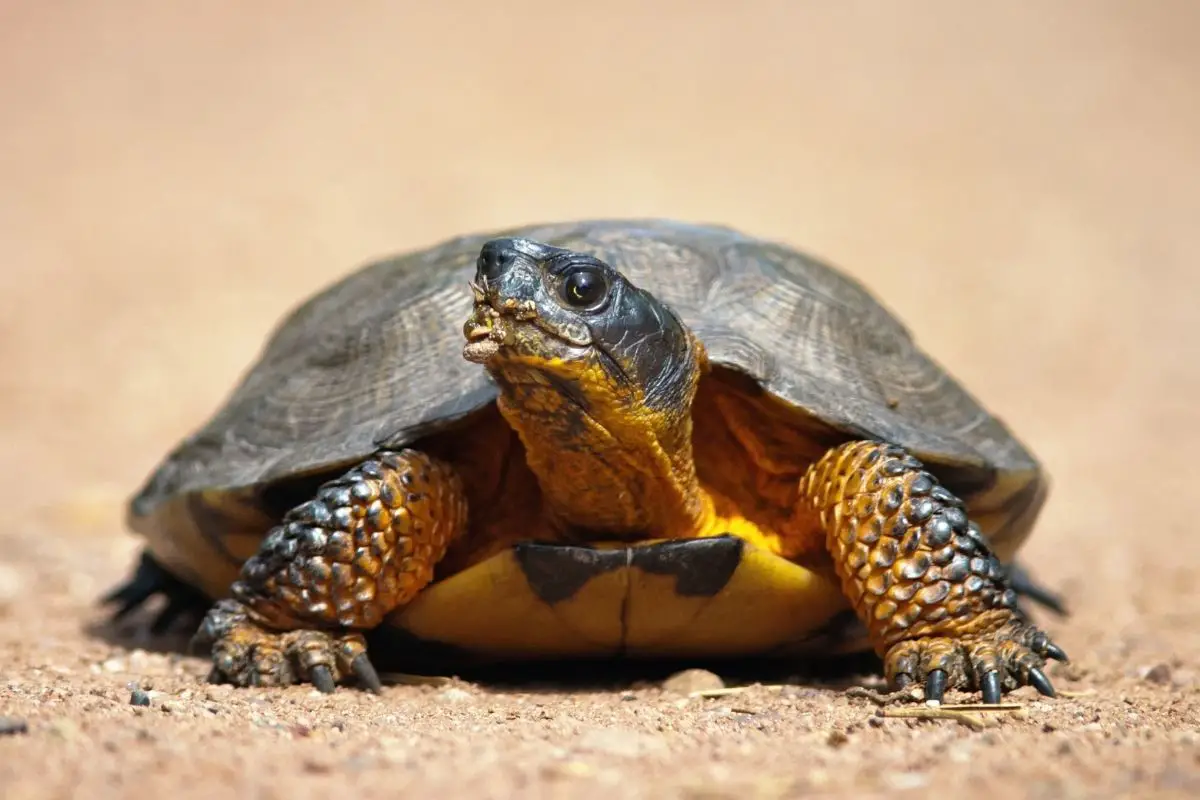
This group of turtles are all diverse and have their own unique qualities. They can be found all over North and South America, with the Glyptemys genus being more popular in the northern region.
South and central America see higher volumes of the Rhinoclemmys genus.
You will typically see these turtles in forest settings, as long as there is a water source nearby. Their shells tend to have a carved appearance like someone has sculpted it out of wood. These turtles are mostly omnivores, following a plant and meat diet.
We have also included the Bog, Blanding’s, and Spotted Turtle in this section as, while they are not technically Wood Turtles, they are very similar.
- Family Name: Emydidae and Geoemydidae
- Genus Name: Glyptemys and Rhinoclemmys
- Binomial Name: Multiple Different
- Otherwise Known As: Multiple Different
- Aquatic? Semi-Aquatic
- Maximum Size: Between 4 and 12 Inches
- Average Lifespan: Between 20 and 60 years
Matamata Turtle
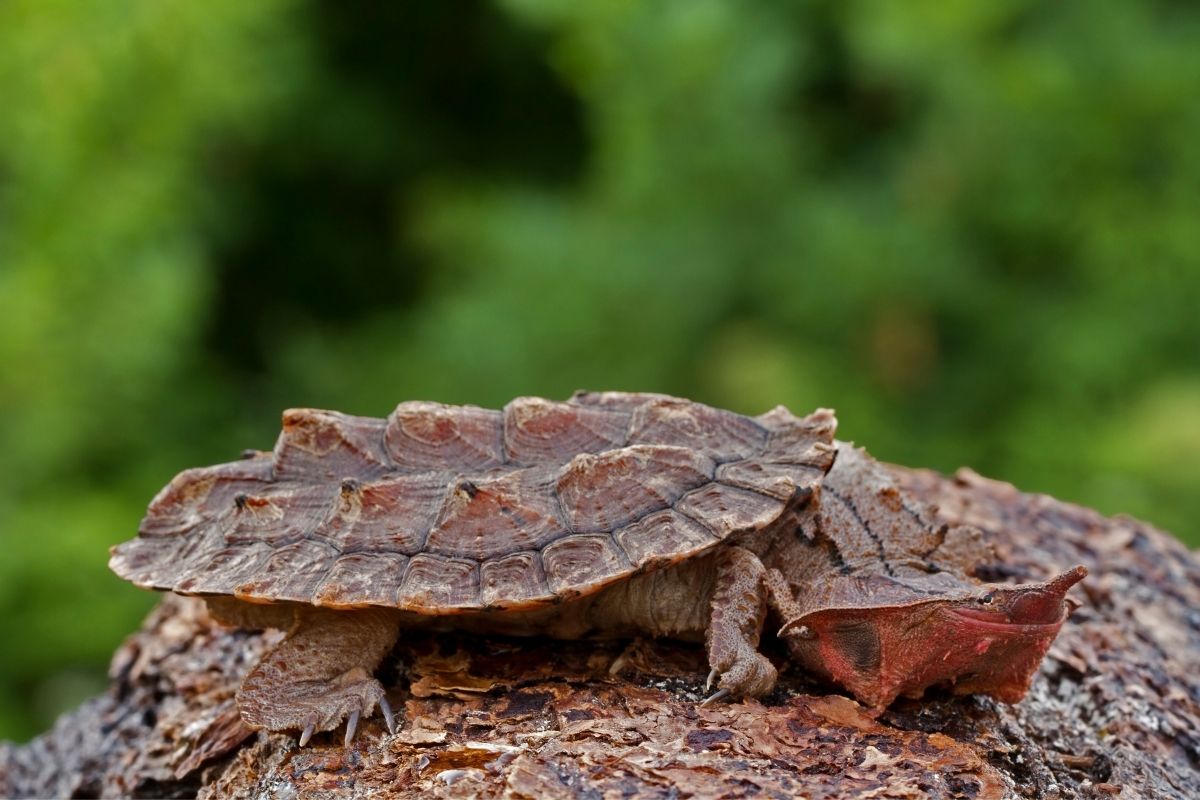
Matamata Turtles are bigger than most turtle species and they love swimming in fresh waters within the Amazon and Orinoco rivers.
They enjoy stagnant or slow waters such as swamps, however, so you’ll more likely see them around these areas. They’ll be around the shallows of the water with their noses sticking out.
Their heads are a triangular shape with spikes sticking out of it. They are very different in appearance to the majority of other turtles in the world. Their shells are dark brown with spiked edges. You wouldn’t want to come too close to one of these guys!
They are covered in a mottled pattern that resembles leaves, allowing them to hide and wait for their prey to walk past while remaining undetected. Once they have spotted their prey, they will create a vacuum suction with their mouth and draw it in.
Matamata Turtles cannot chew so they will swallow their prey whole. These turtles are carnivores and mainly exist on a diet of small fish.
- Family Name: Chelidae
- Genus Name: Chelus
- Binomial Name: Chelus Fimbriata
- Otherwise Known As: Not Known
- Aquatic? Yes
- Maximum Size: 20 Inches
- Average Lifespan: Between 40 and 75 years
Spotted Turtle
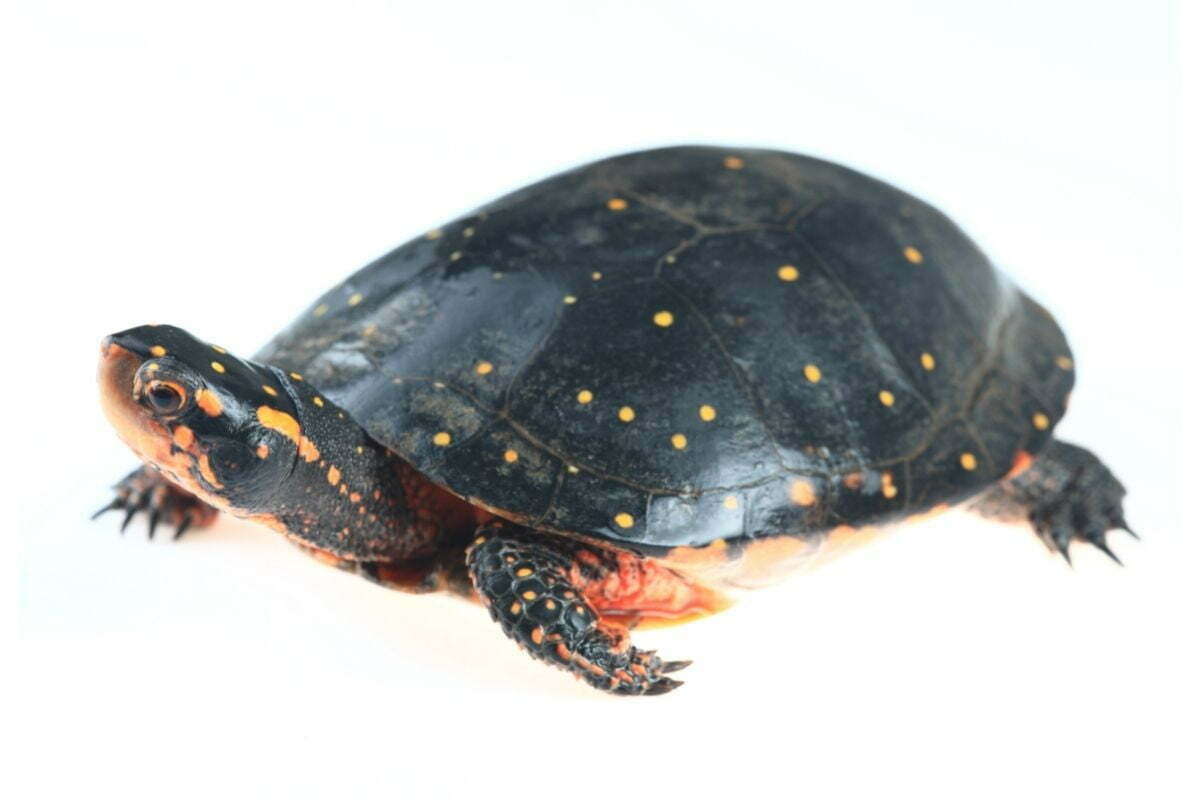
Spotted Turtles are native to eastern states within North America, although they have also been spotted (get it?) in some regions of the midwest. They thrive in bogs and marshes, or any other areas that have shallow waters.
This turtle has been classified as endangered due to habitat loss. While these turtles are not necessarily Wood Turtles, they are very similar to them.
Spotted Turtles have black shells with not much texture on them, and they are littered with lots of neon yellow patches. They also have yellow lower shells with black spots on them. These turtles are also omnivores.
- Family Name: Emydidae
- Genus Name: Clemmys
- Binomial Name: Clemmys Guttata
- Otherwise Known As: Not Known
- Aquatic? Semi-Aquatic
- Maximum Size: Between 4 and 5 Inches
- Average Lifespan: 25 years
- Found In The Following State: Connecticut, Delaware, Florida, Georgia, Illinois, Indiana, Maine, Maryland, Massachusetts, Michigan, New Hampshire, New Jersey, New York, North Carolina, Ohio, Pennsylvania, Rhode Island, Vermont, Virginia, West Virginia
Bog Turtle
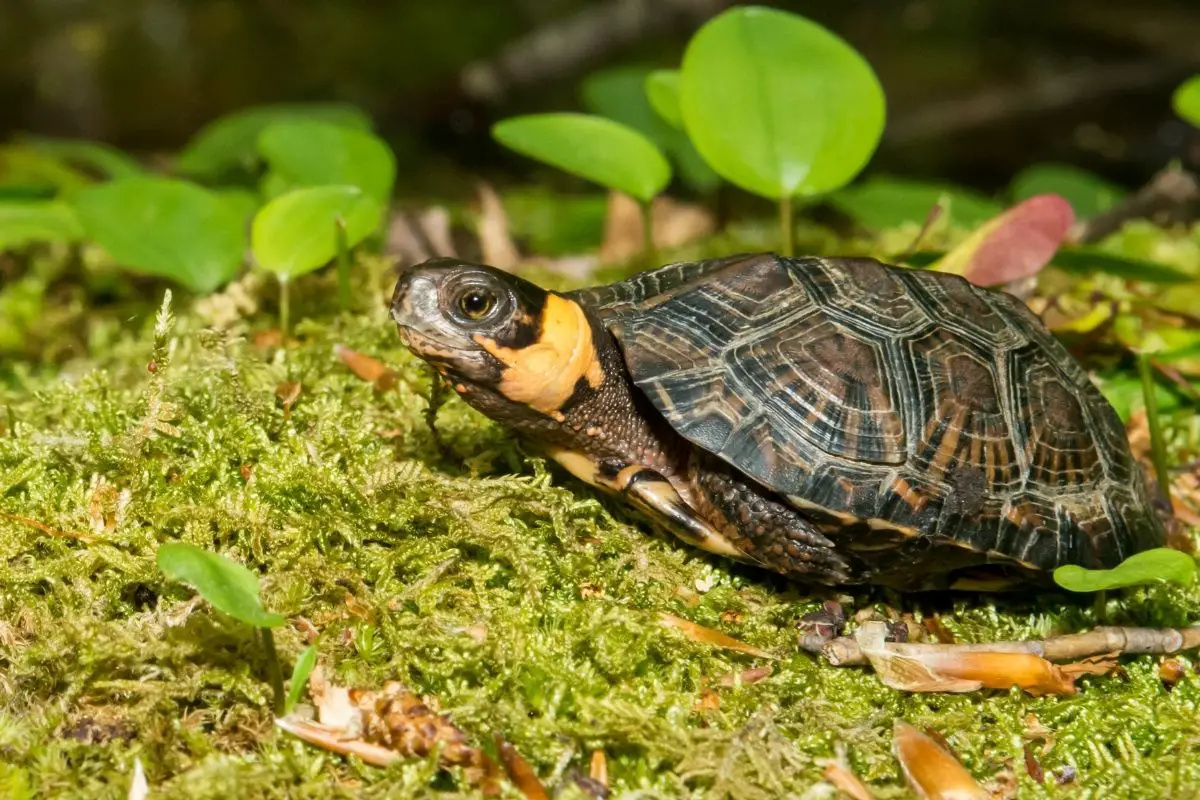
The Bog Turtle is the smallest species of turtle found in the USA, and it will generally reside in wetlands in the eastern and southern states.
Anywhere with ferns or bogs will be a good place to start when looking for this turtle. However, as they are critically endangered, you might not find them at all.
Their shells feature prominent keels and are either olive green or black. Their skin might have yellow or red patterns on it, as will their shells. They are omnivores but have a preference for meat sources such as insects and mollusks.
- Family Name: Emydidae
- Genus Name: Glyptemys
- Binomial Name: Glyptemys Muhlenbergii
- Otherwise Known As: Muhlenberg’s Turtle
- Aquatic? Semi-Aquatic
- Maximum Size: Between 3 and 5 Inches
- Average Lifespan: 40 years and over
- Found In The Following States: Connecticut, Georgia, Maryland, Massachusetts, New Jersey, New York, North Carolina, Pennsylvania, South Carolina, Tennessee, Virginia
Blanding’s Turtle
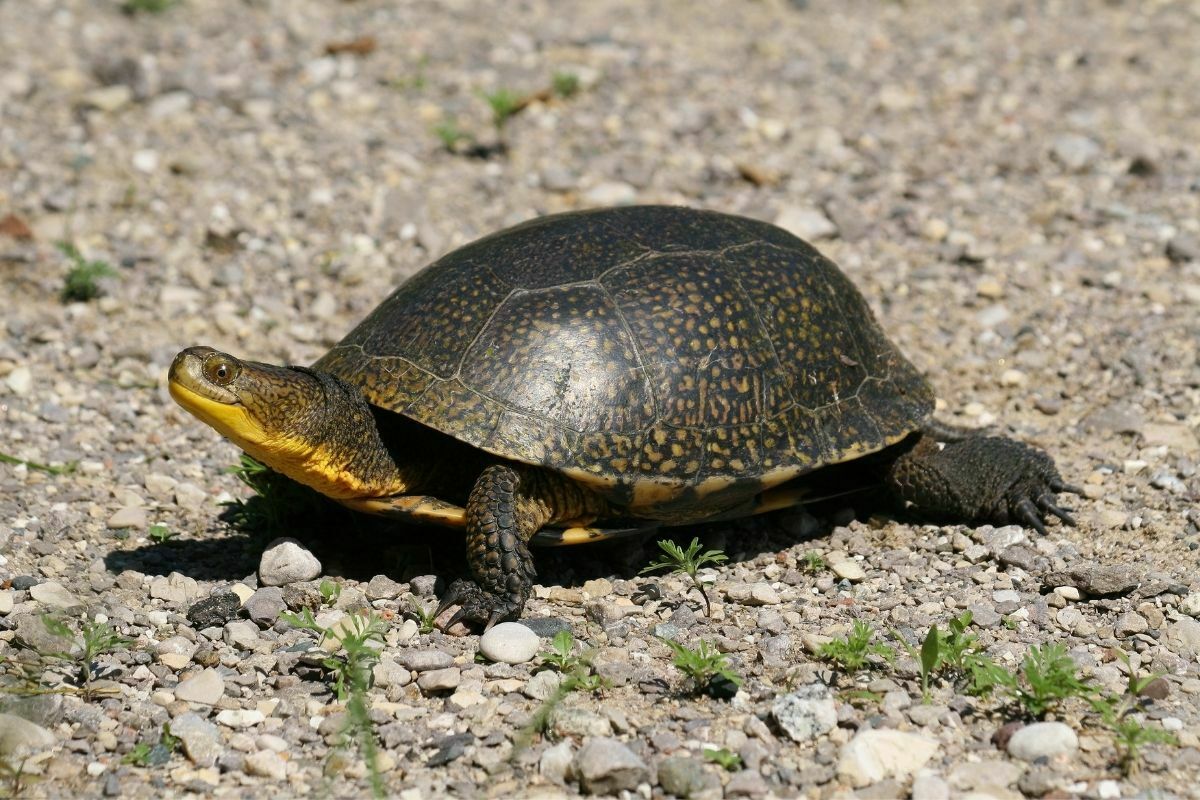
The Blanding’s Turtle is a semi-aquatic species, meaning it likes to share its time between the water and land.
It was named after William Blanding, a naturalist, and has yellow bellies with black spots along them. They can live for an impressively long time without showing any signs of aging.
You’ll most commonly be able to find a Blanding’s Turtle in wetlands as well as some marshes.
They’re now on the endangered species list, despite being very skittish and diving into the safety of water at the first sign of trouble. The Blanding’s Turtle is an omnivore.
- Family Name: Emydidae
- Genus Name: Emydoidea
- Binomial Name: Emydoidea blandingii
- Otherwise Known As: Not Known
- Aquatic? Semi-Aquatic
- Maximum Size: 10 Inches
- Average Lifespan: 100 years
- Found In The Following States: Illinois, Indiana, Iowa, Maine, Massachusetts, Michigan, Minnesota, Missouri, Nebraska, New Hampshire, New York, Ohio, Pennsylvania, South Dakota, Wisconsin
Pig-Nosed Turtle
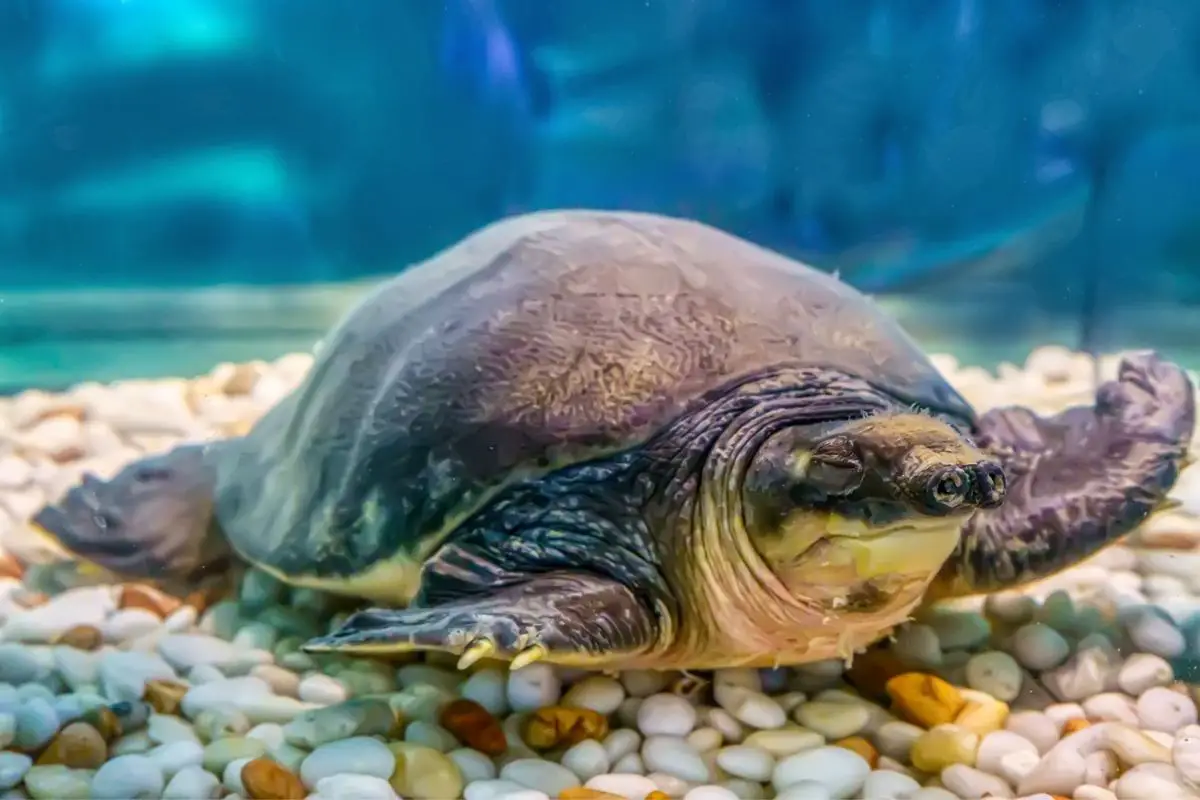
The Pig-nosed Turtle is another endangered species of turtle, and it is native to Australia and some areas within New Guinea. It has a striking similarity to a sea turtle, and loves freshwater such as rivers and lagoons.
They get their names from their snouts that look like that of a pig. These noses also give them an amazing sense of smell and the ability to breathe underwater.
Their shells are olive green with a leather-like texture. They are omnivores, although they have a preference for vegetation.
- Family Name: Carettochelyidae
- Genus Name: Carettochelys
- Binomial Name: Carettochelys insculpta
- Otherwise Known As: Pitted-shelled Turtle, Fly River Turtle
- Aquatic? Yes
- Maximum Size: 28 Inches
- Average Lifespan: 30 years
Ornate Wood Turtle
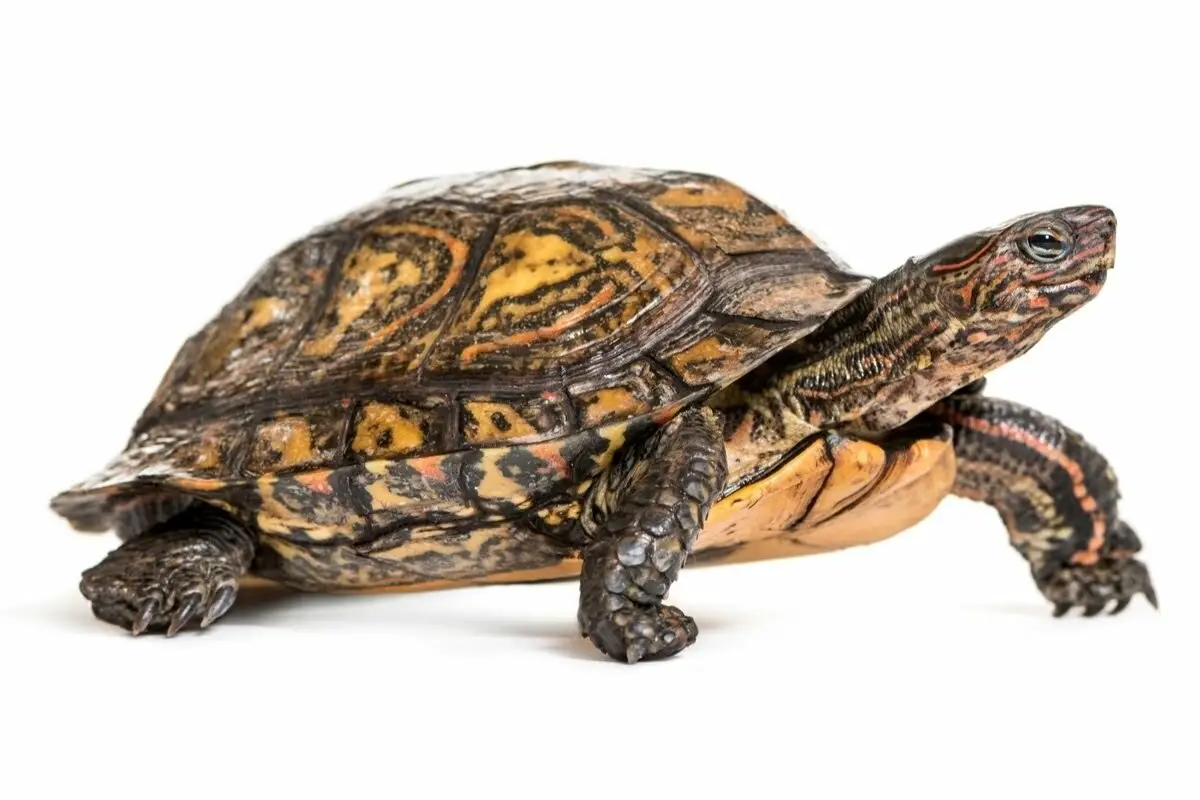
The Ornate Wood Turtle is often otherwise known as the Painted Wood Turtle.
They are semi-aquatic, spending equal amounts of time on land and in water, and they are native to central parts of America such as Mexico and Costa Rica. They love bodies of water in rainforests, so this is the best place to find them.
Their shells are dark brown with tan or orange mottling. They look as though they have been carved from wood, and their lower shells are yellow. These turtles are omnivores and therefore eat anything they find on their journey.
- Family Name: Geoemydidae
- Genus Name: Rhinoclemmys
- Binomial Name: Rhinoclemmys Pulcherrima
- Otherwise Known As: Painted Wood Turtle
- Aquatic? Semi-Aquatic
- Maximum Size: Between 5 and 8 Inches
- Average Lifespan: Between 20 and 30 years
Central American Wood Turtle
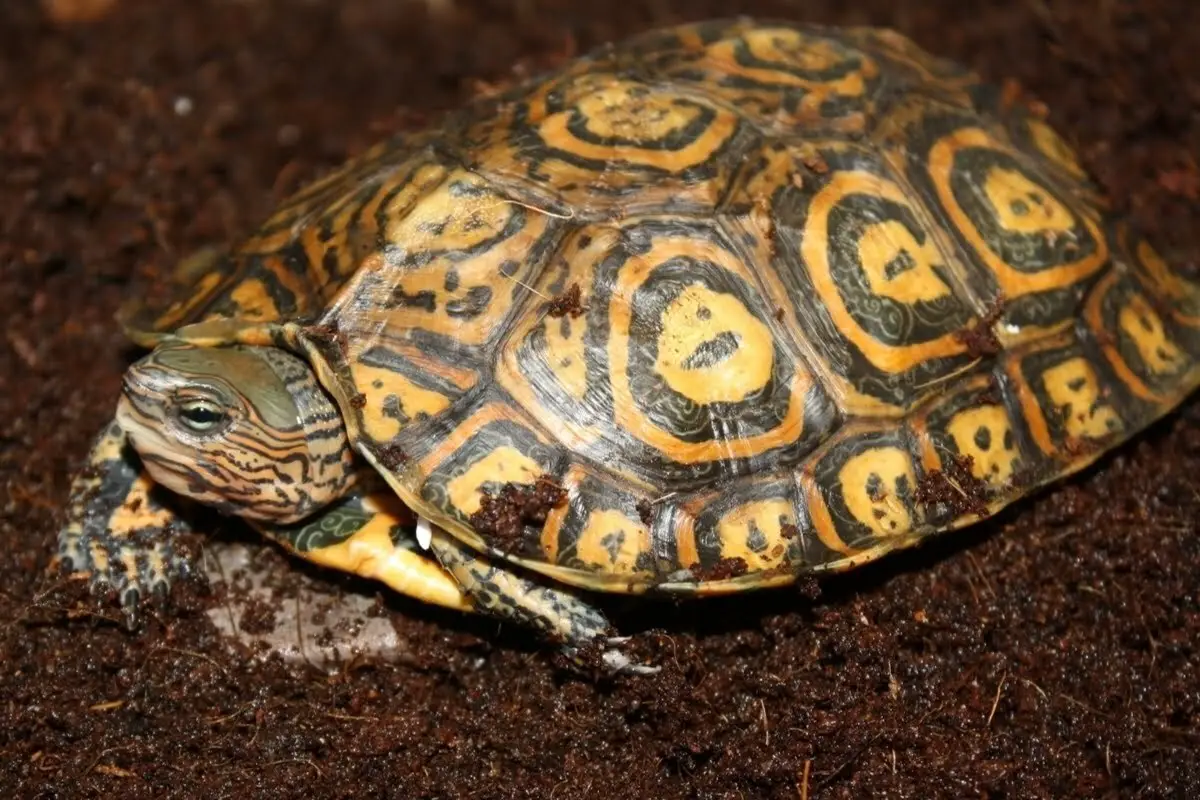
This subspecies of turtle comes from the Ornate Wood Turtle, and are native to some parts of Mexico. You can find them in Oaxaca and Guerrero, in the dry and humid woodlands.
You’ll most likely see Central American Wood Turtles near a river or stream as they never stray too far away from the water.
Their shells are intricately sculpted with mottled red or light brown patterns. They also have dark brown skin with yellow bellies. Their diet is classed as omnivorous, and they will eat anything from fruit to fish.
- Family Name: Geoemydidae
- Genus Name: Rhinoclemmys
- Binomial Name: Rhinoclemmys Pulcherrima Manni
- Otherwise Known As: Not Known
- Aquatic? Semi-Aquatic
- Maximum Size: Between 4 and 12 Inches
- Average Lifespan: Between 20 and 30 years
Big-Headed Turtle
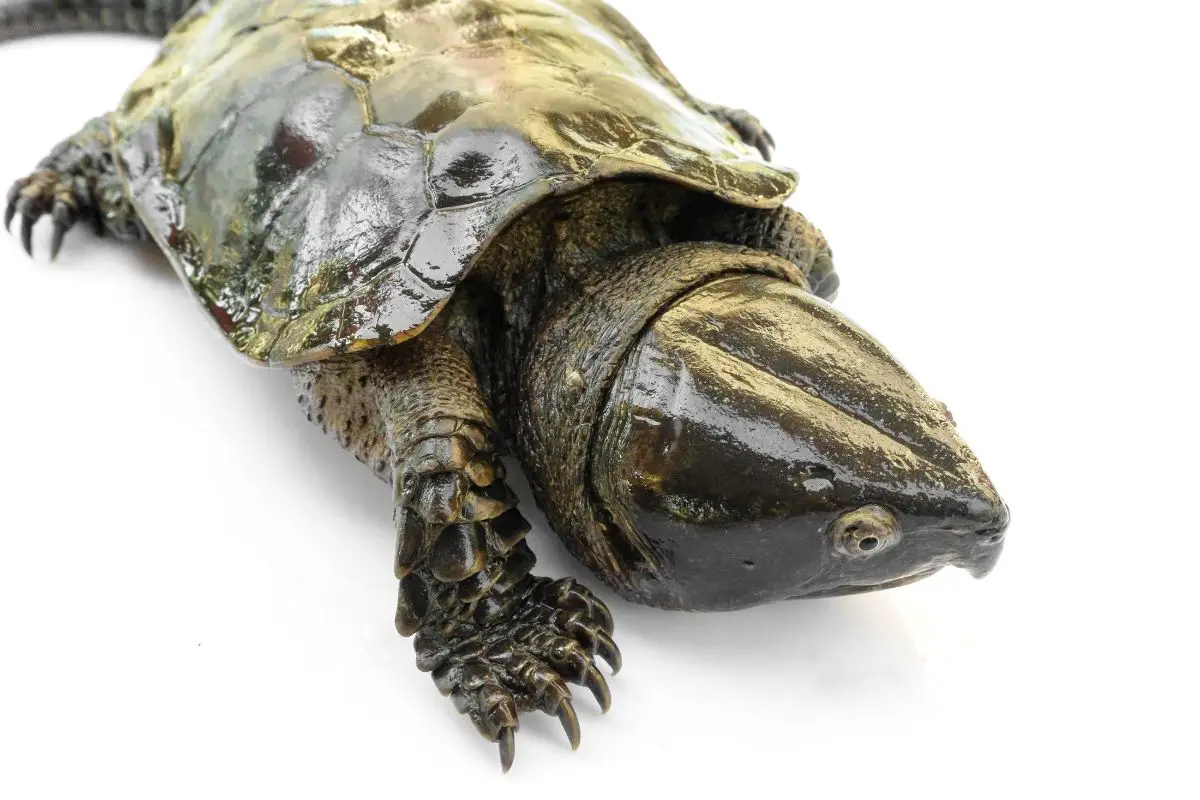
The Big-headed Turtle is native to Eastern Asian countries such as China, Thailand, Cambodia, Laos, and Vietnam.
They enjoy quick-moving water such as streams, despite not being the greatest swimmers. However, if they were to get into any trouble they can quickly climb up trees or rocks with ease.
They have larger heads than normal, which is where they get their names from, that allow them to be better climbers than most turtle species.
However, the size of their heads prevent them from being able to retract them into their shells. They have strong and sharp claws to fend for themselves.
- Family Name: Platysternidae
- Genus Name: Platysternon
- Binomial Name: Platysternon Megacephalum
- Otherwise Known As: Not Known
- Aquatic? Yes
- Maximum Size: Between 7 and 8 Inches
- Average Lifespan: 20 years
Terrapins
Diamondback Terrapin
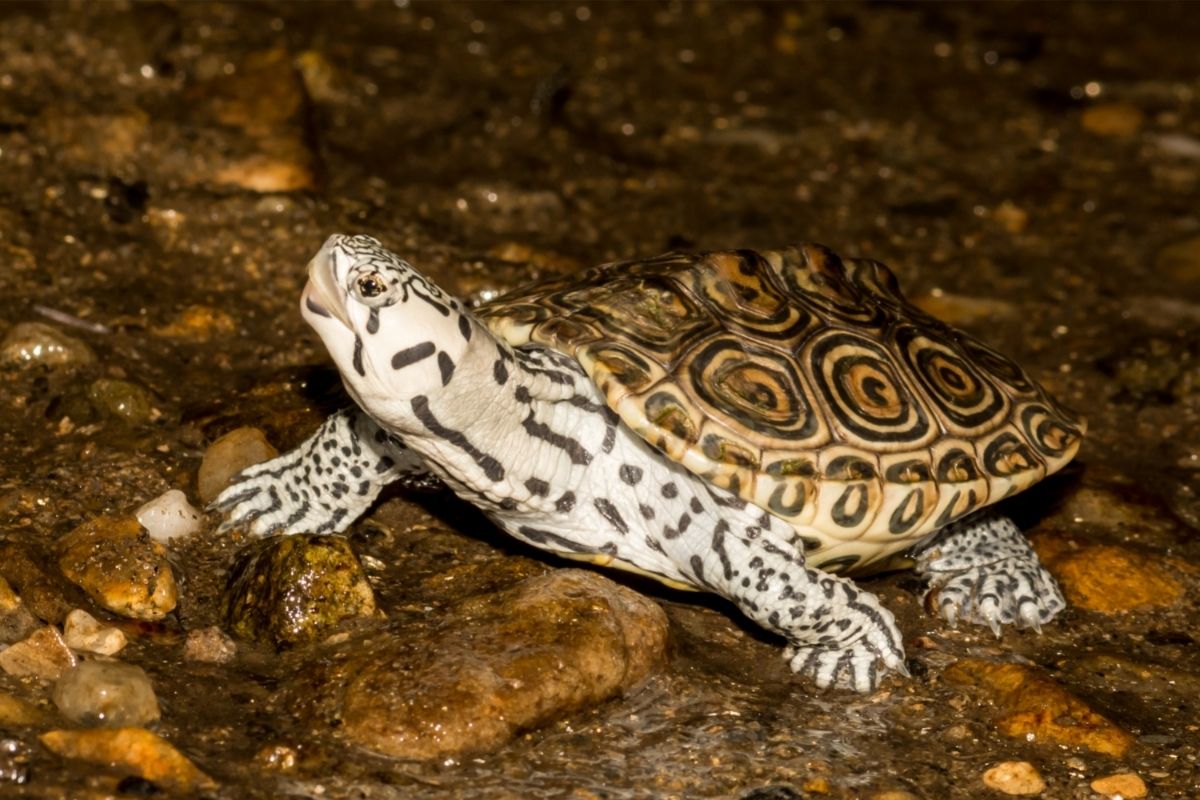
The Diamondback Terrapin is a species that can be found in brackish waters around the coast of east and south USA. They also enjoy living in marshes or swamps with murky waters. They are omnivores and therefore eat anything that they can find.
These turtles have an unusually shaped shell that looks like a diamond rather than an oval. They can be brown or black with large yellow markings. Their keels are very pronounced all down the center of their shells.
There are seven subspecies to these amazing creatures, all of which are as amazing to look at as the Diamond Terrapin.
- Family Name: Emydidae
- Genus Name: Malaclemys
- Binomial Name: Malaclemys Terrapin
- Otherwise Known As: Not Known
- Aquatic? Yes
- Maximum Size: Between 5 and 8 Inches
- Average Lifespan: Between 25 and 40 years
- Found In The Following States: Alabama, Connecticut, Delaware, Florida, Georgia, Louisiana, Maryland, Massachusetts, Mississippi, New Jersey, New York, North Carolina, Rhode Island, South Carolina, Texas, Virginia
Summary
We hope you enjoyed this list! We bet you thought that you’d never reach the end, but we made it! Now you know more about 79 amazing species of turtle – do with that information what you will.
